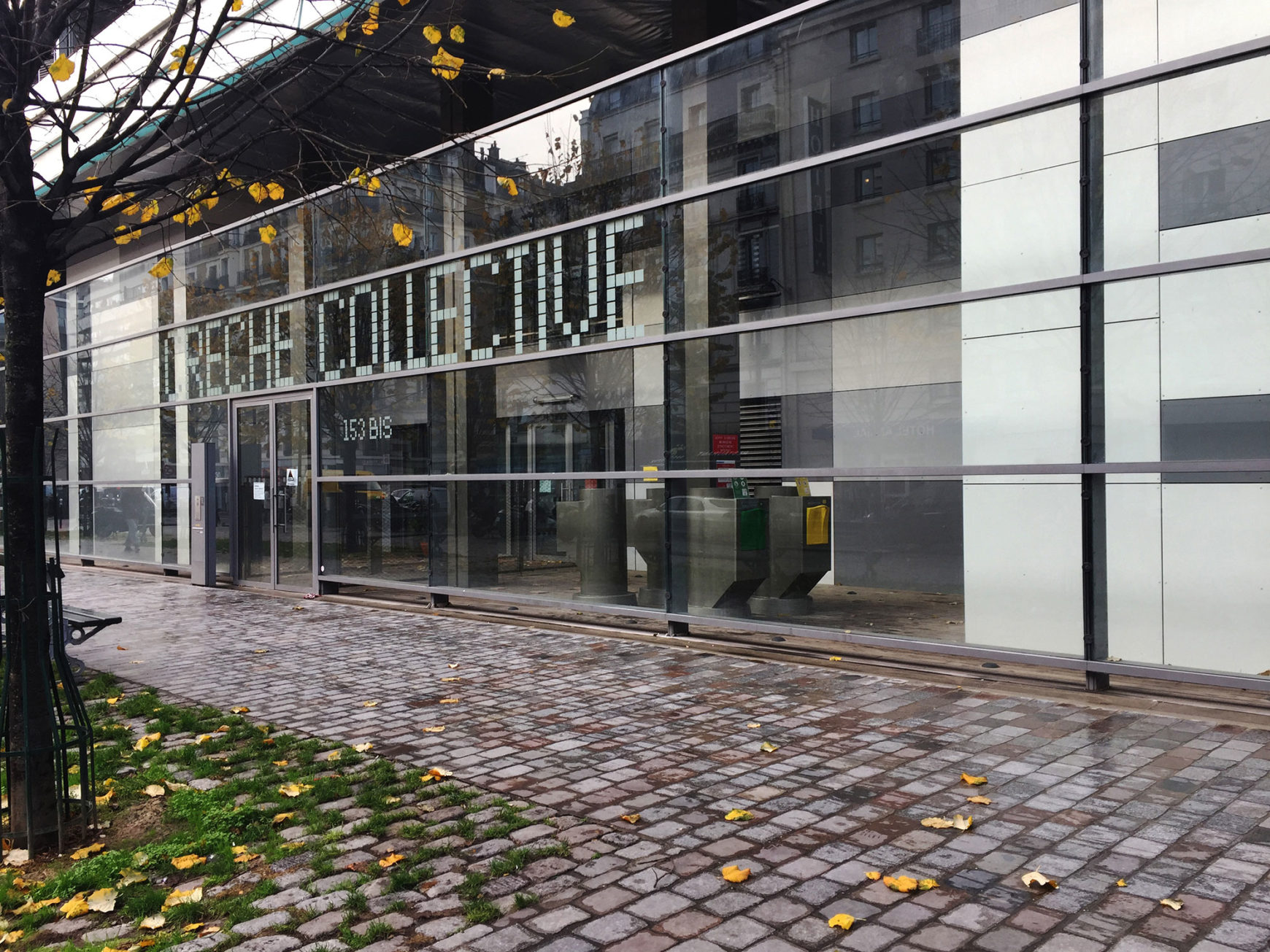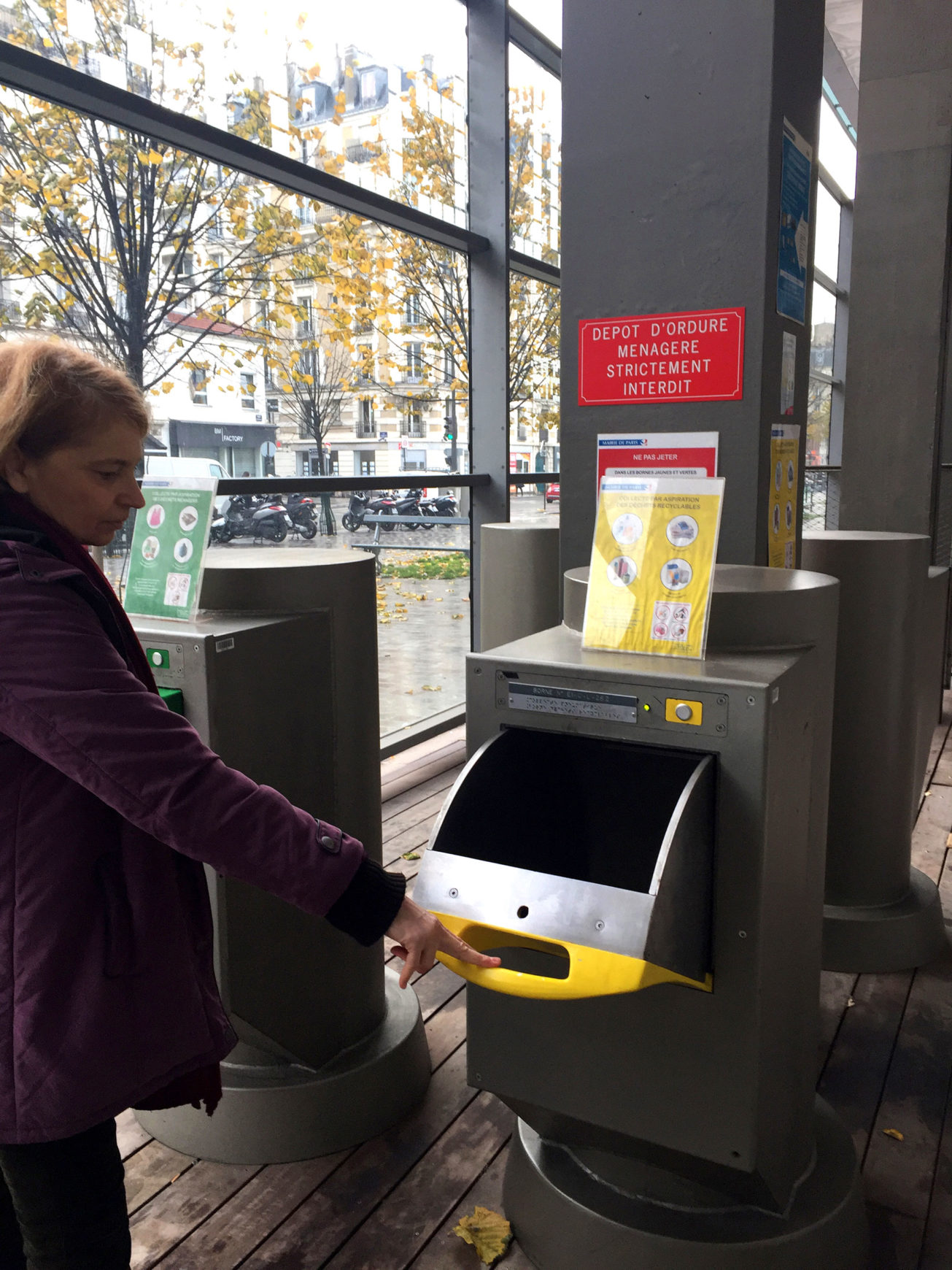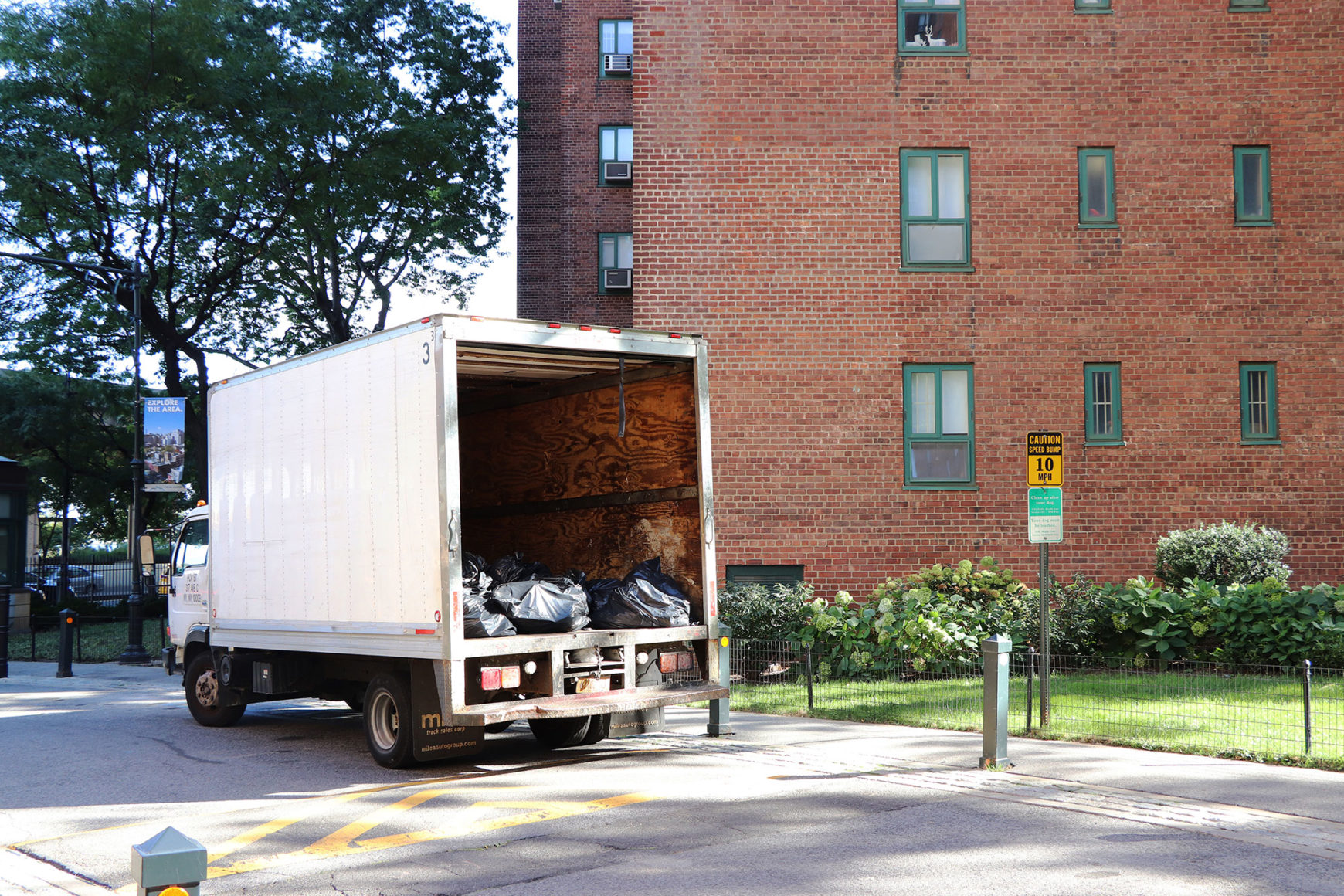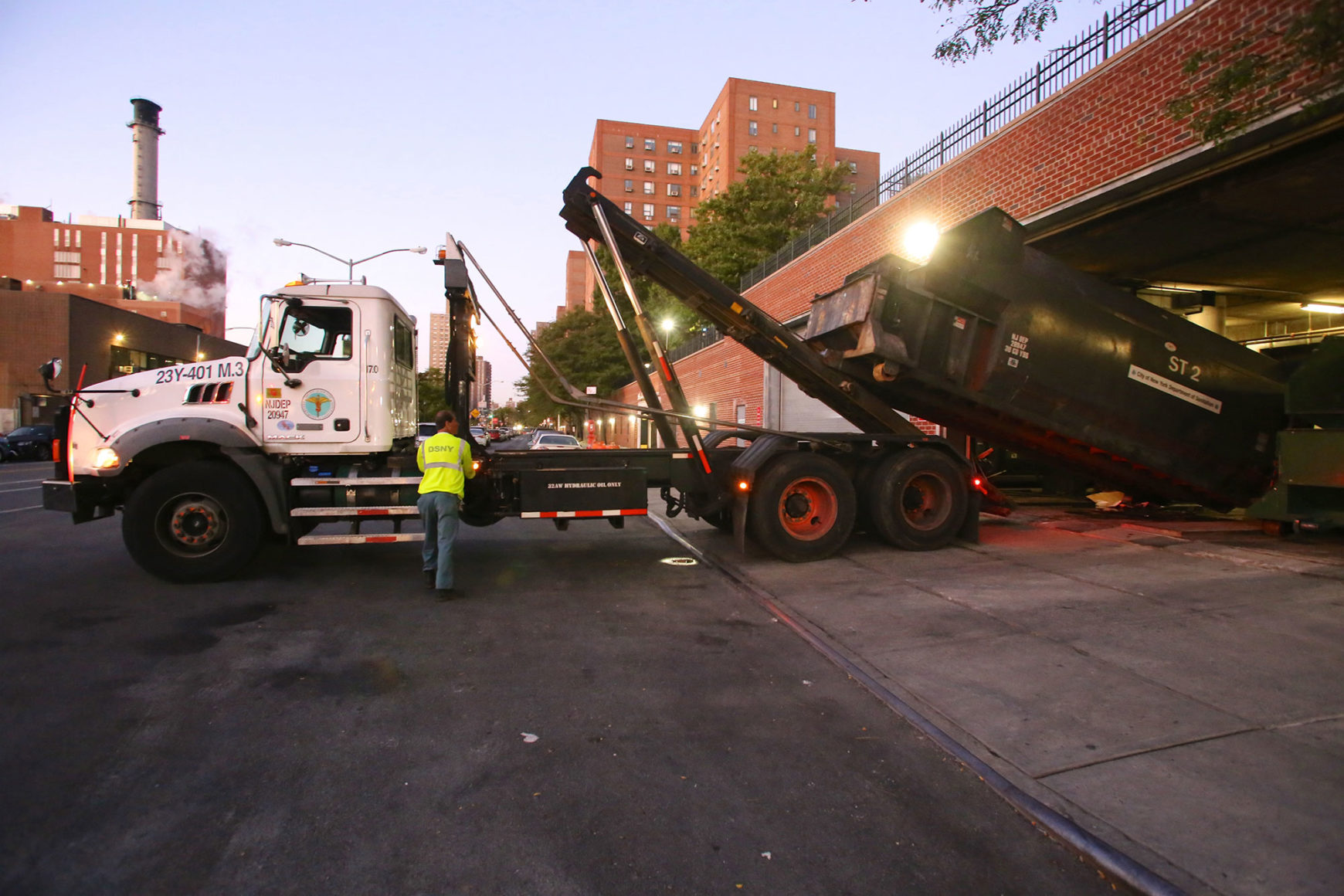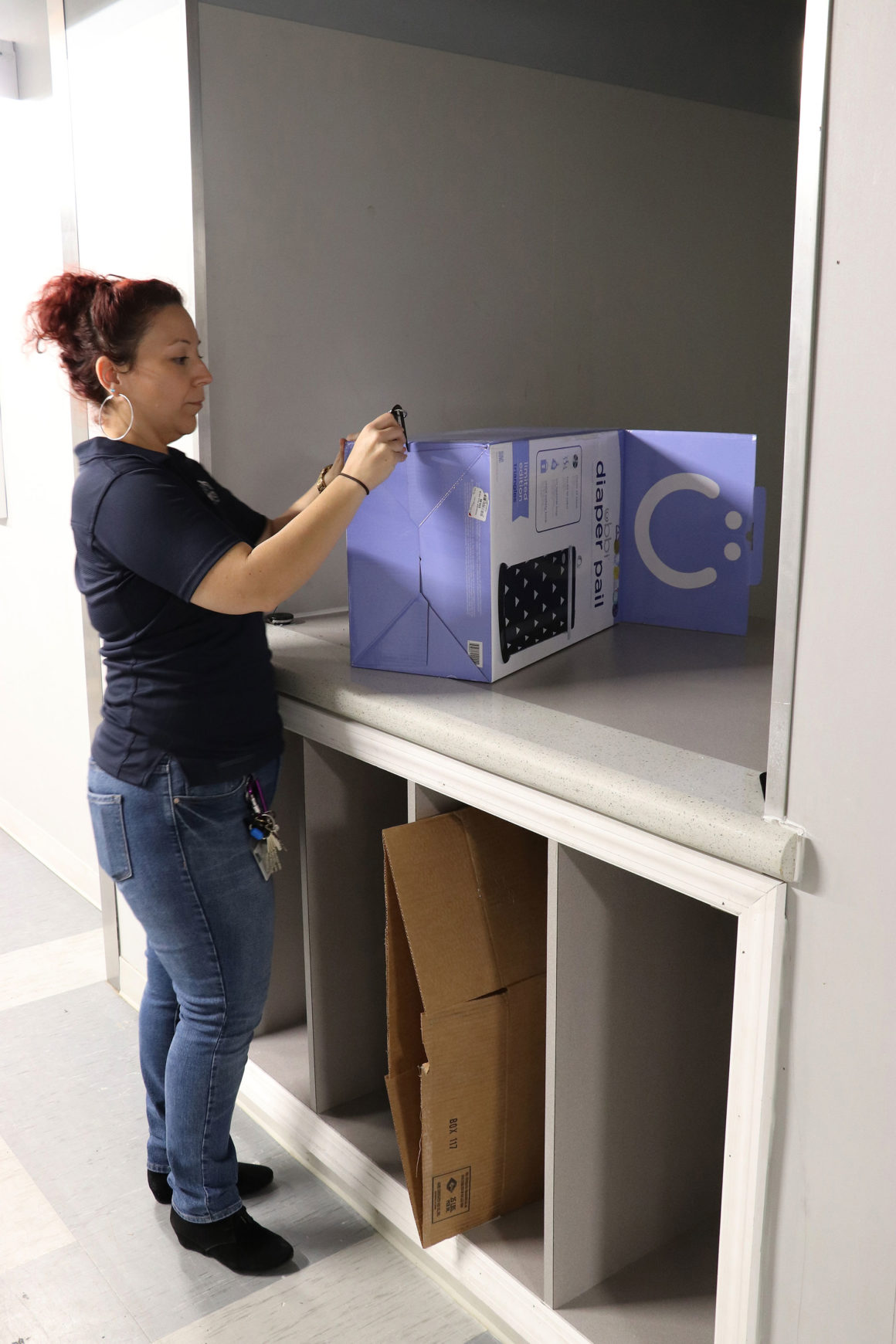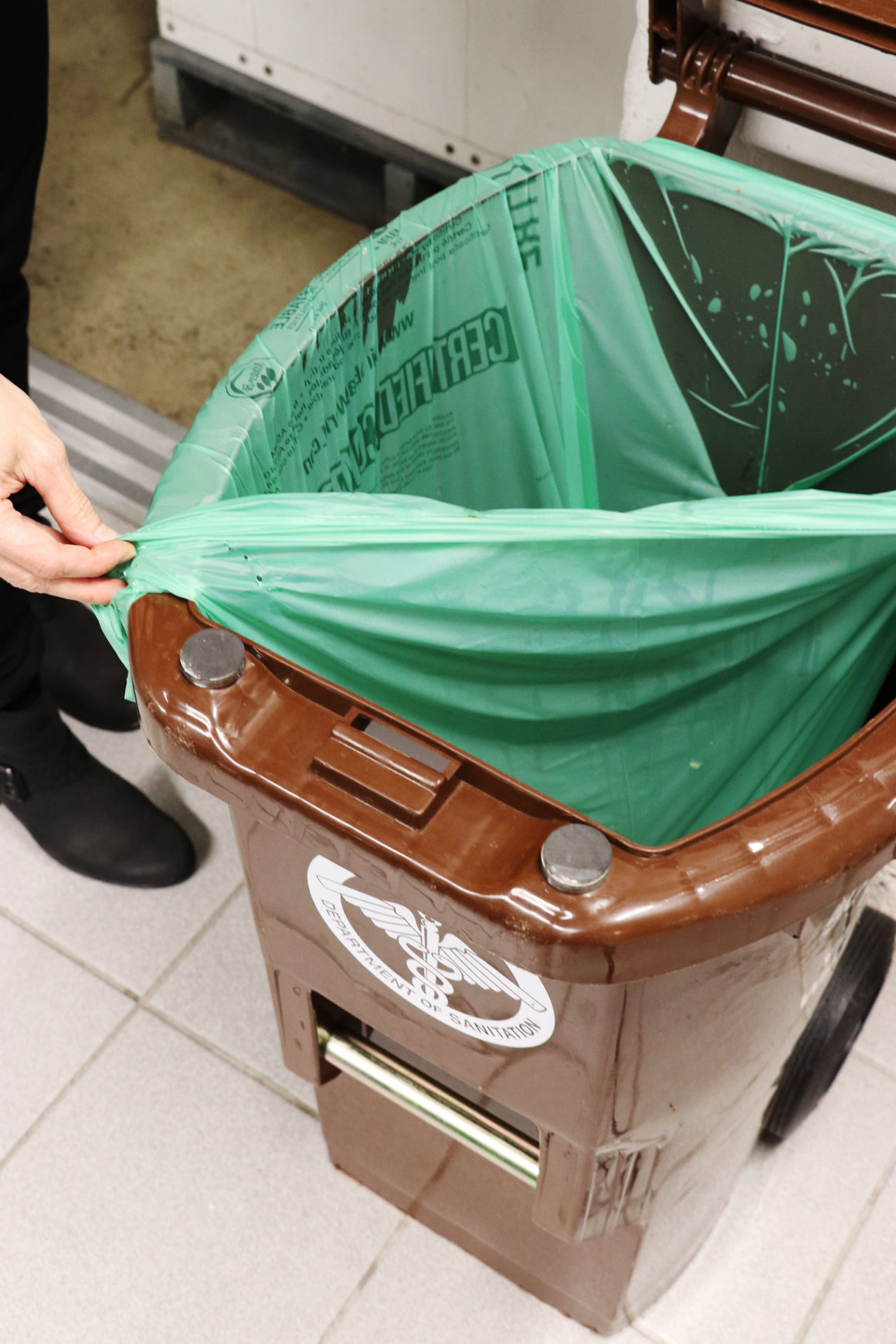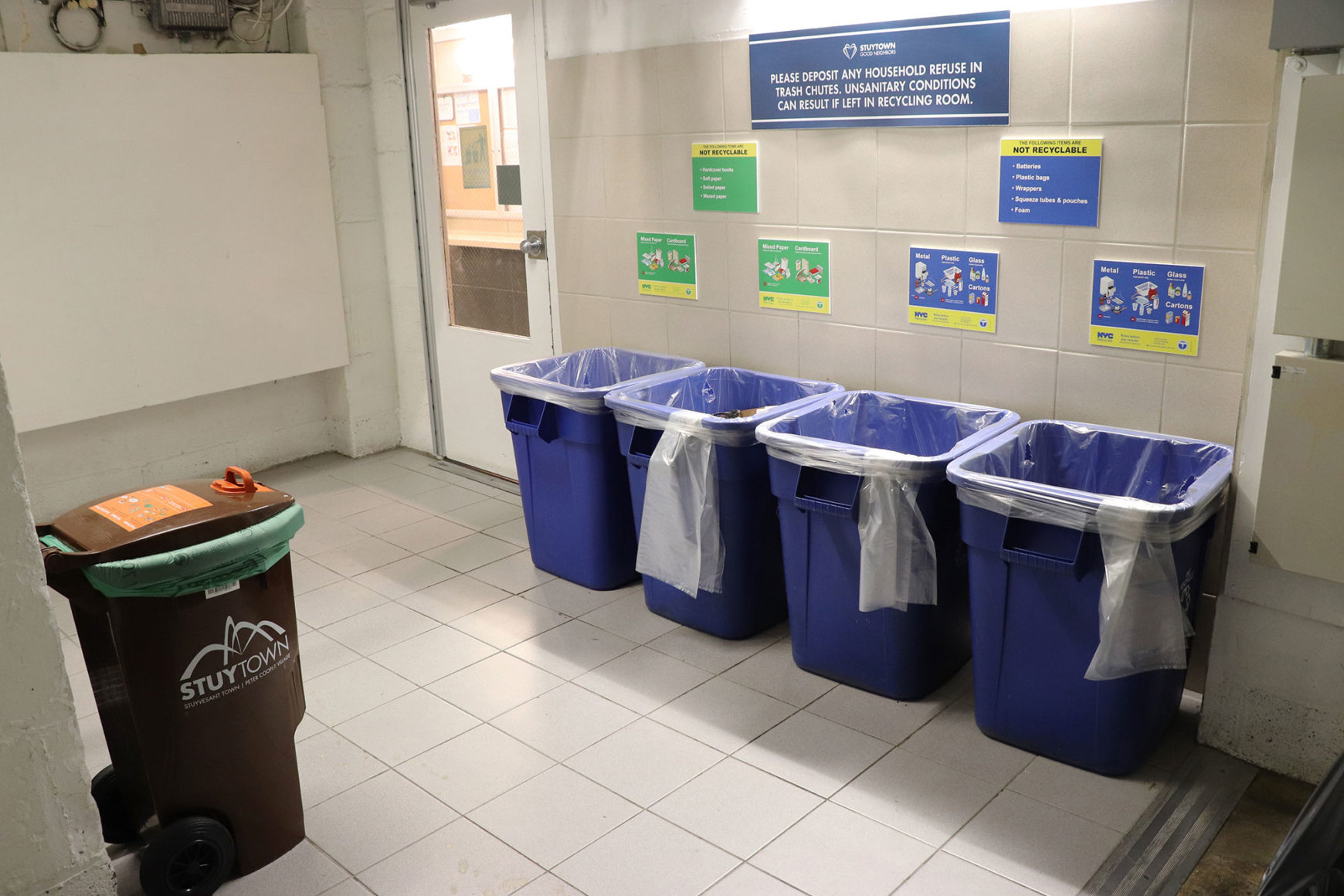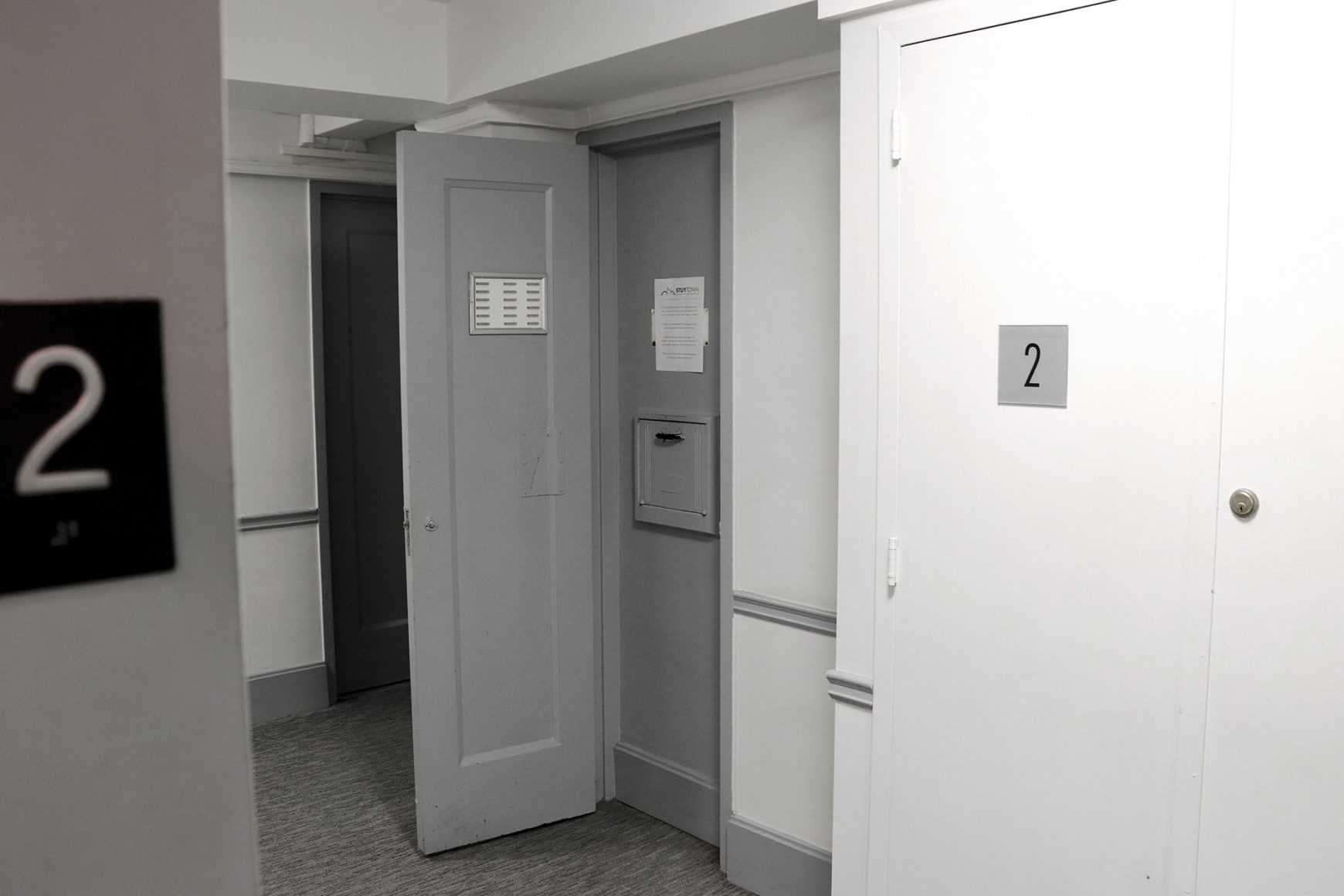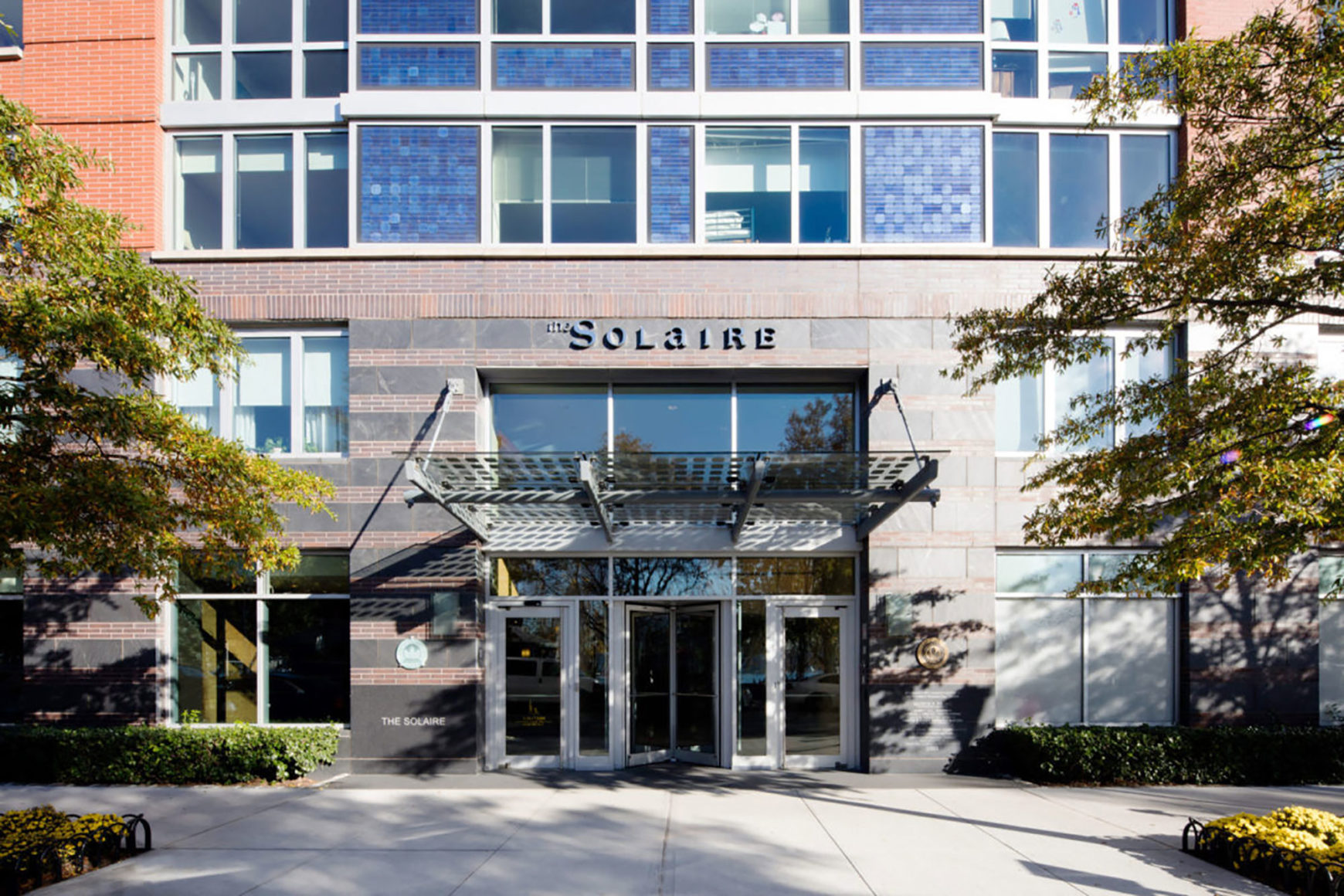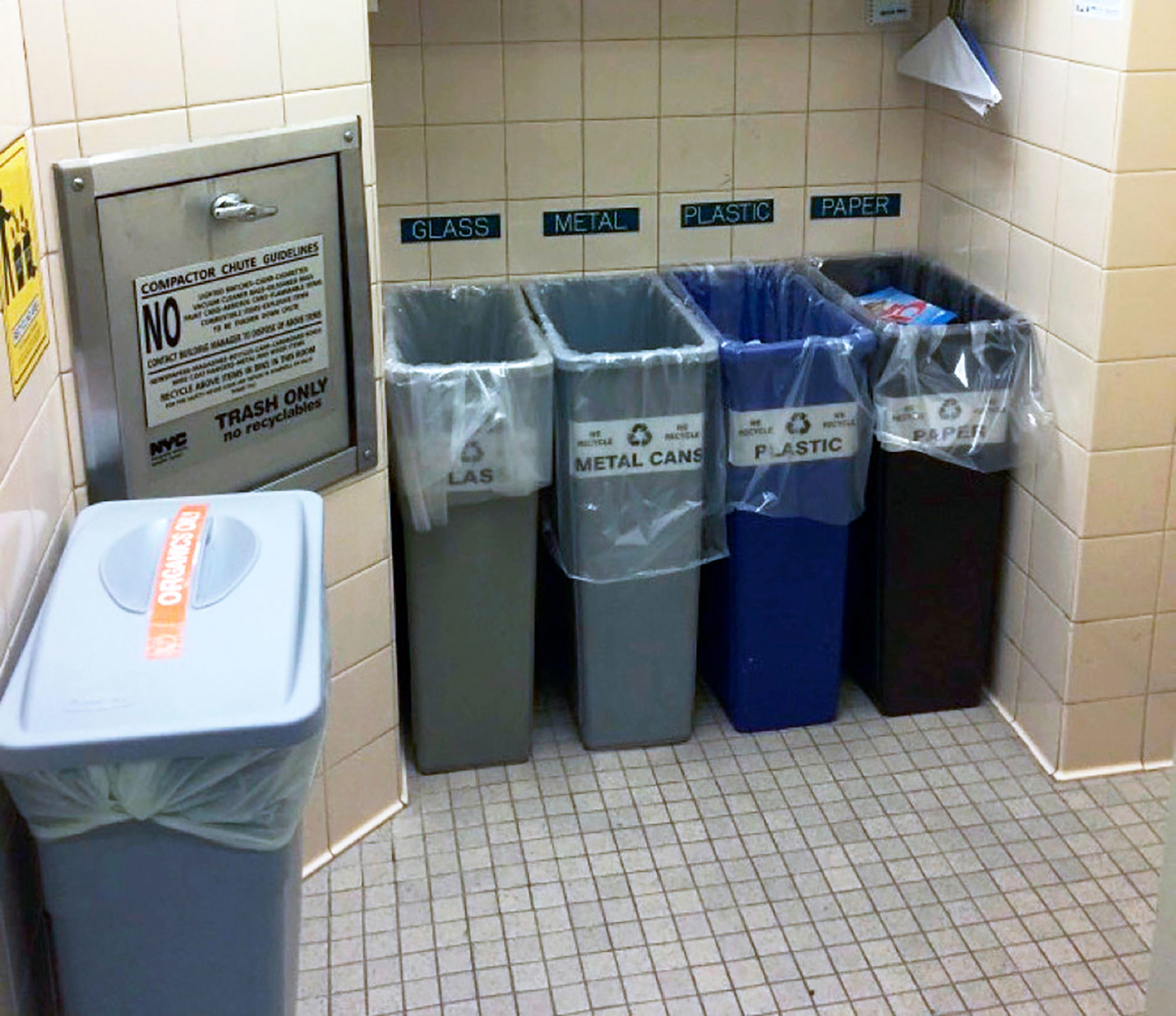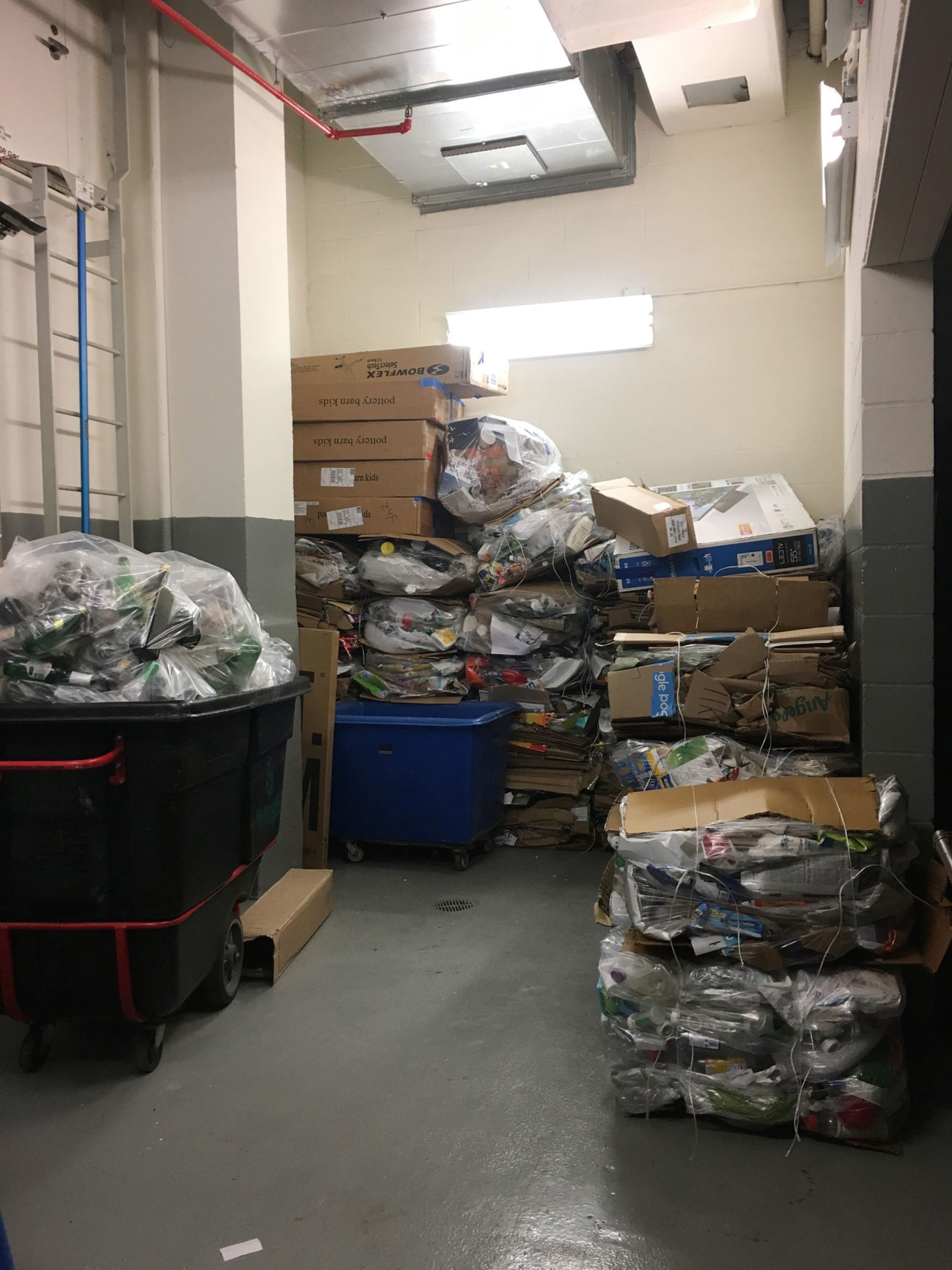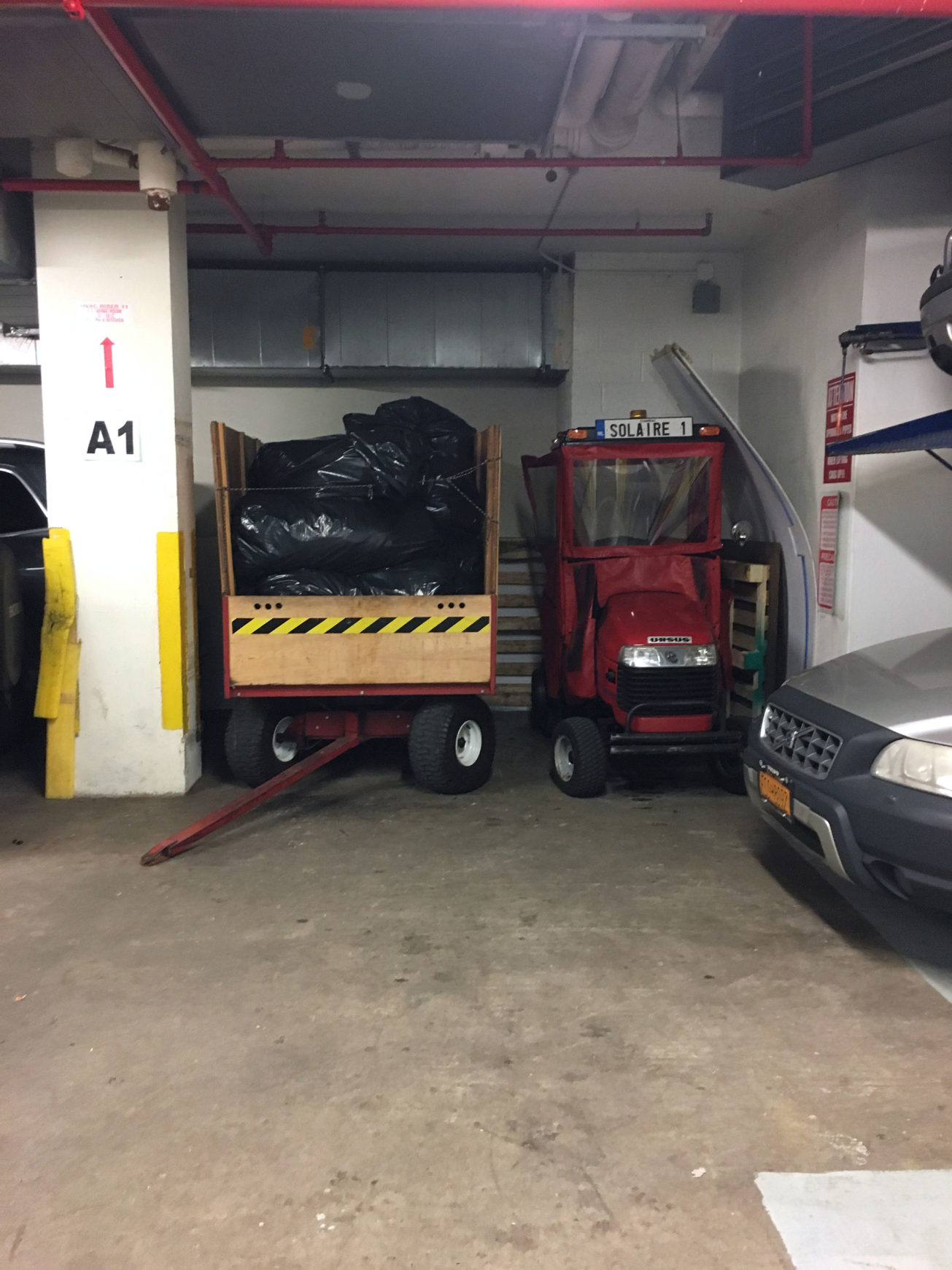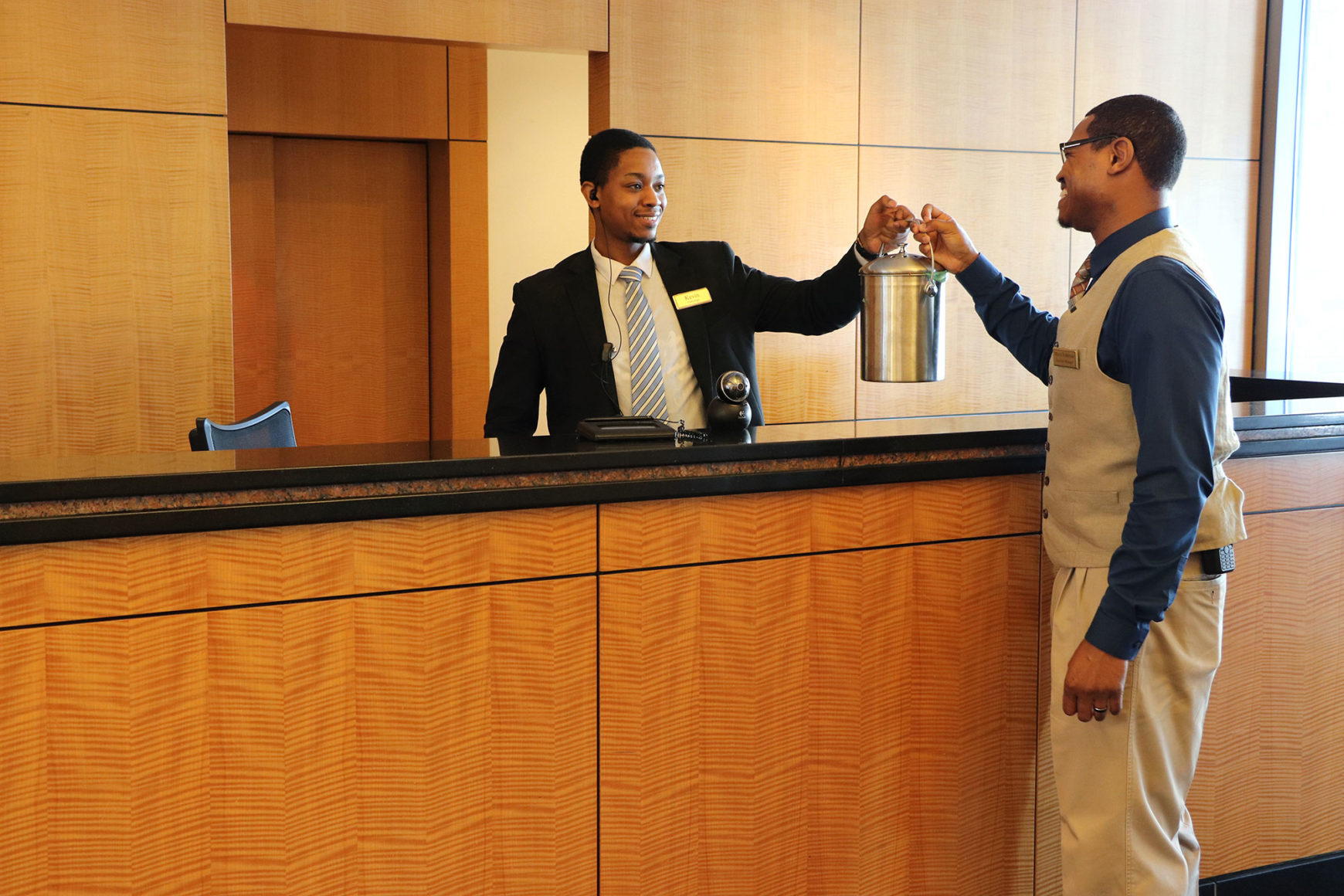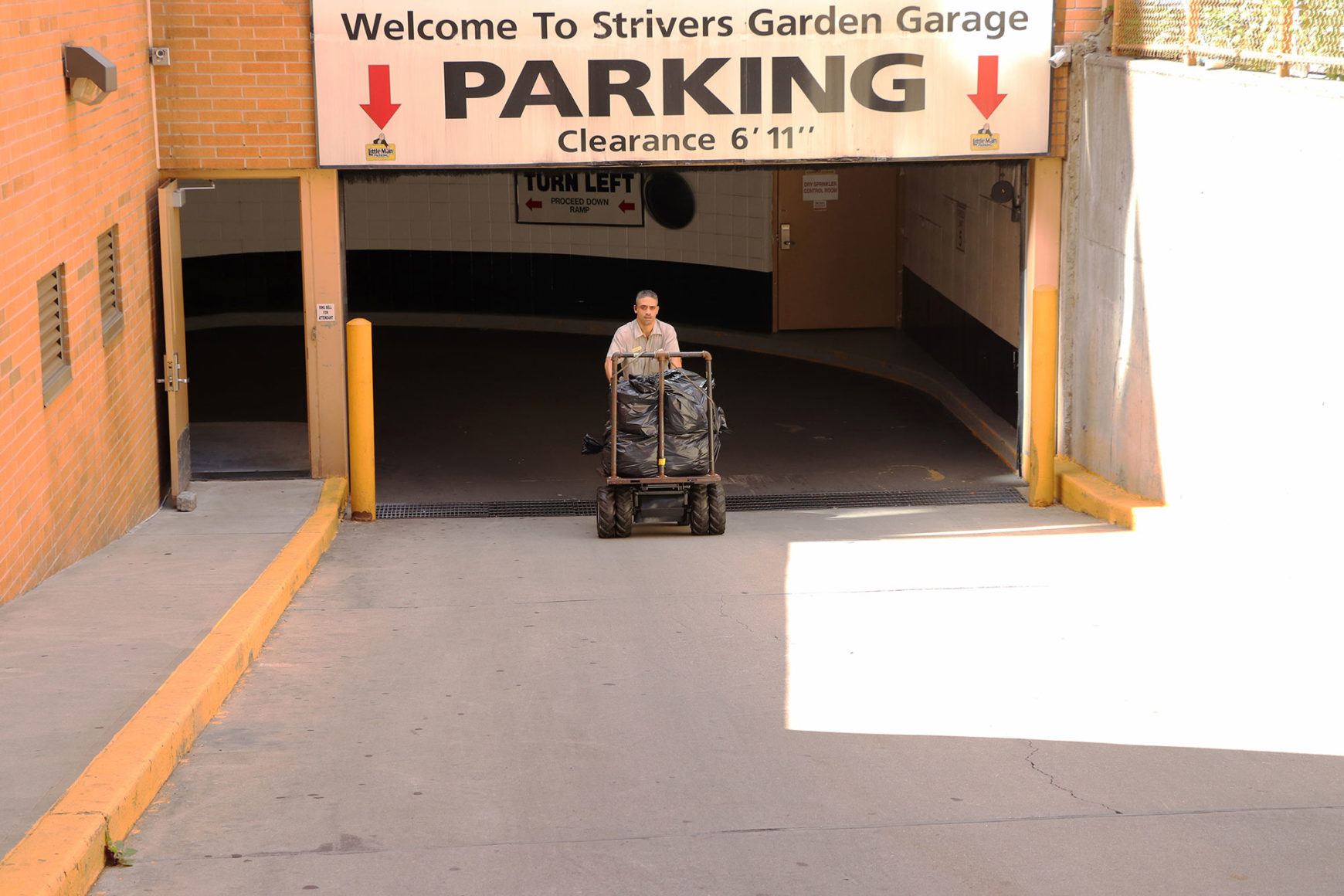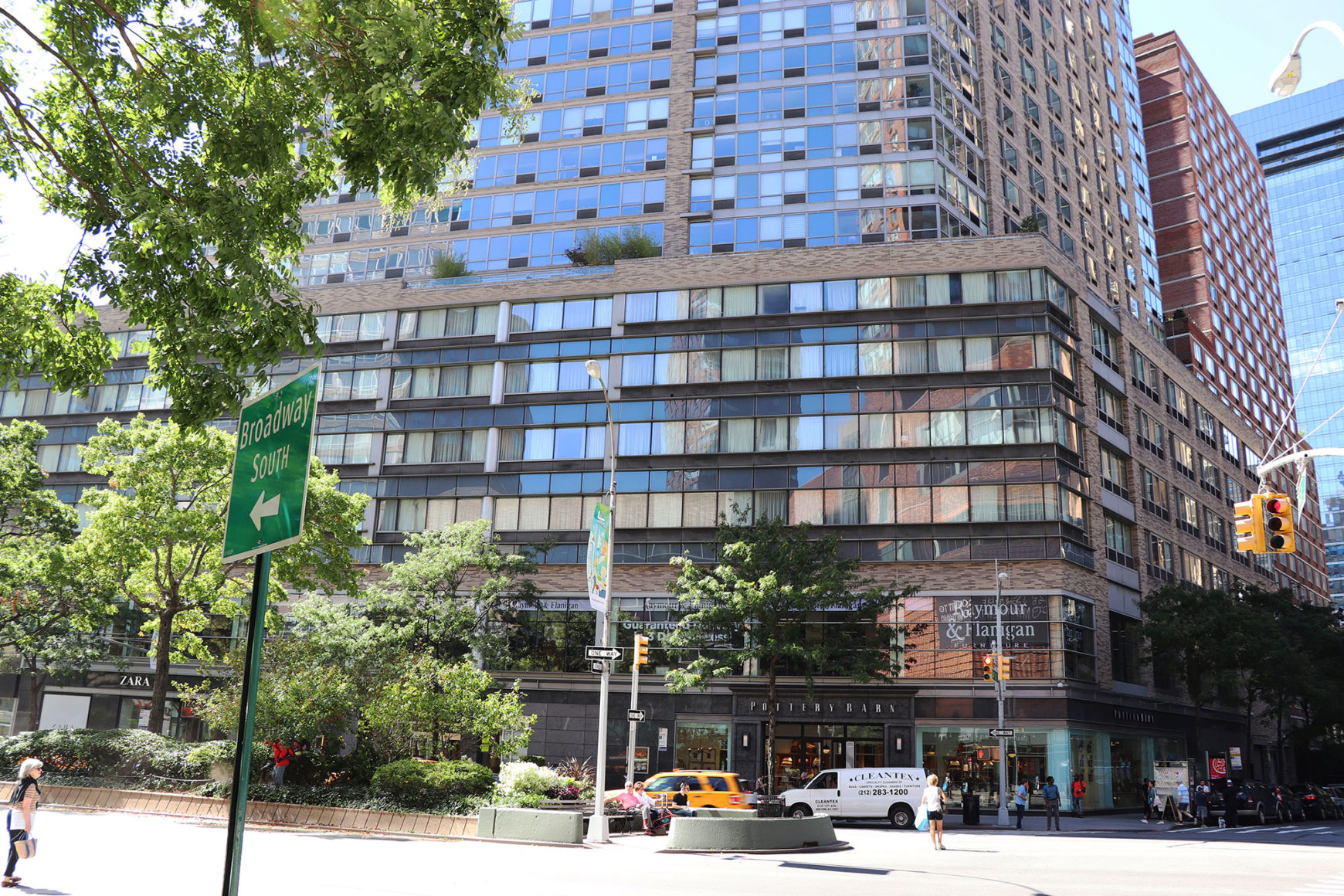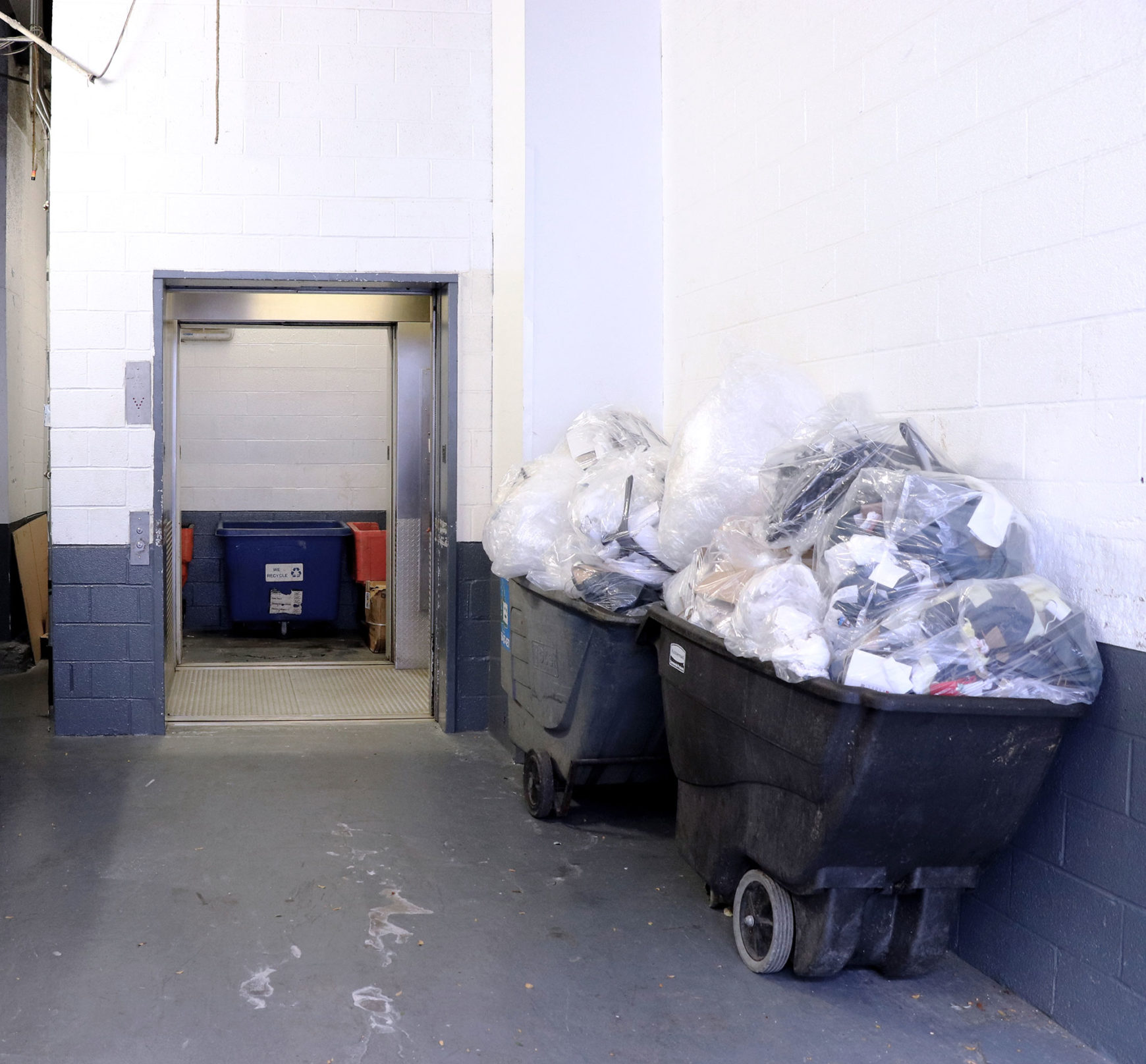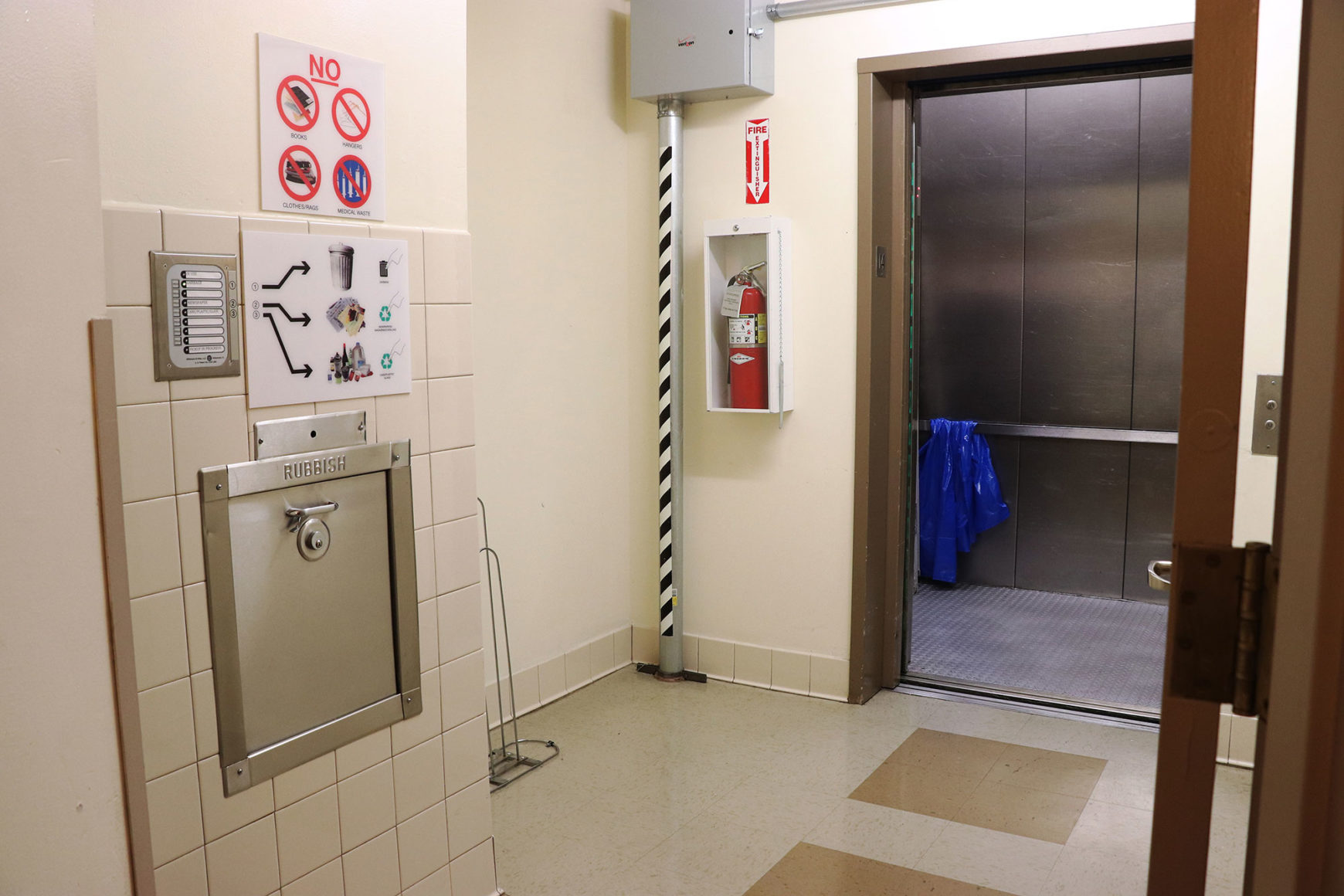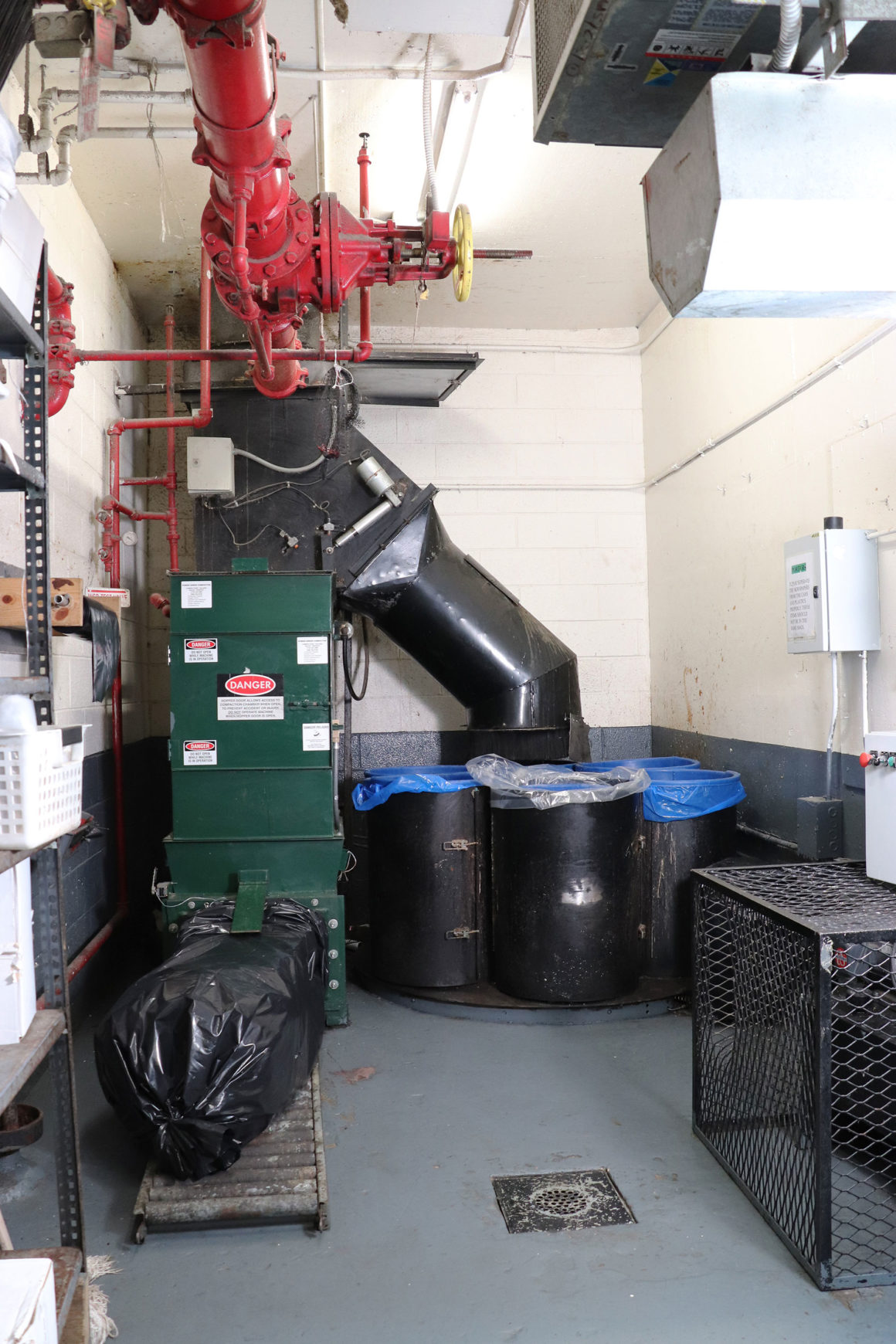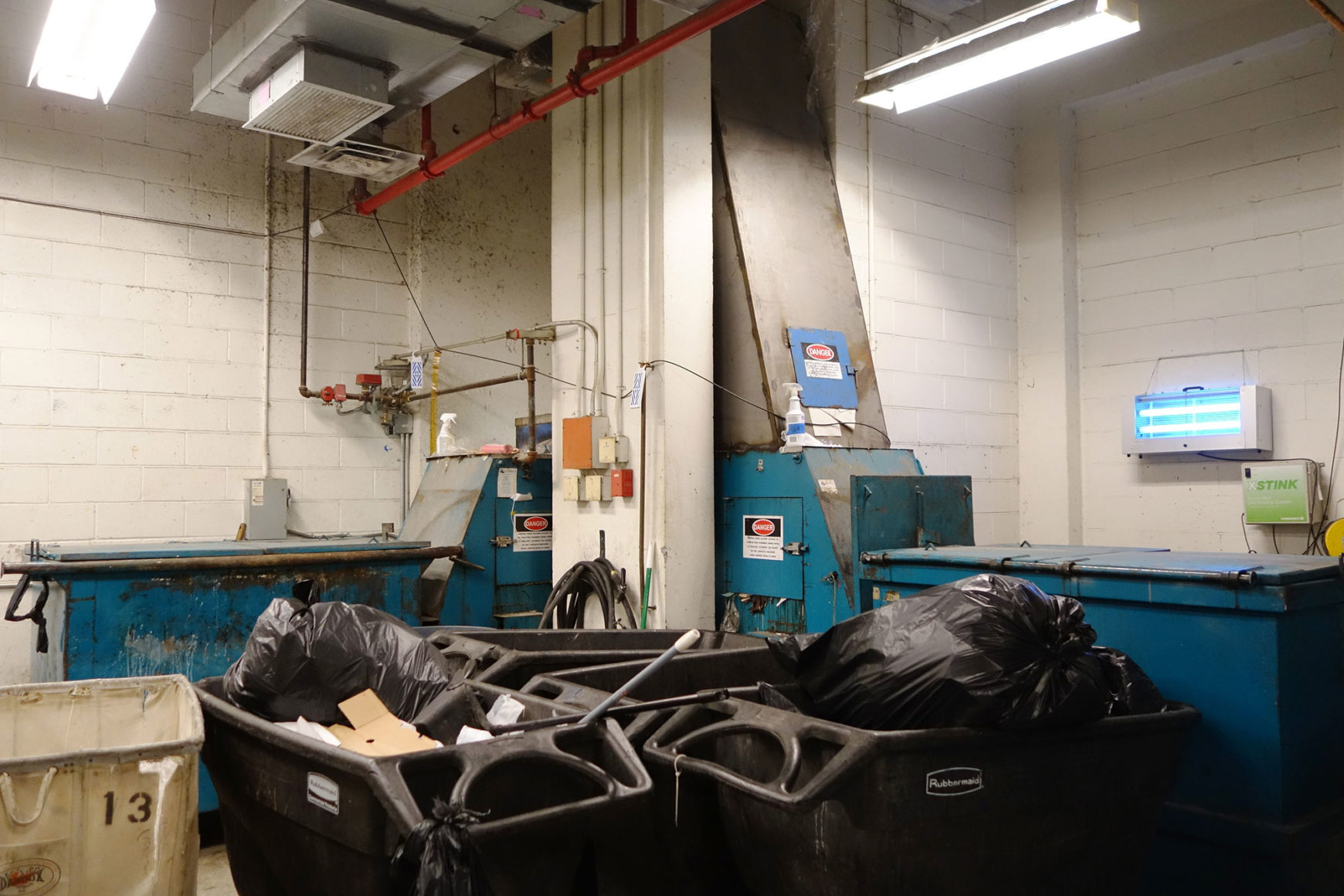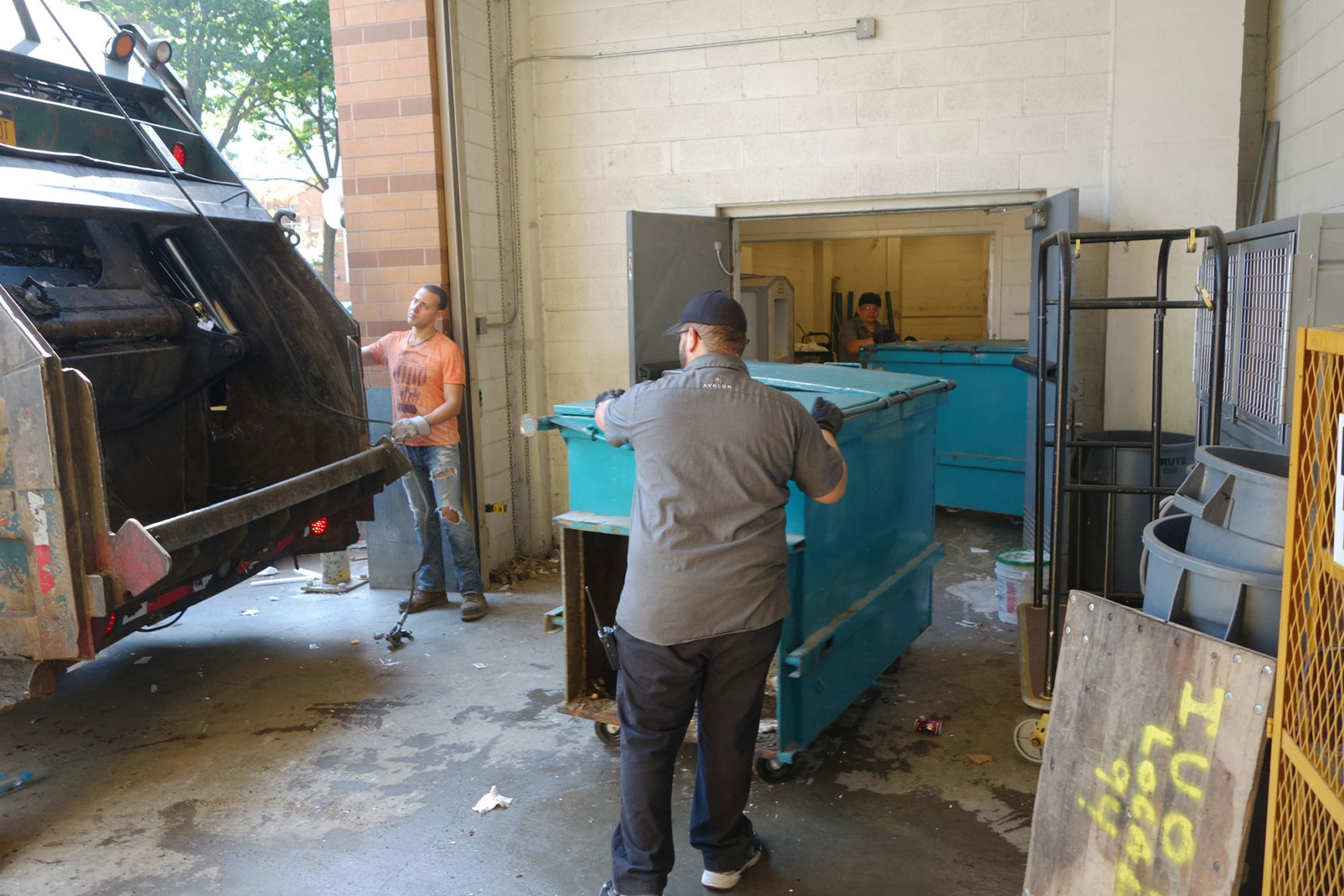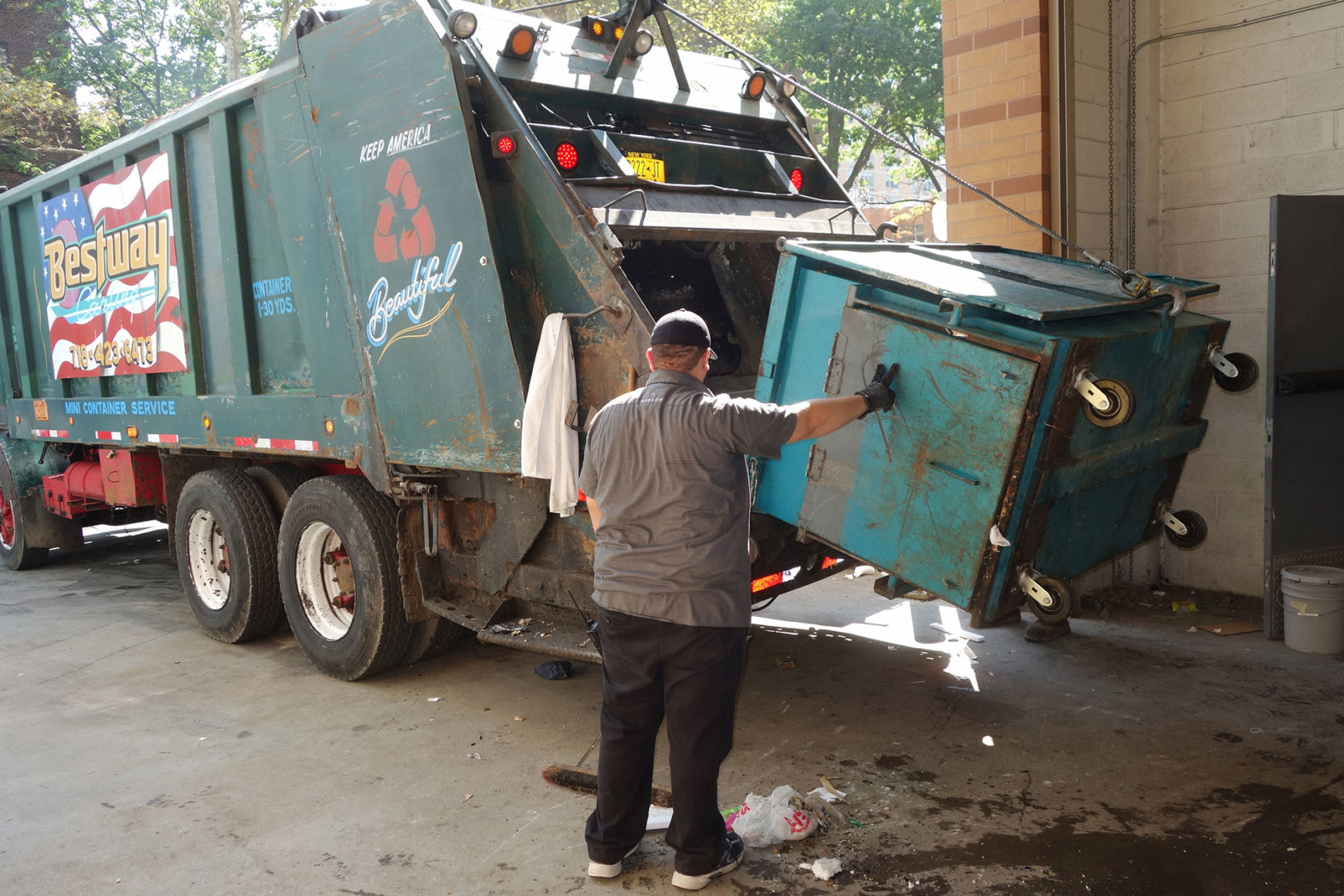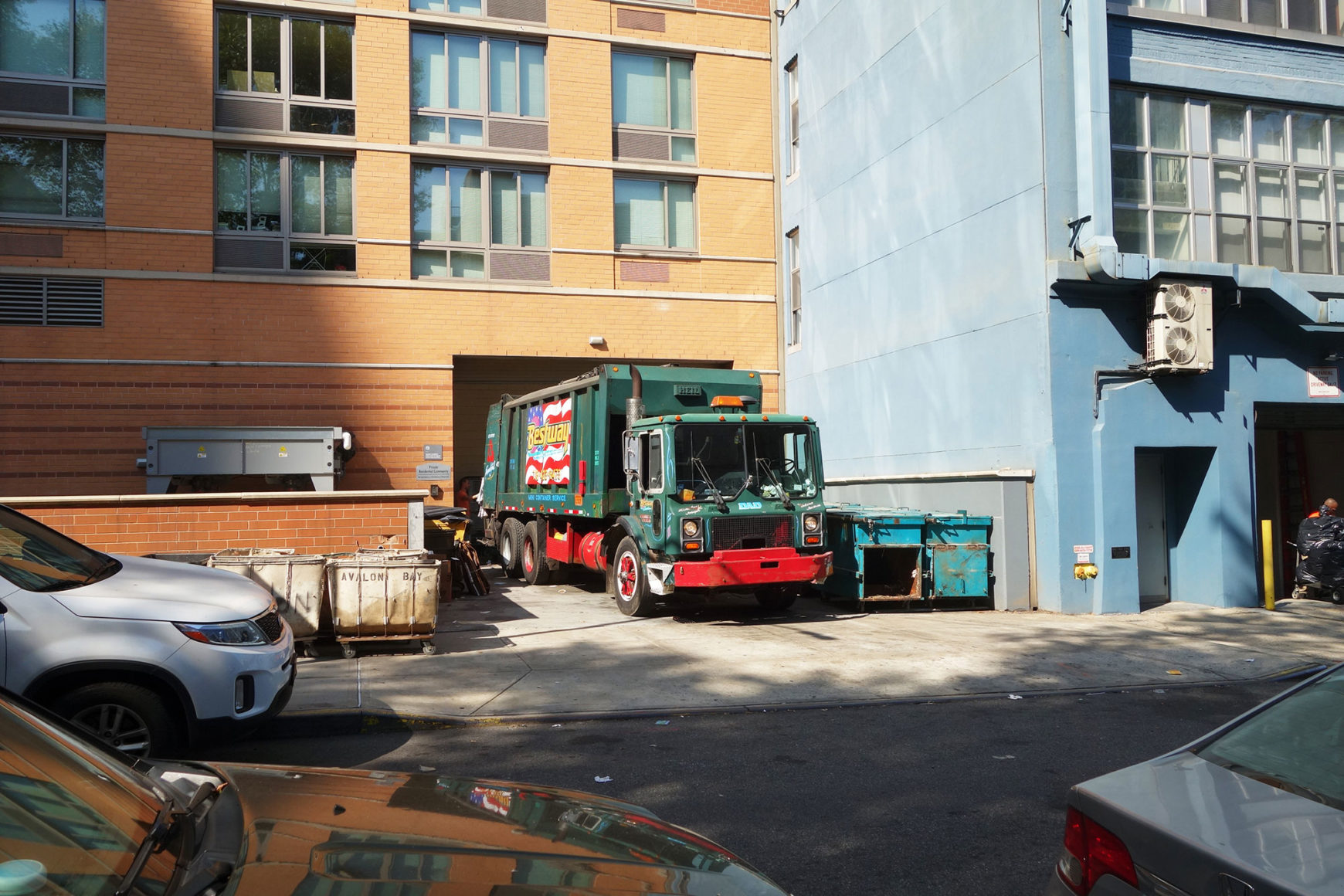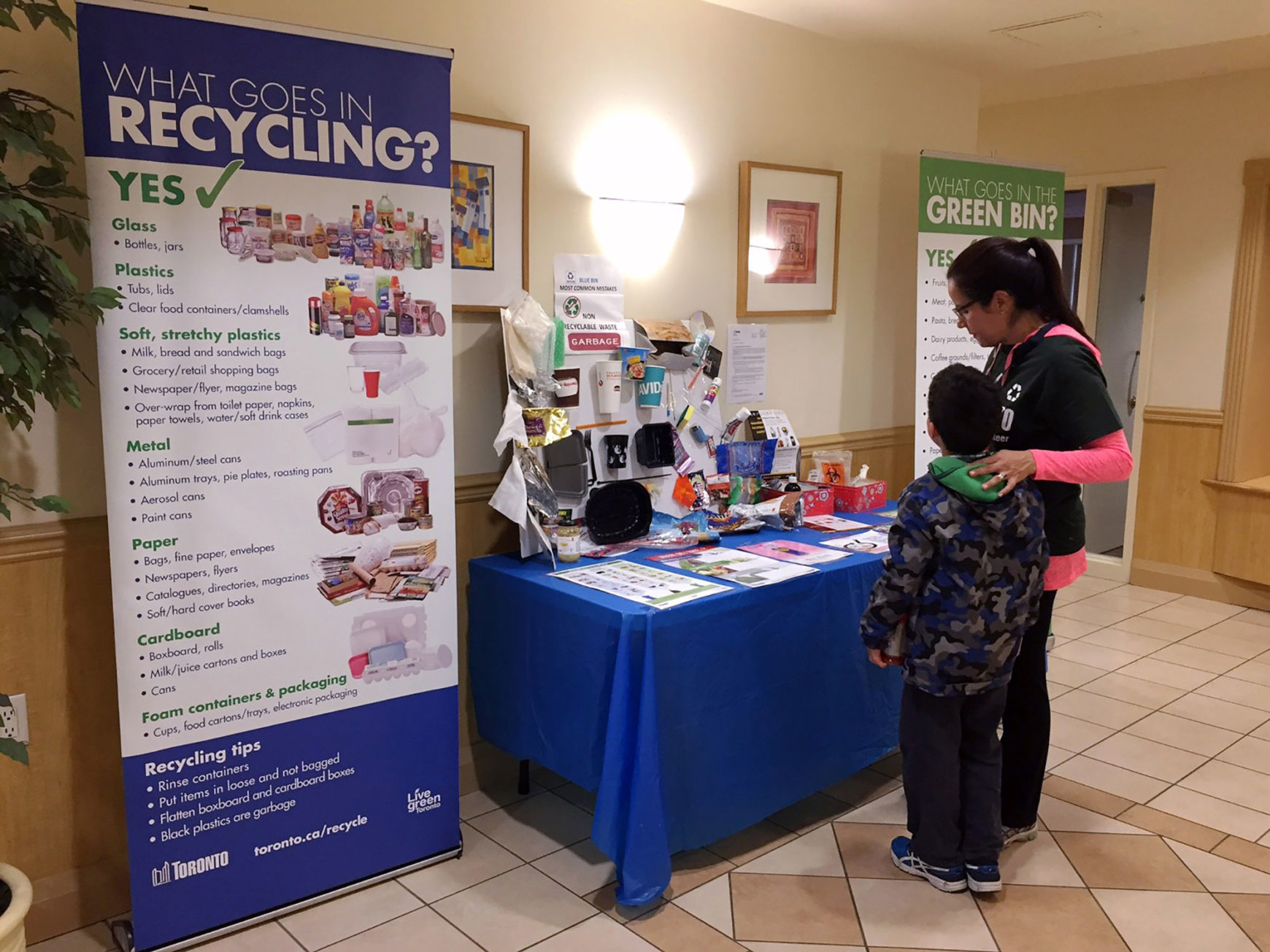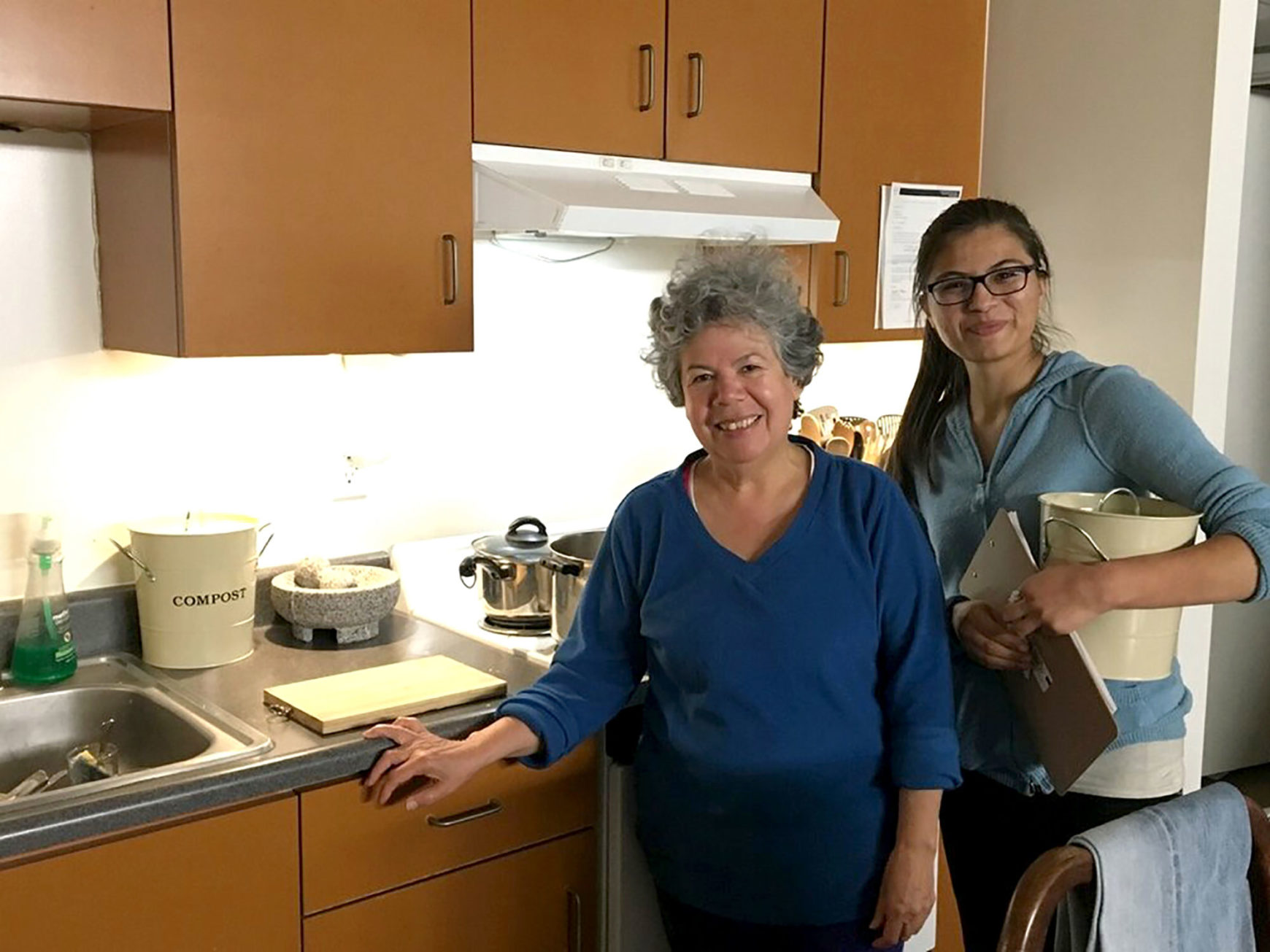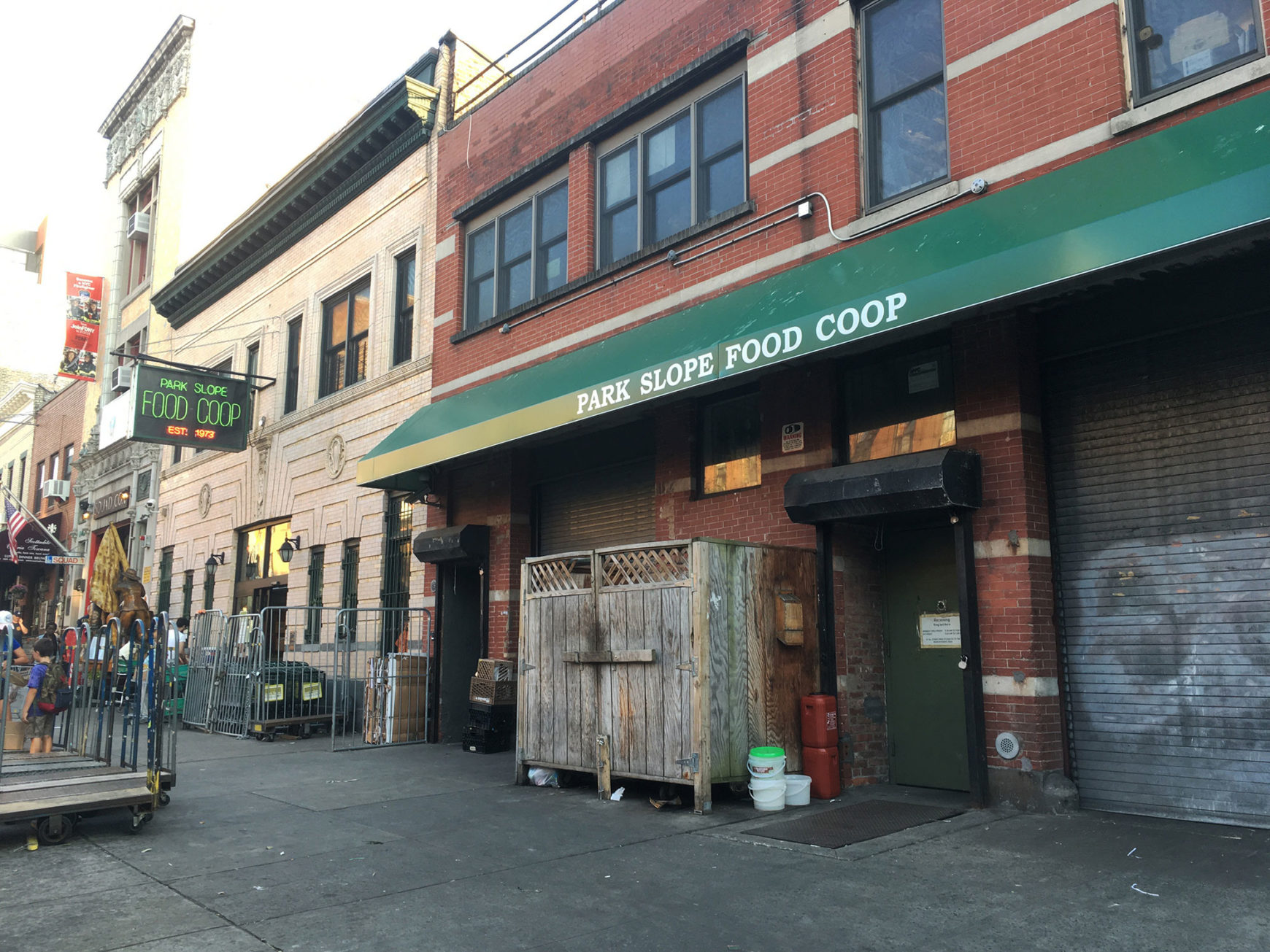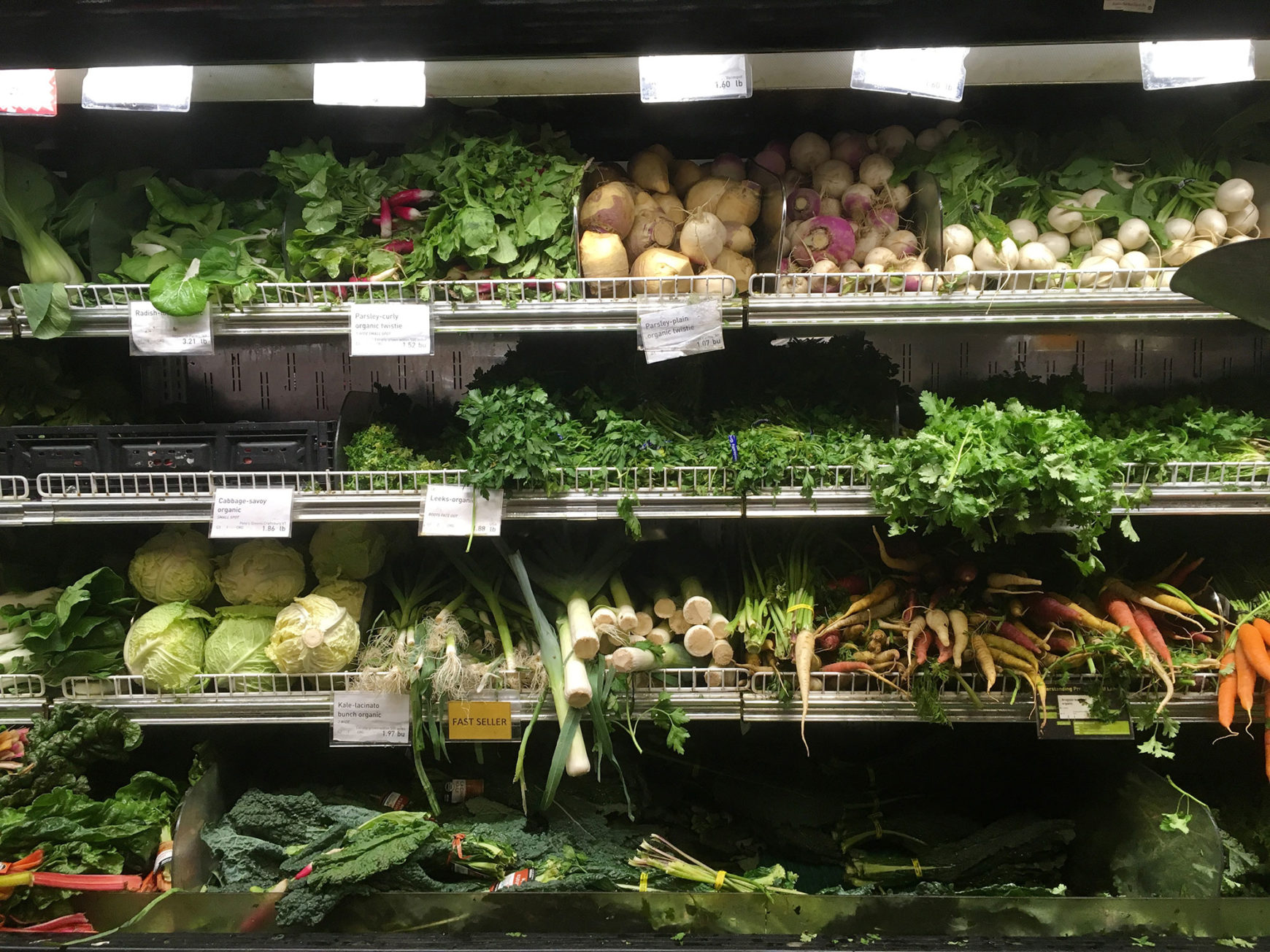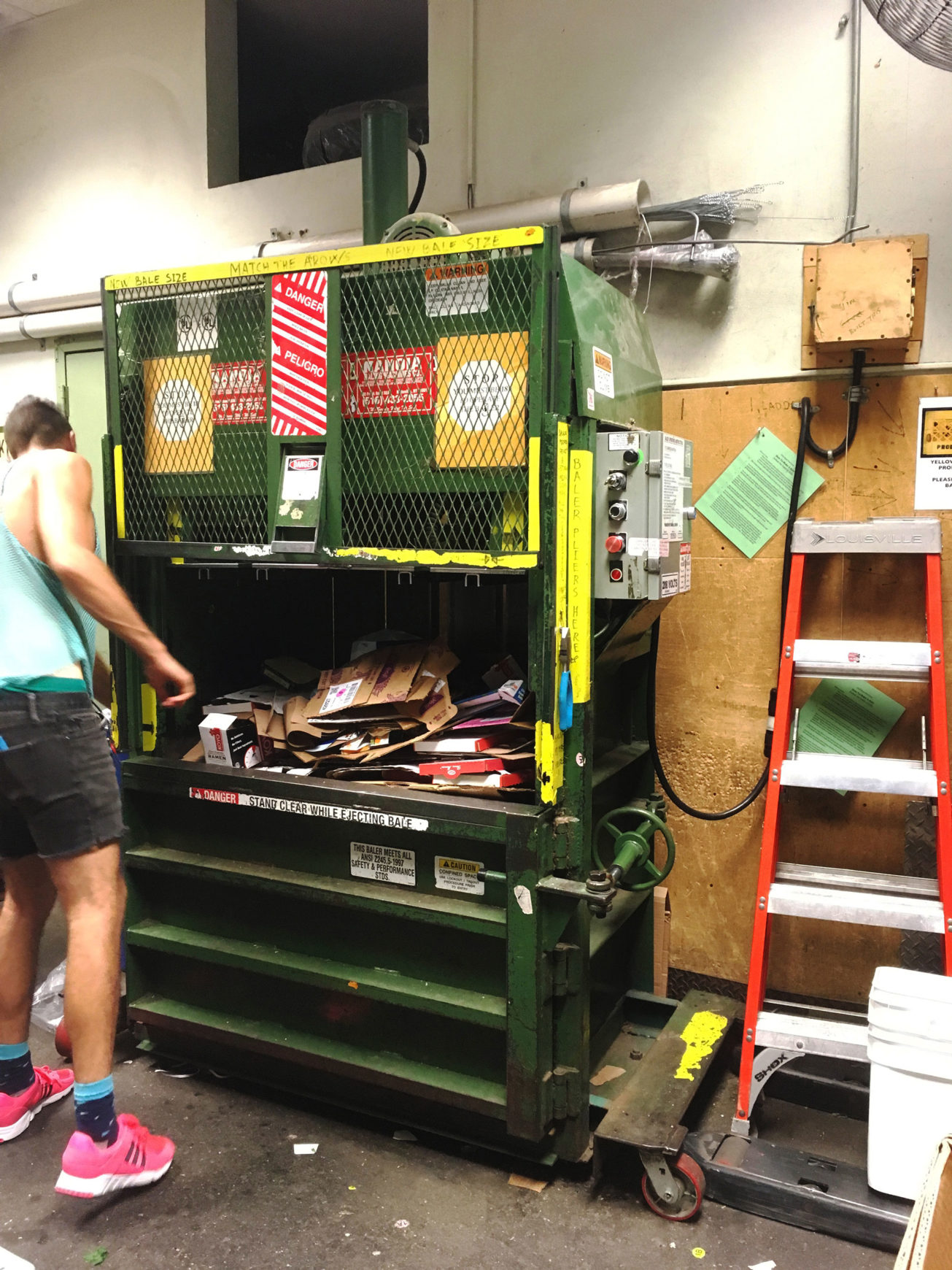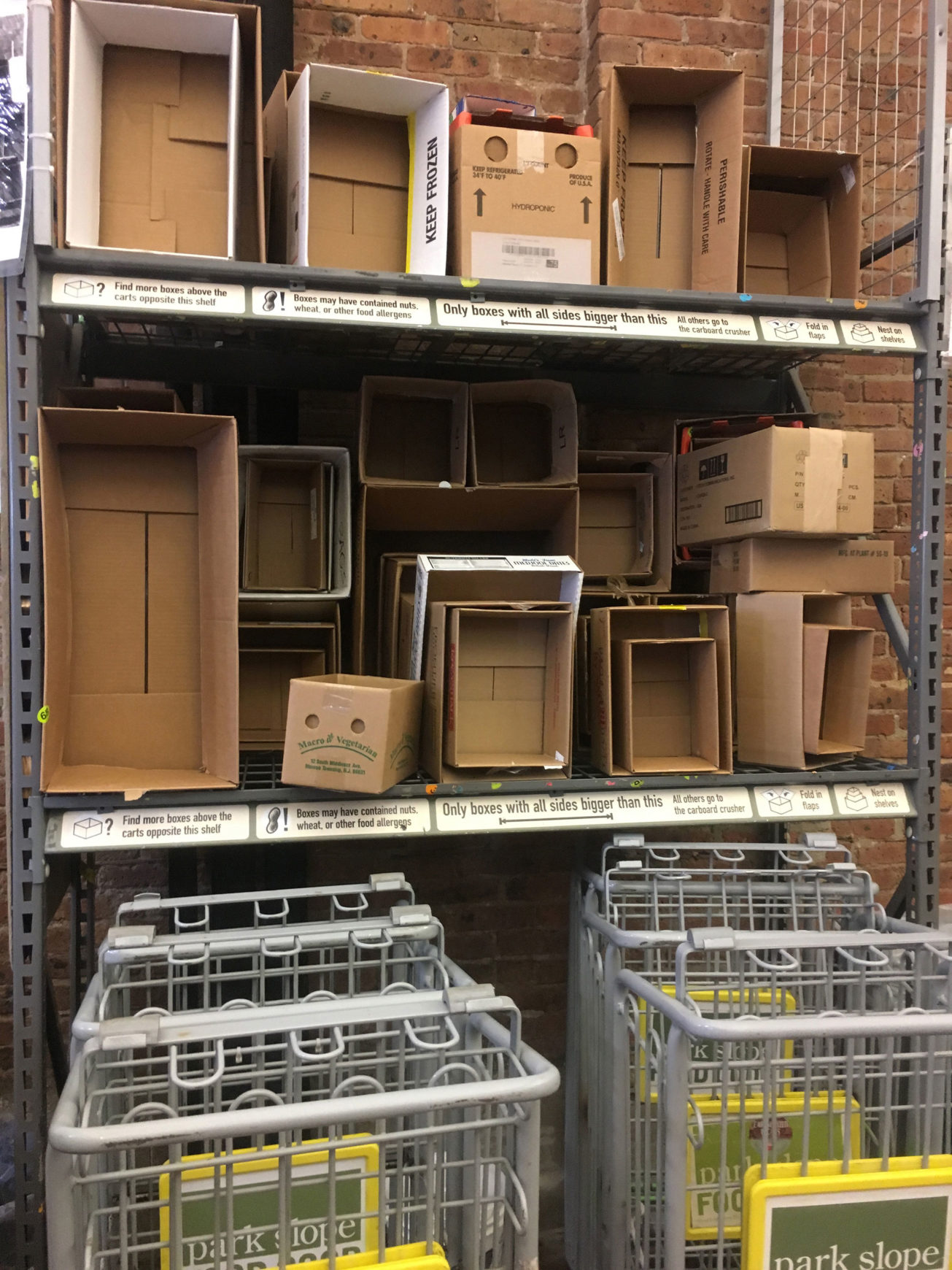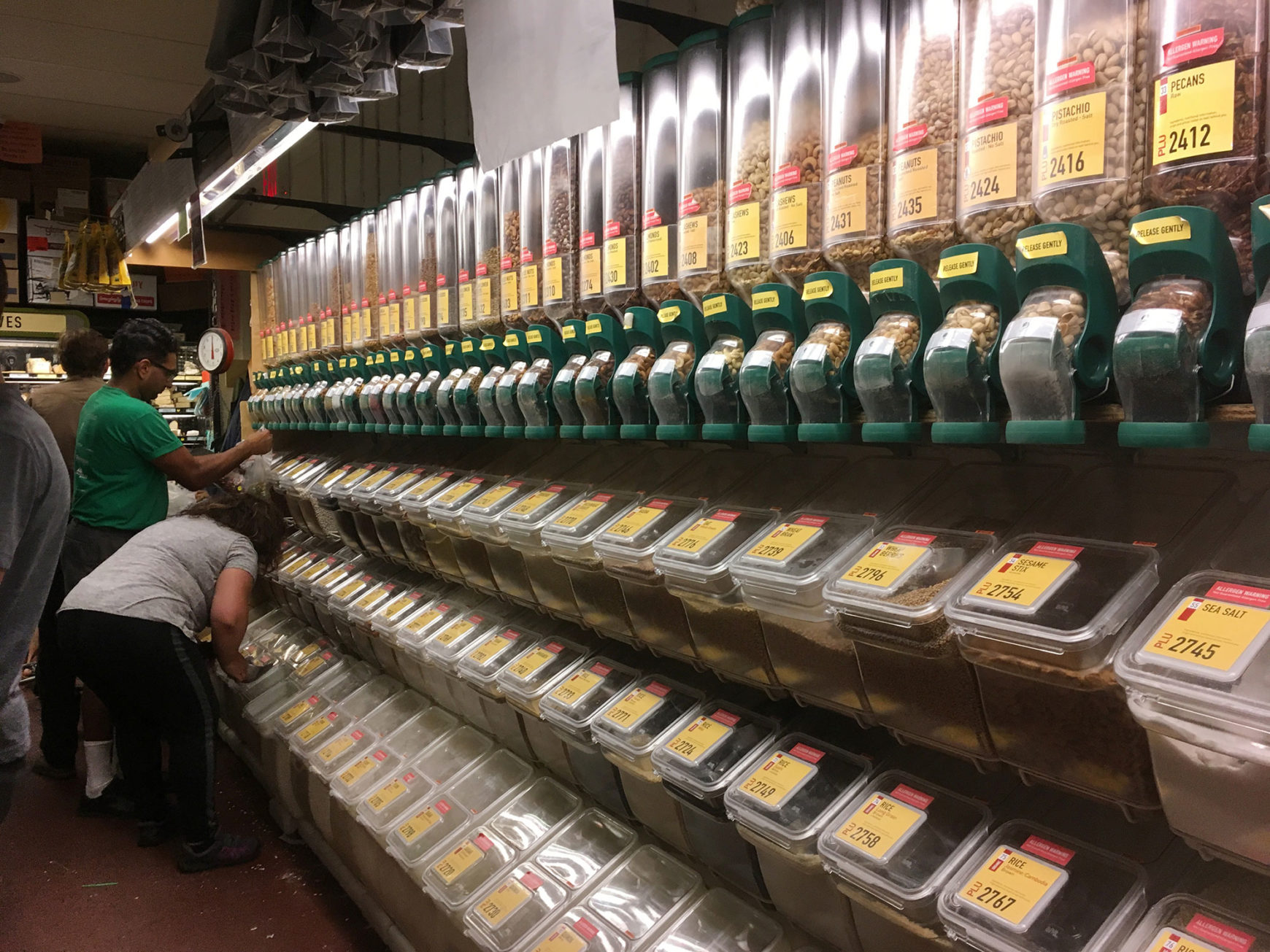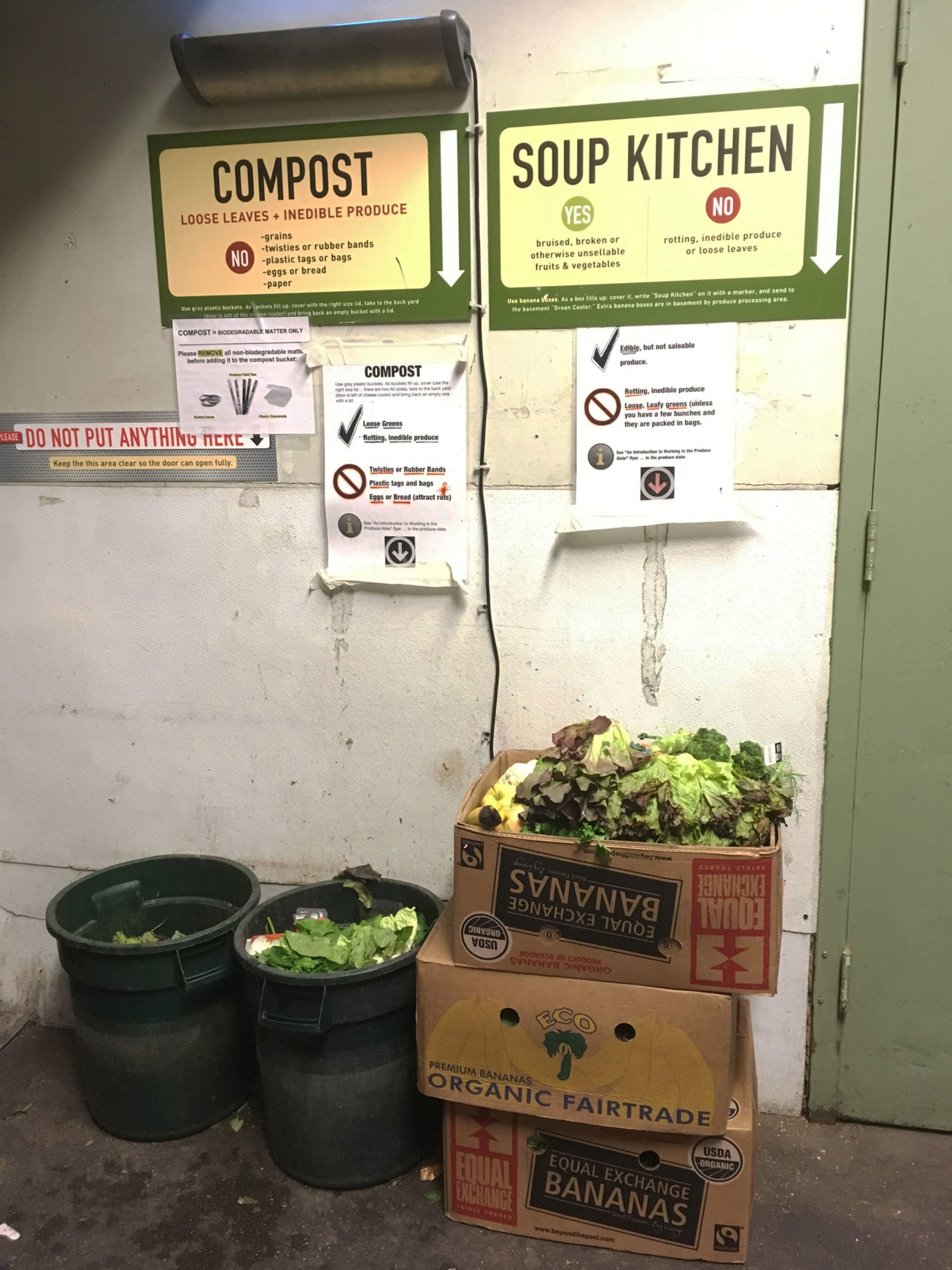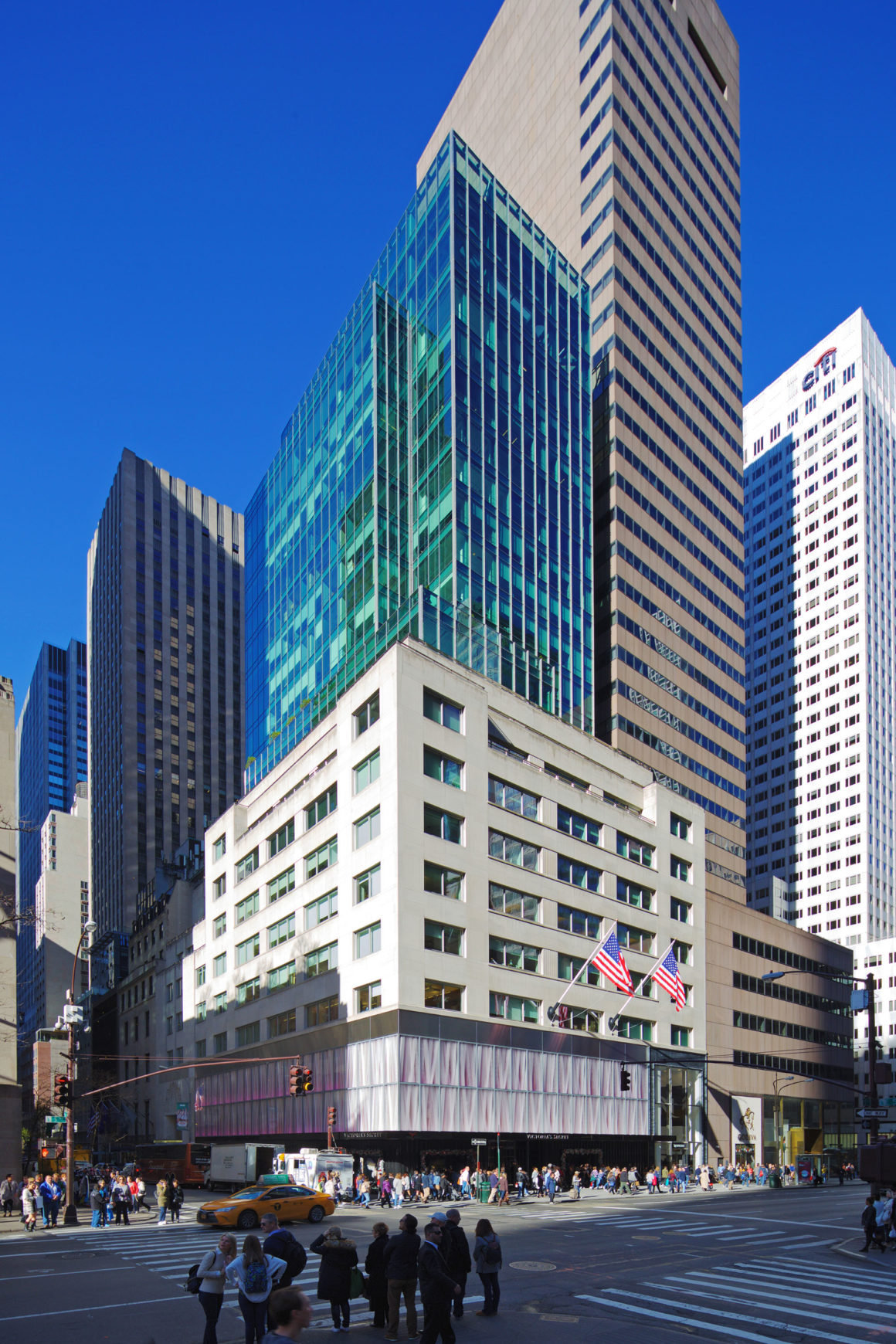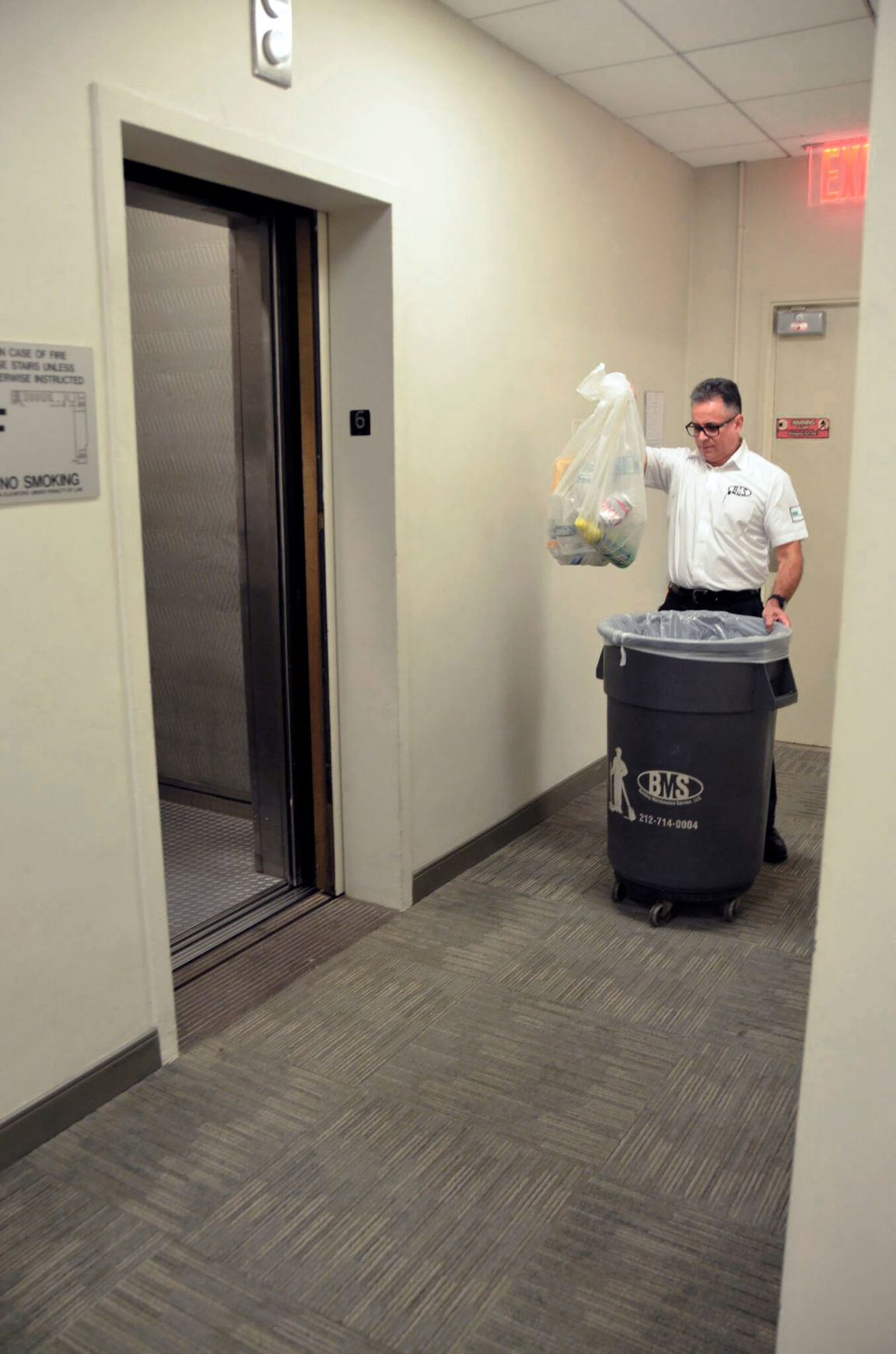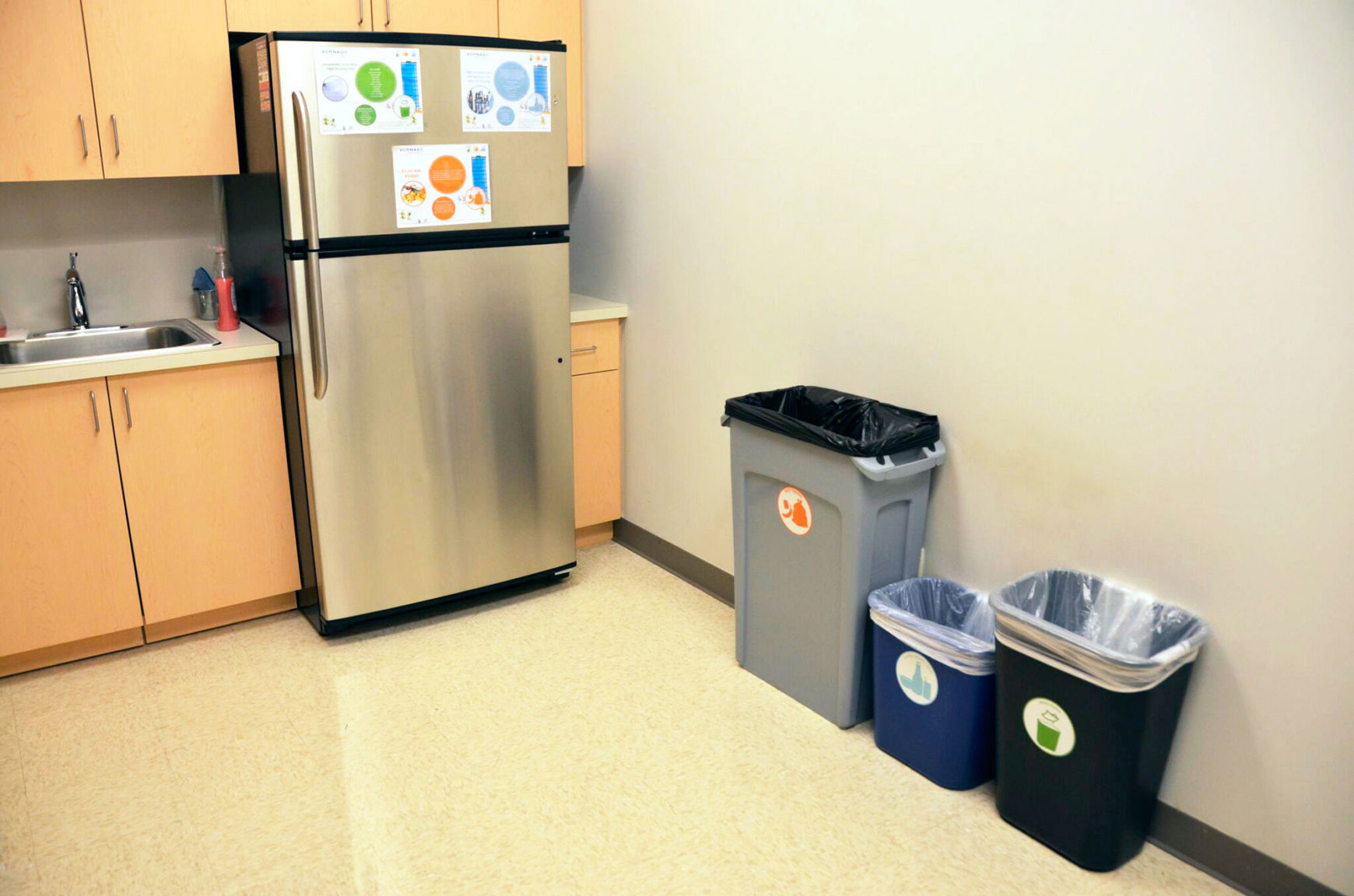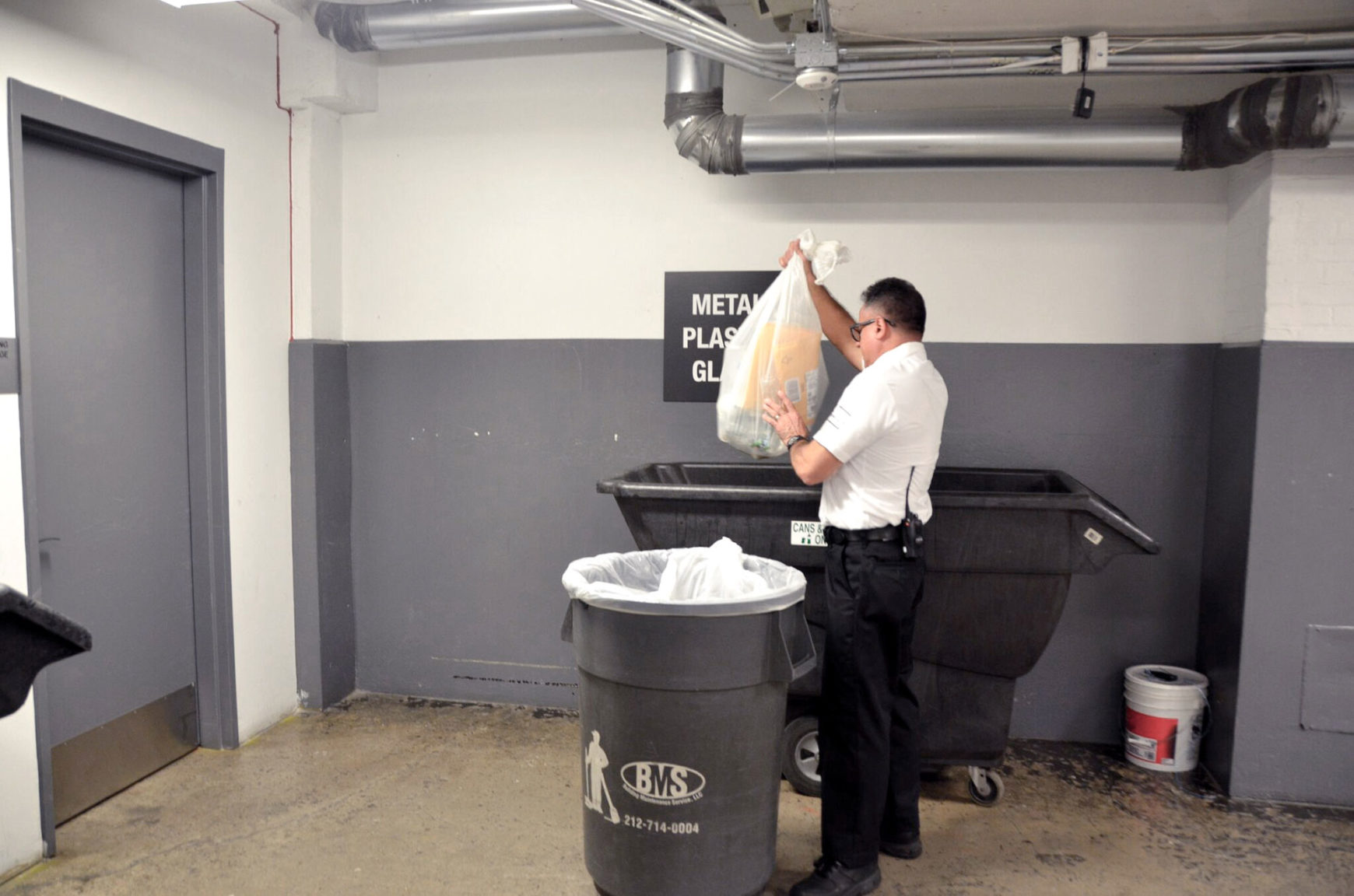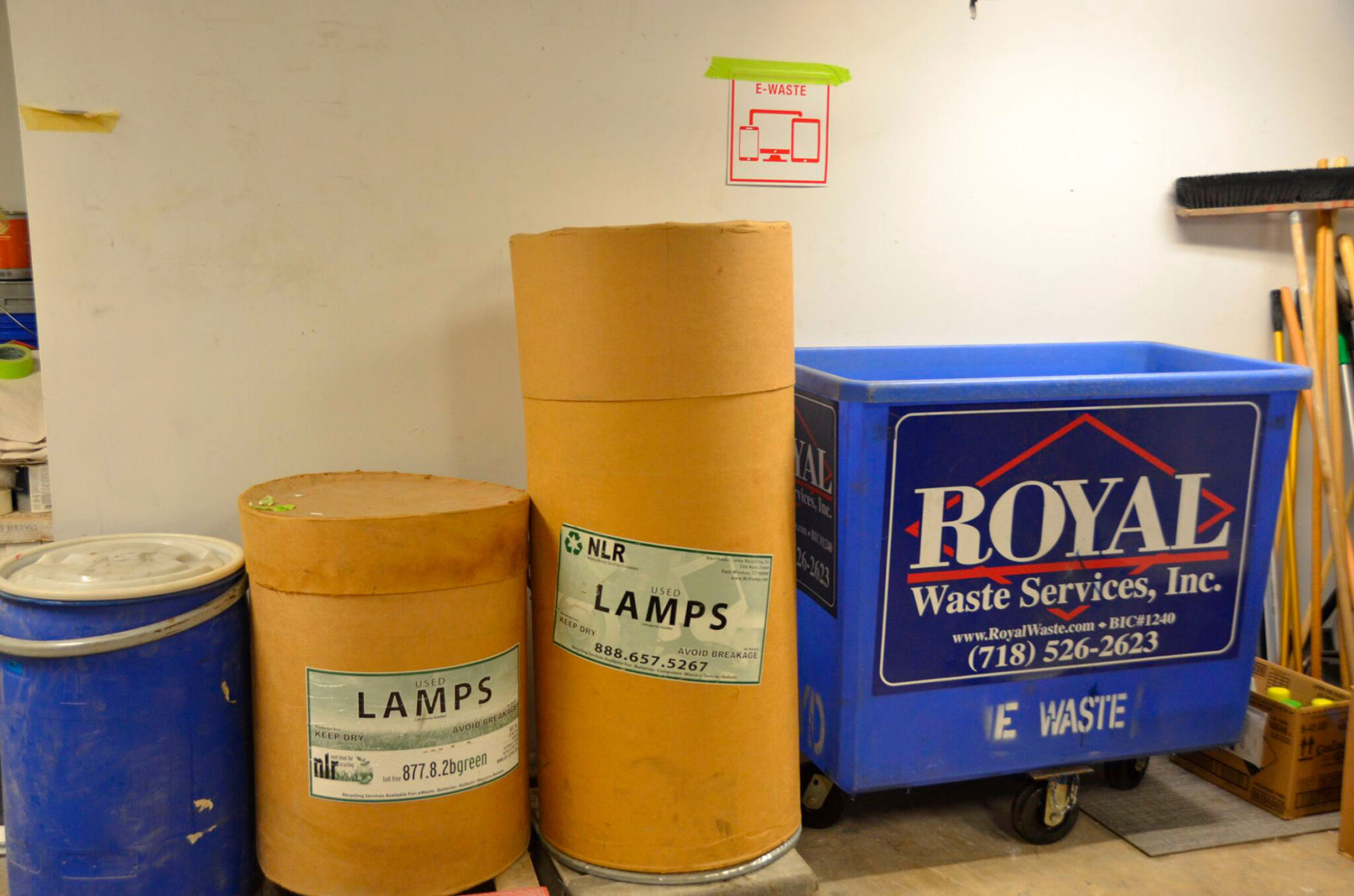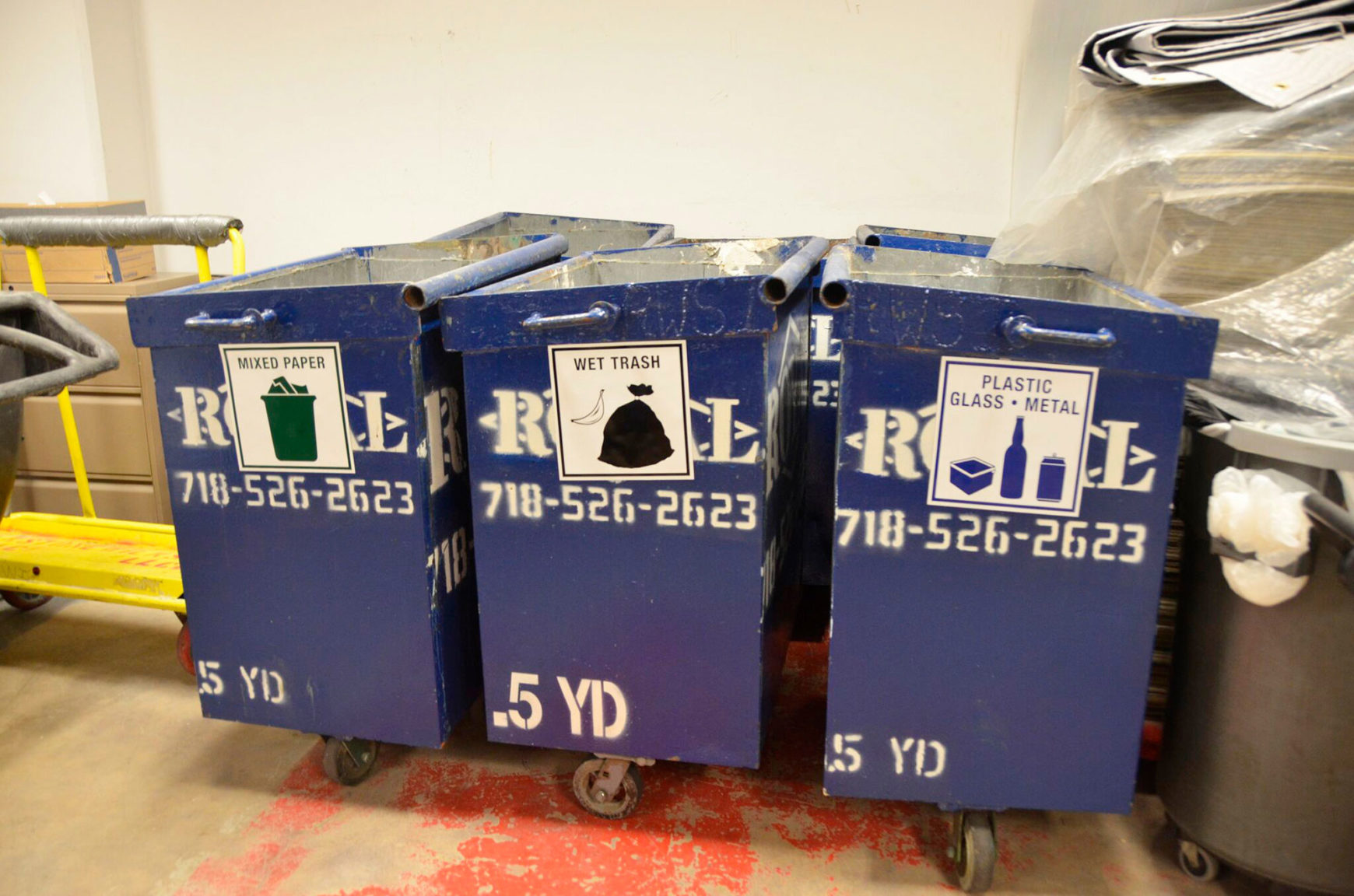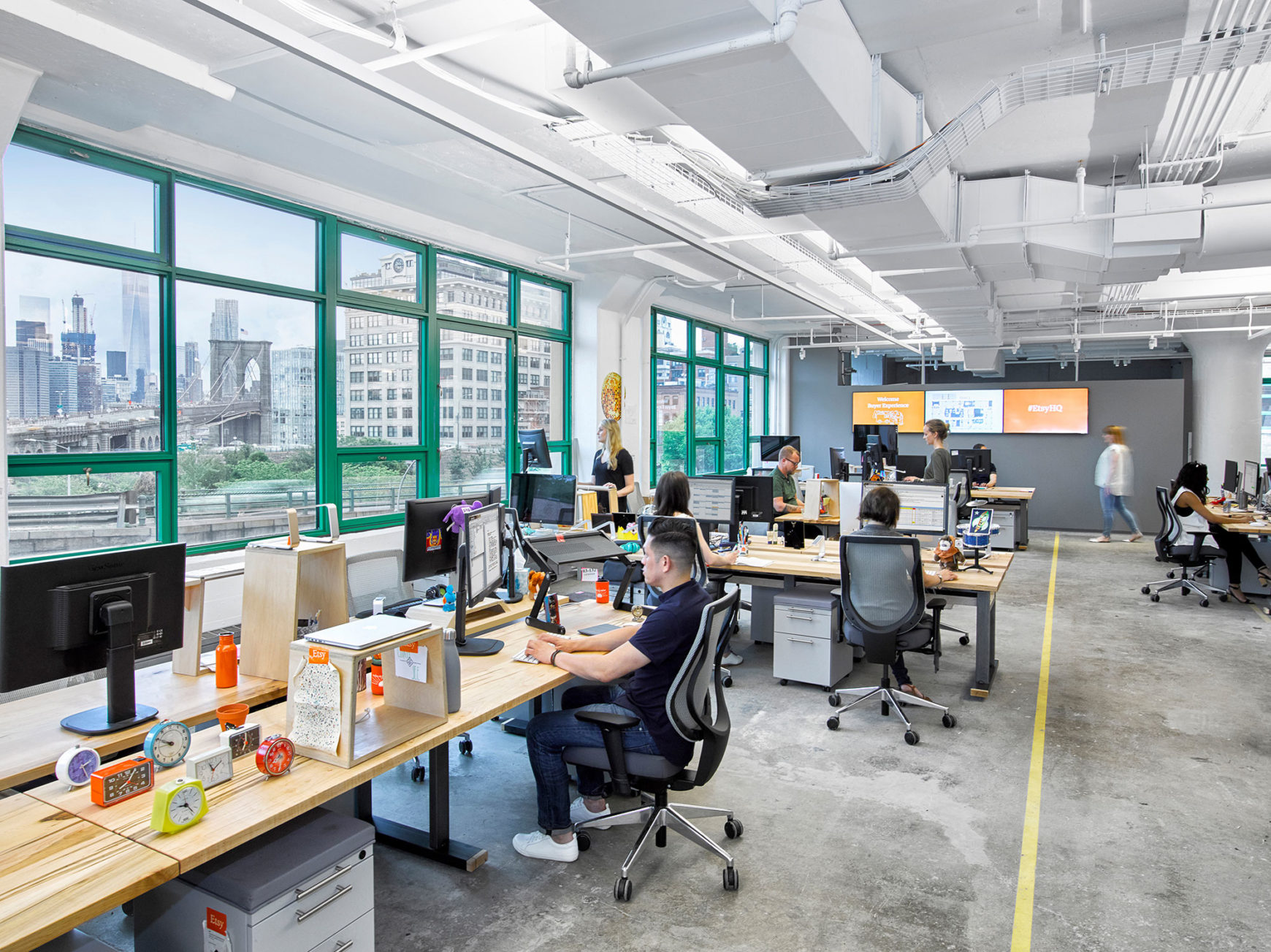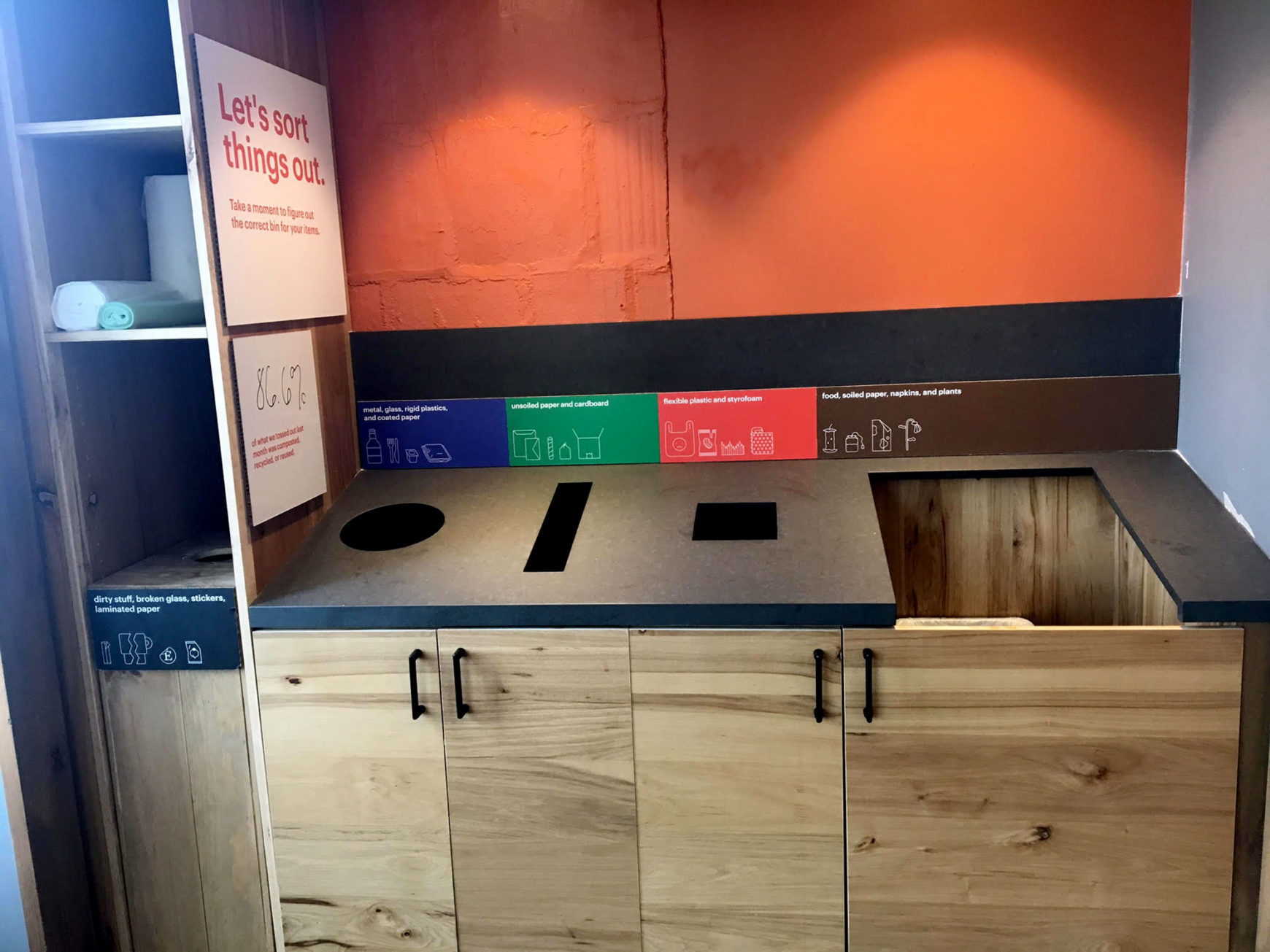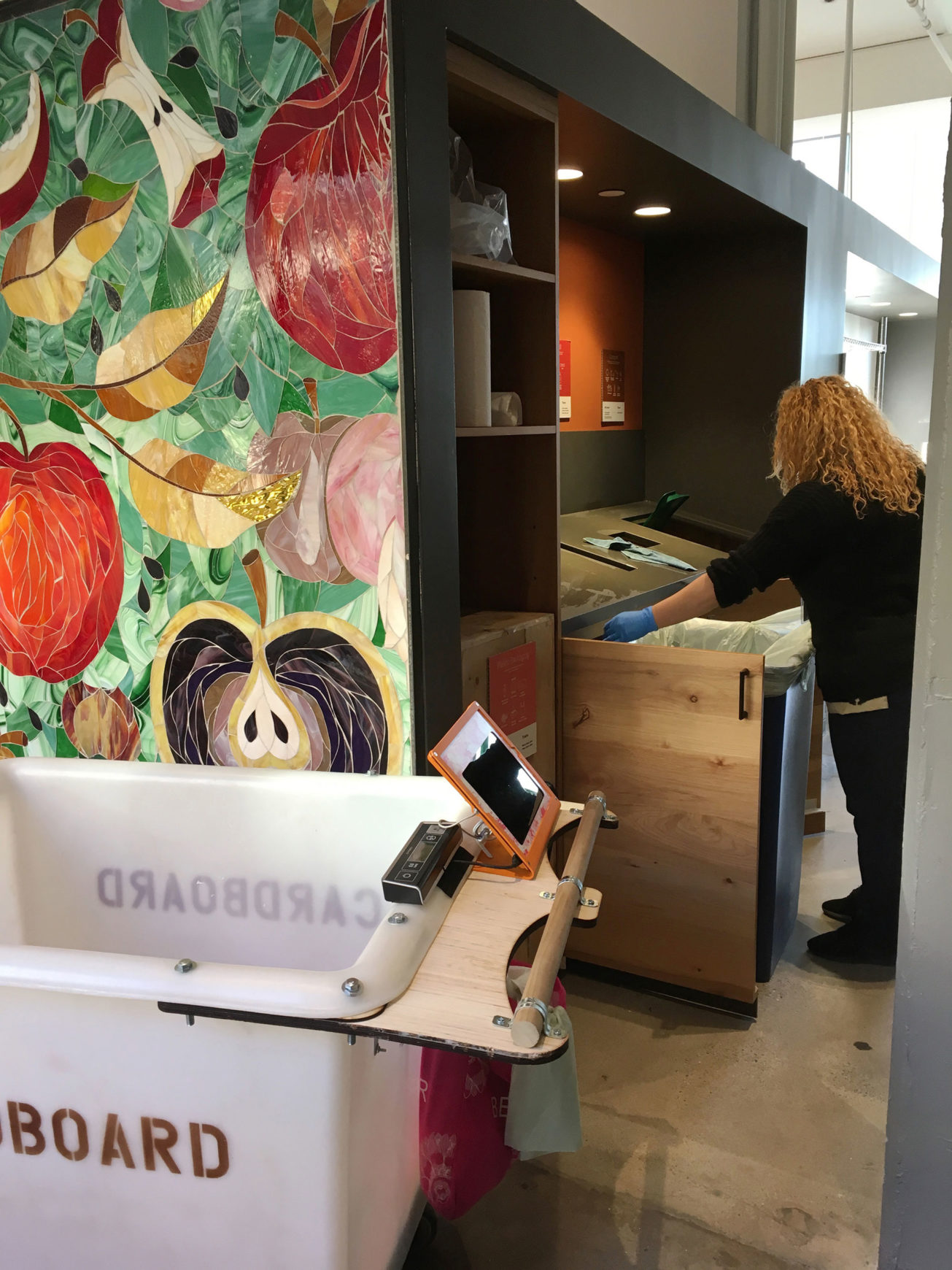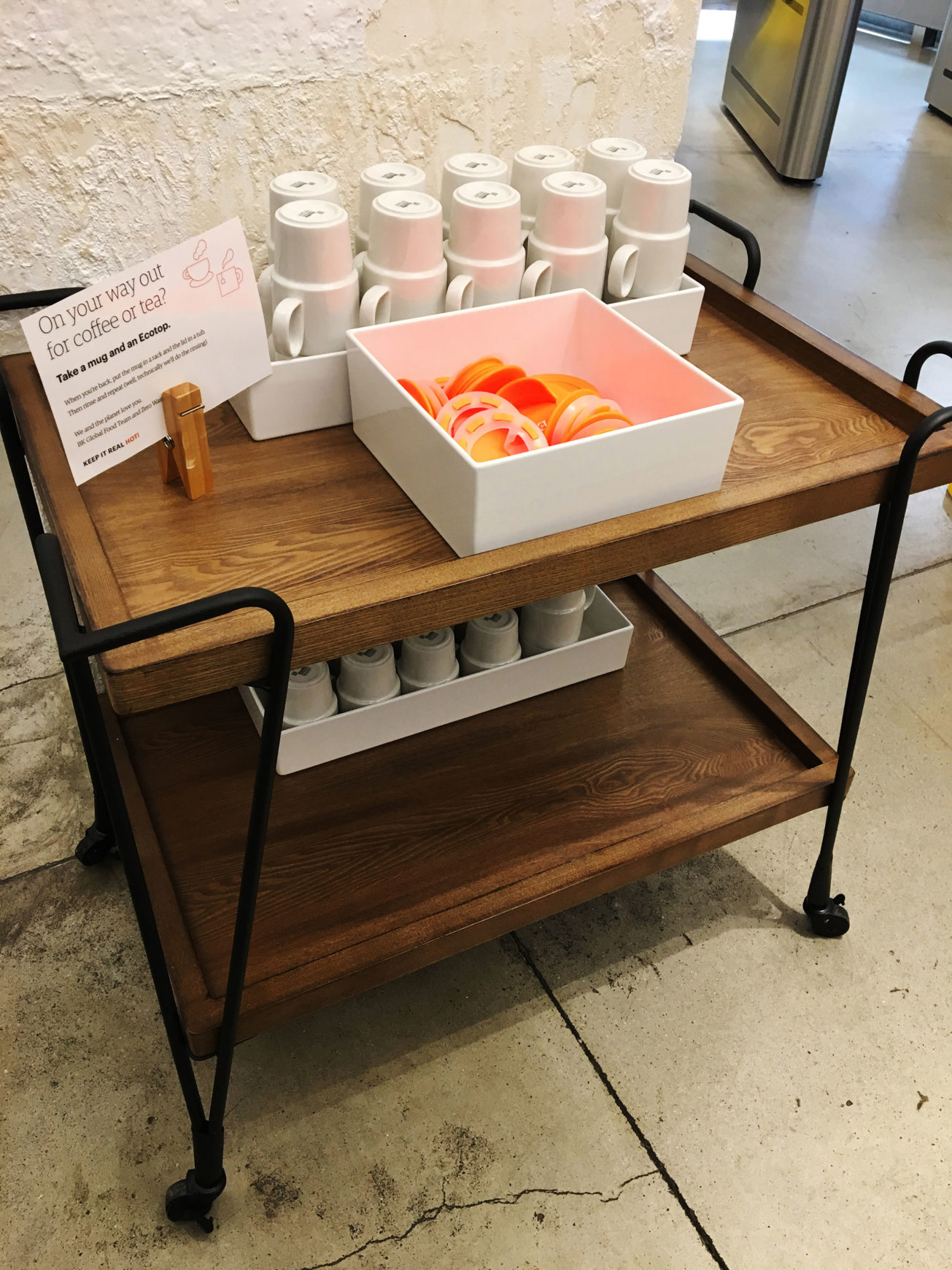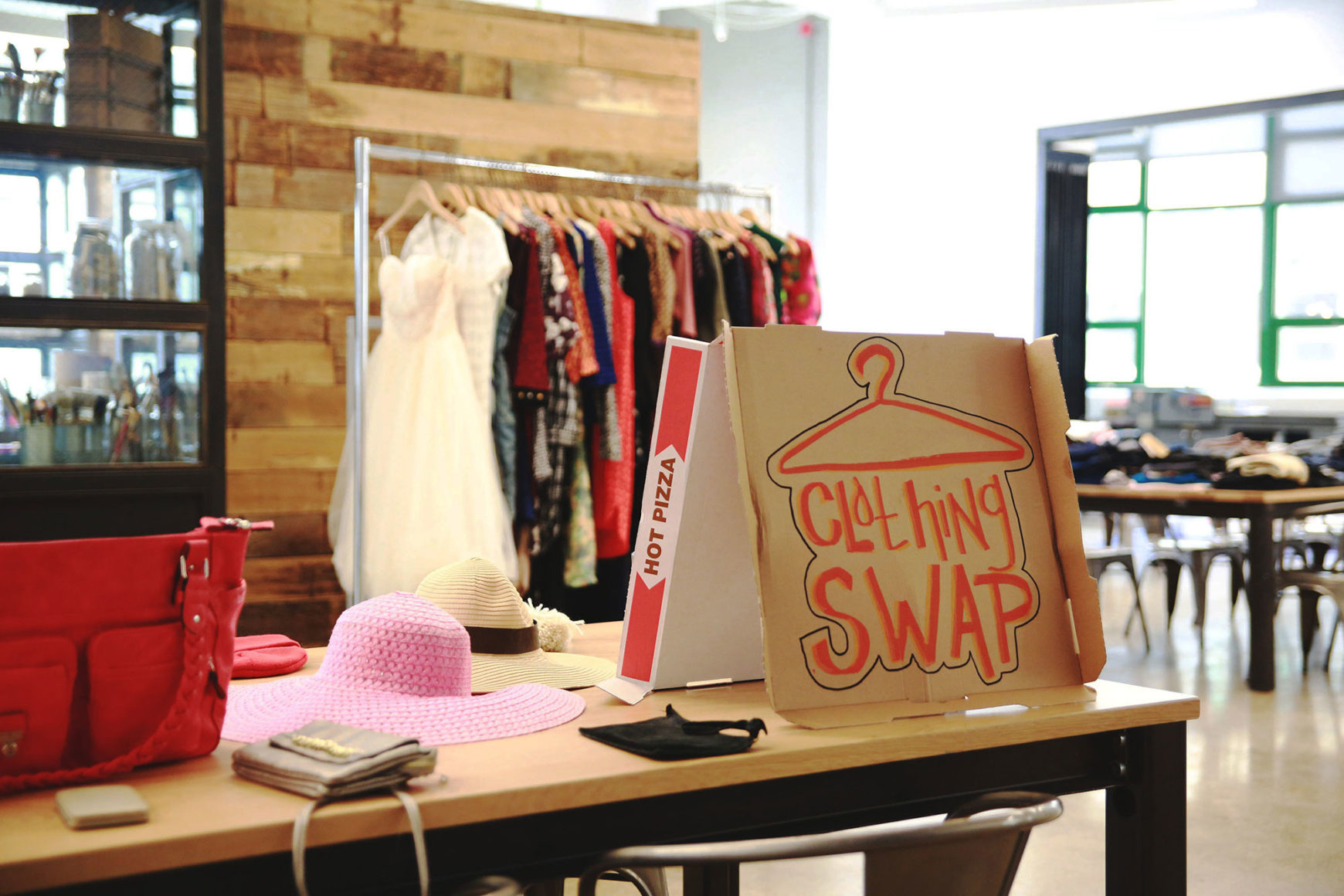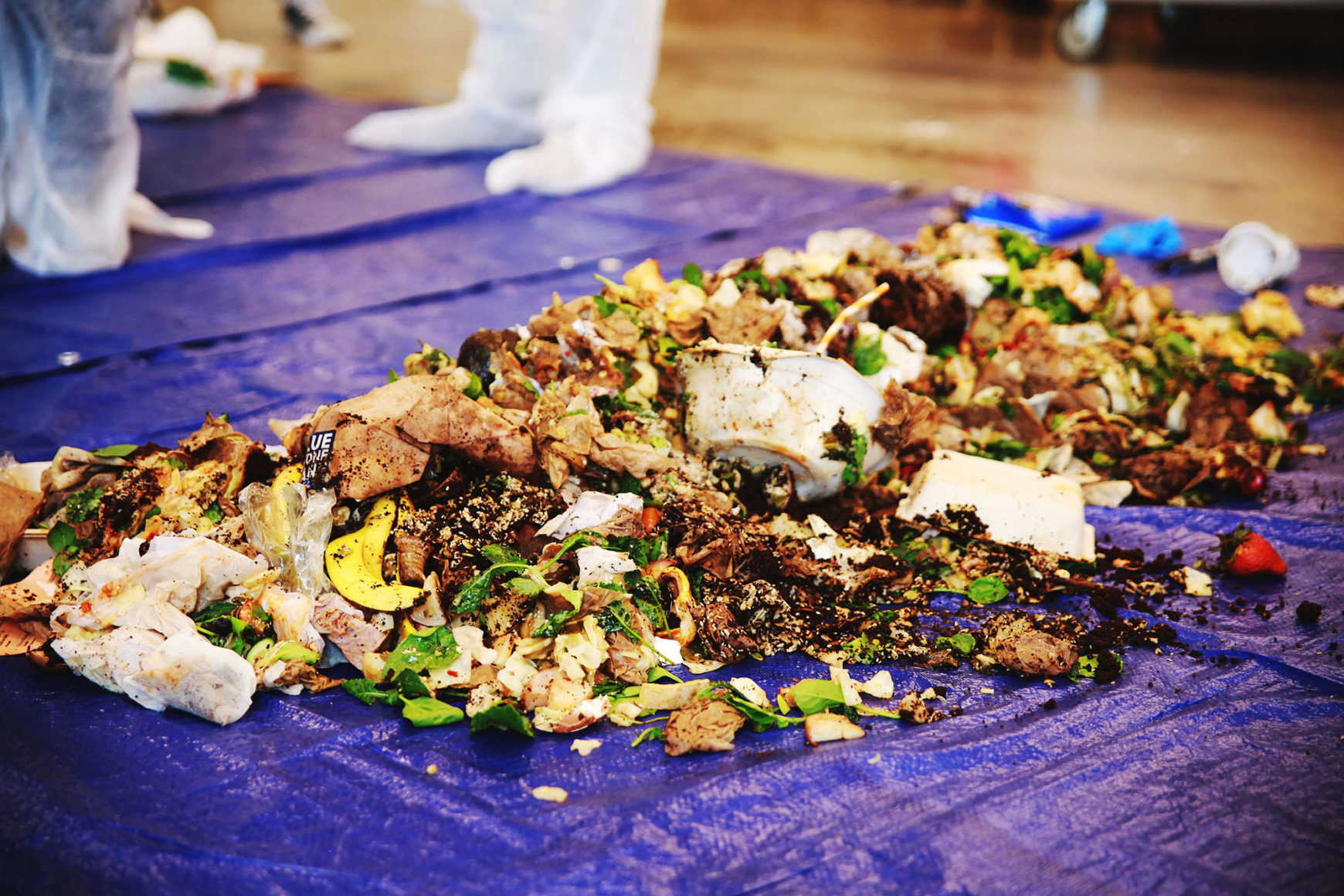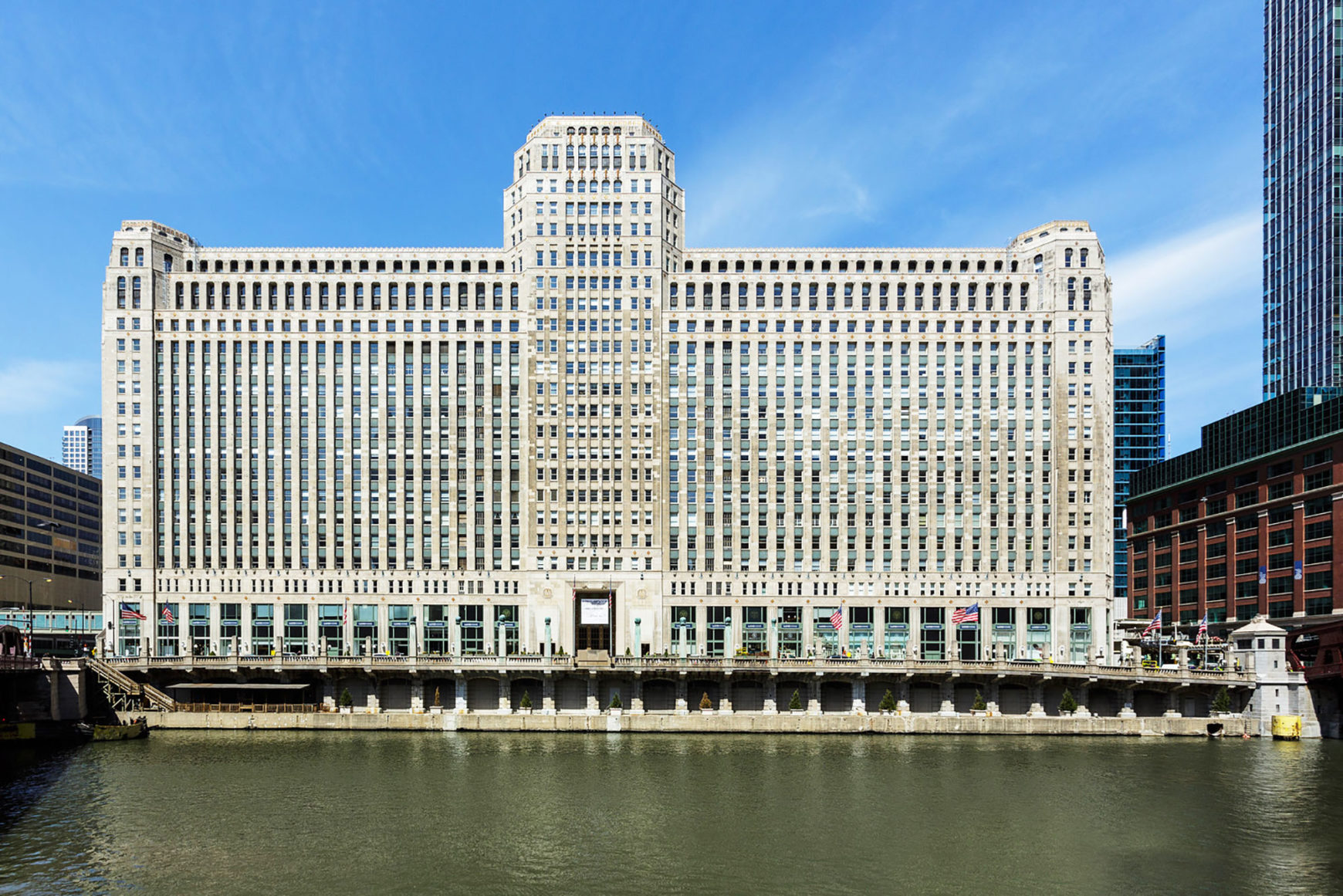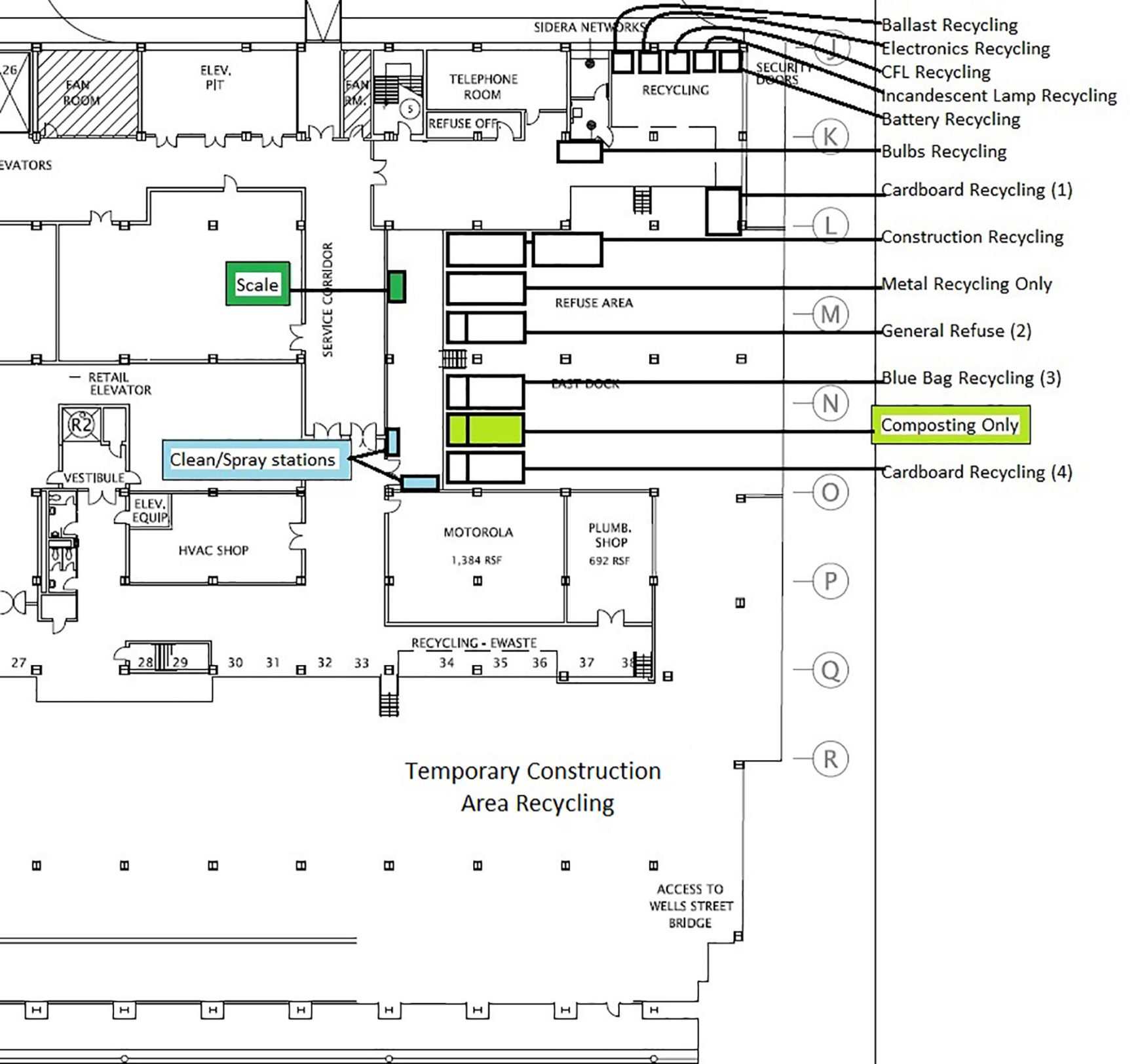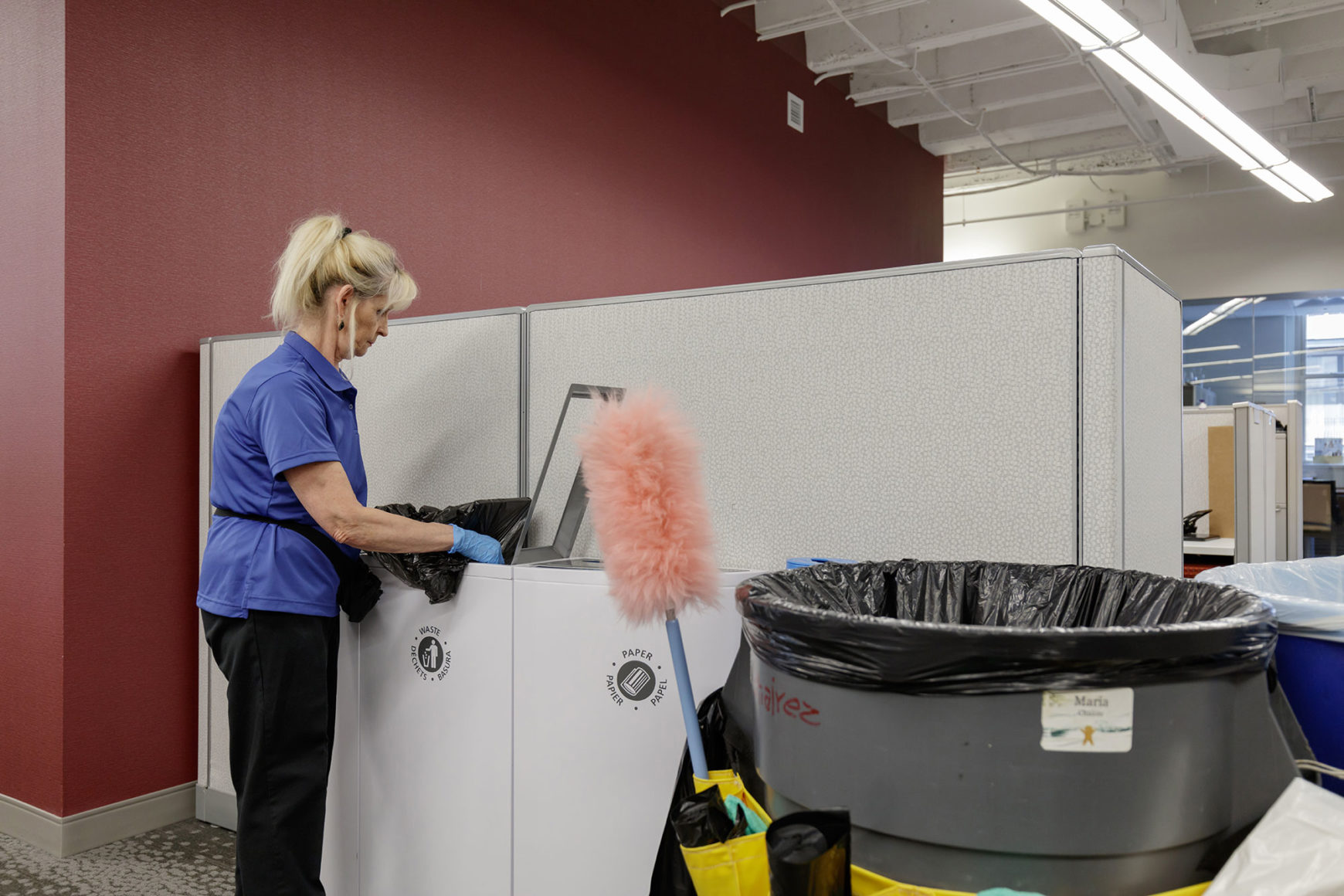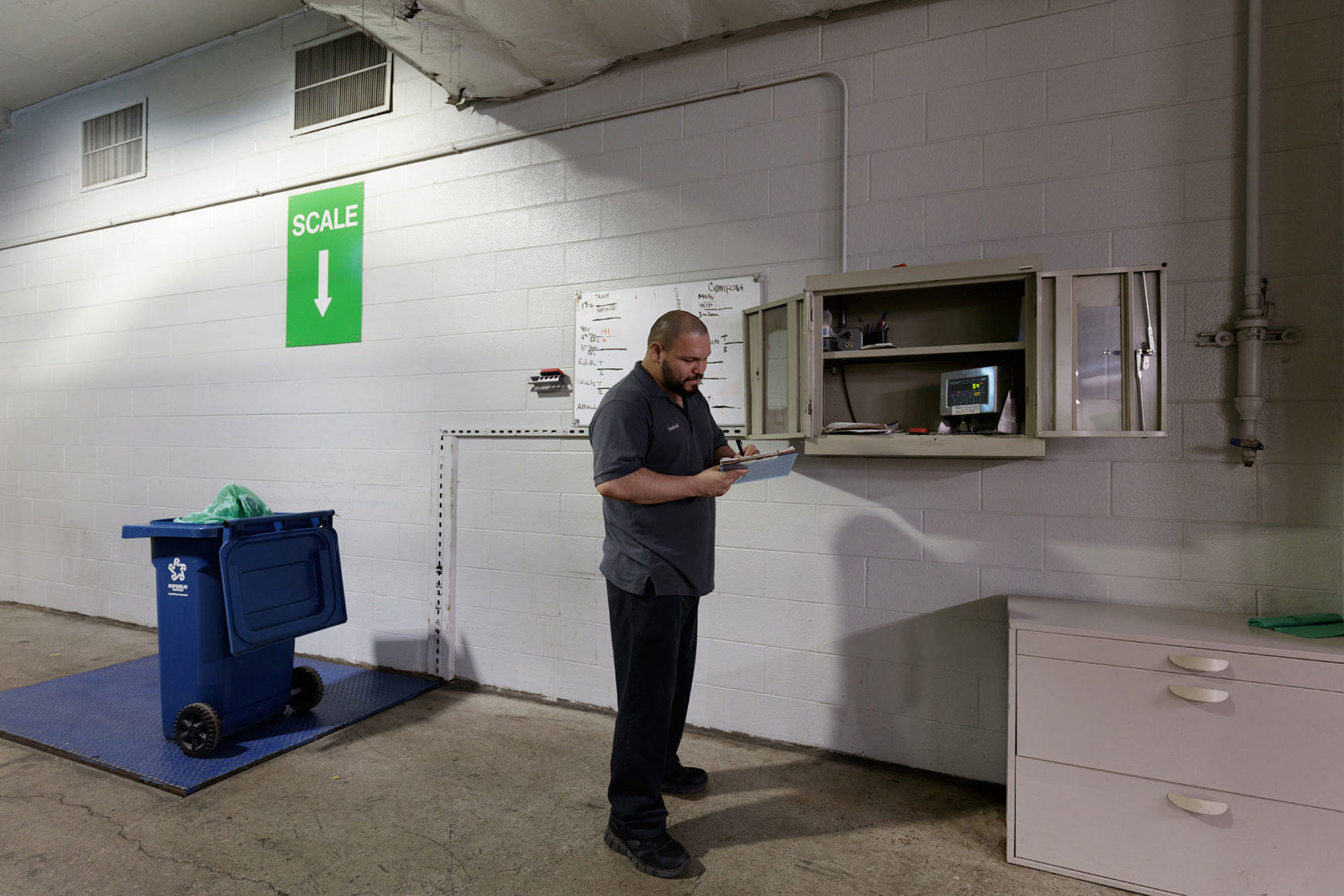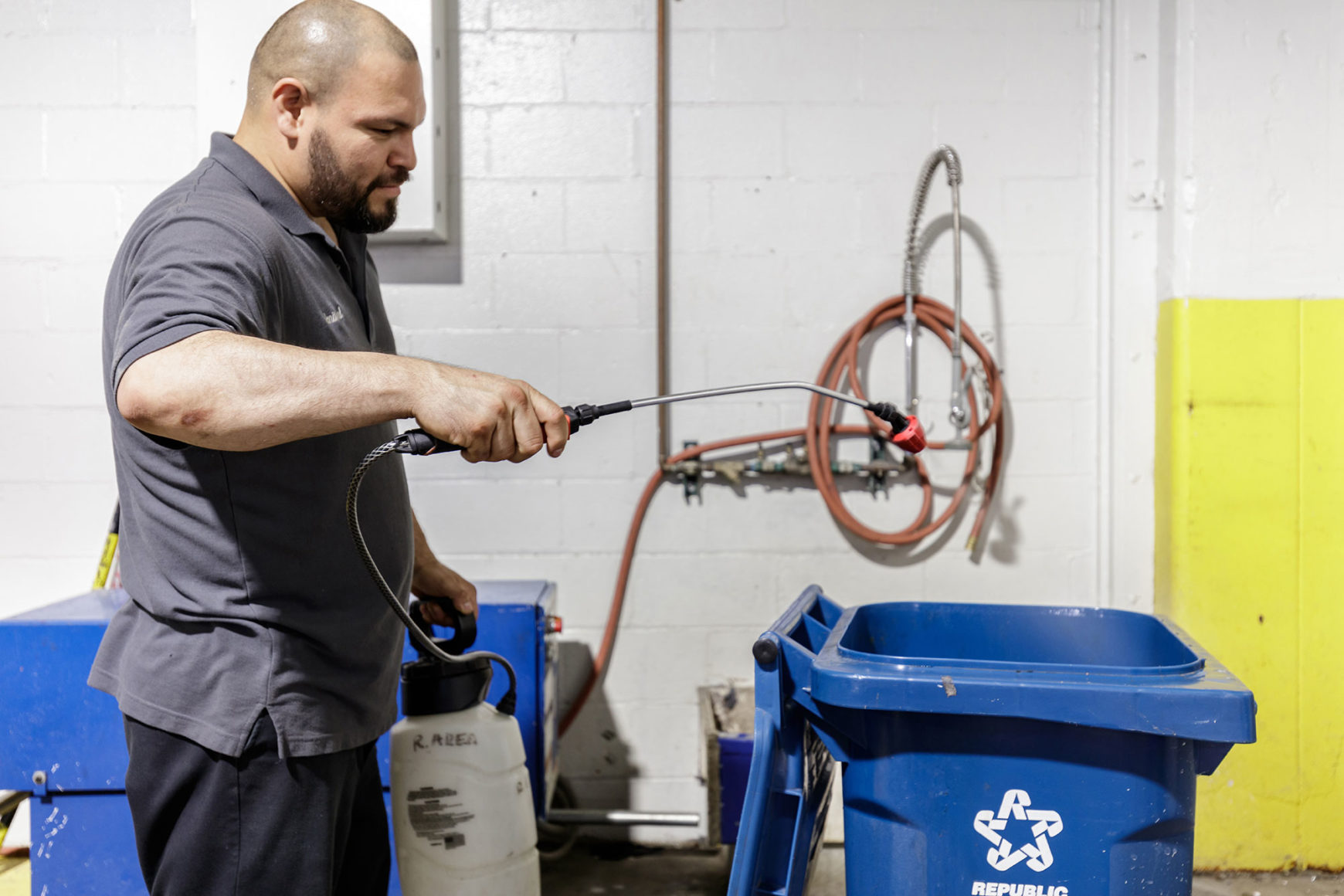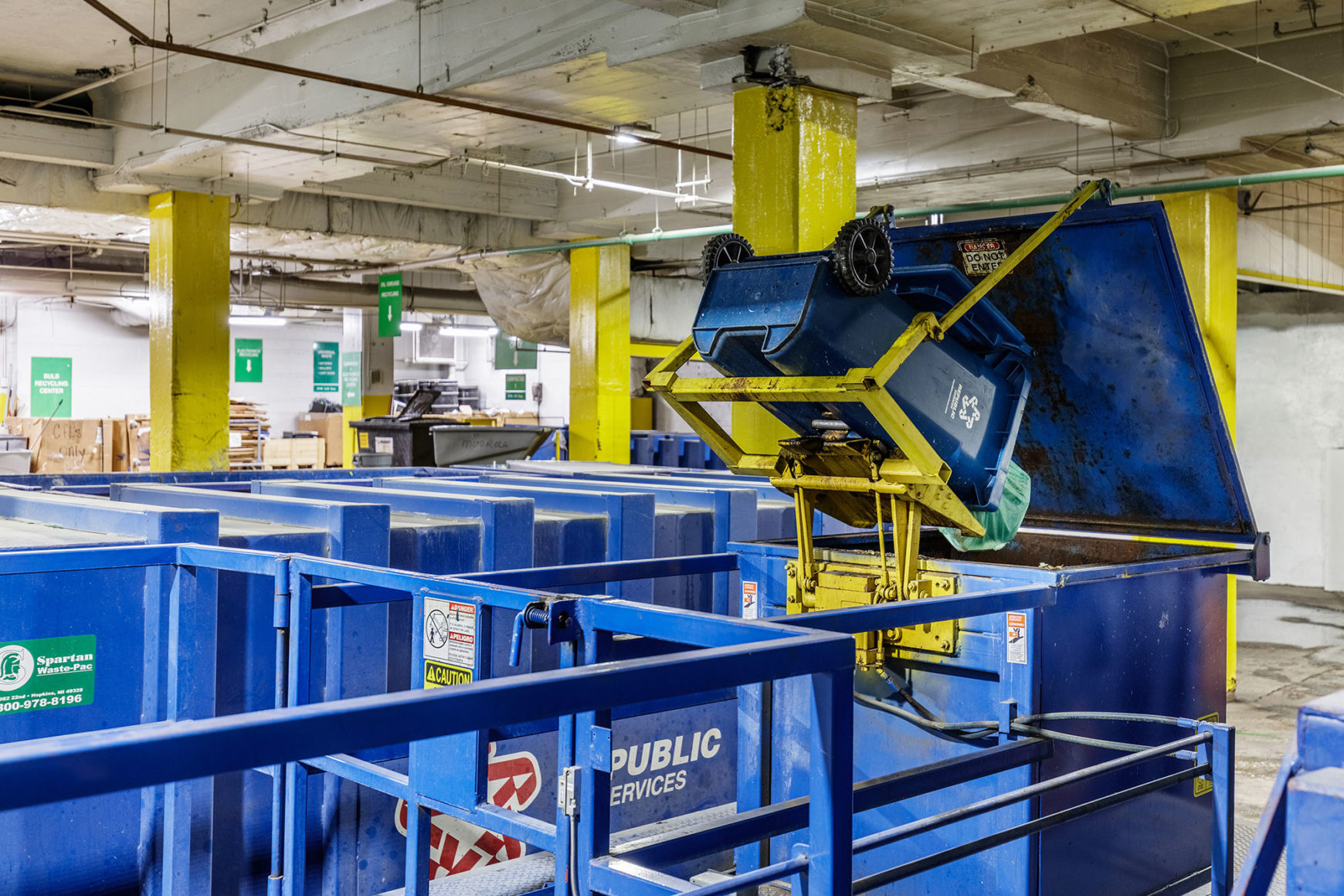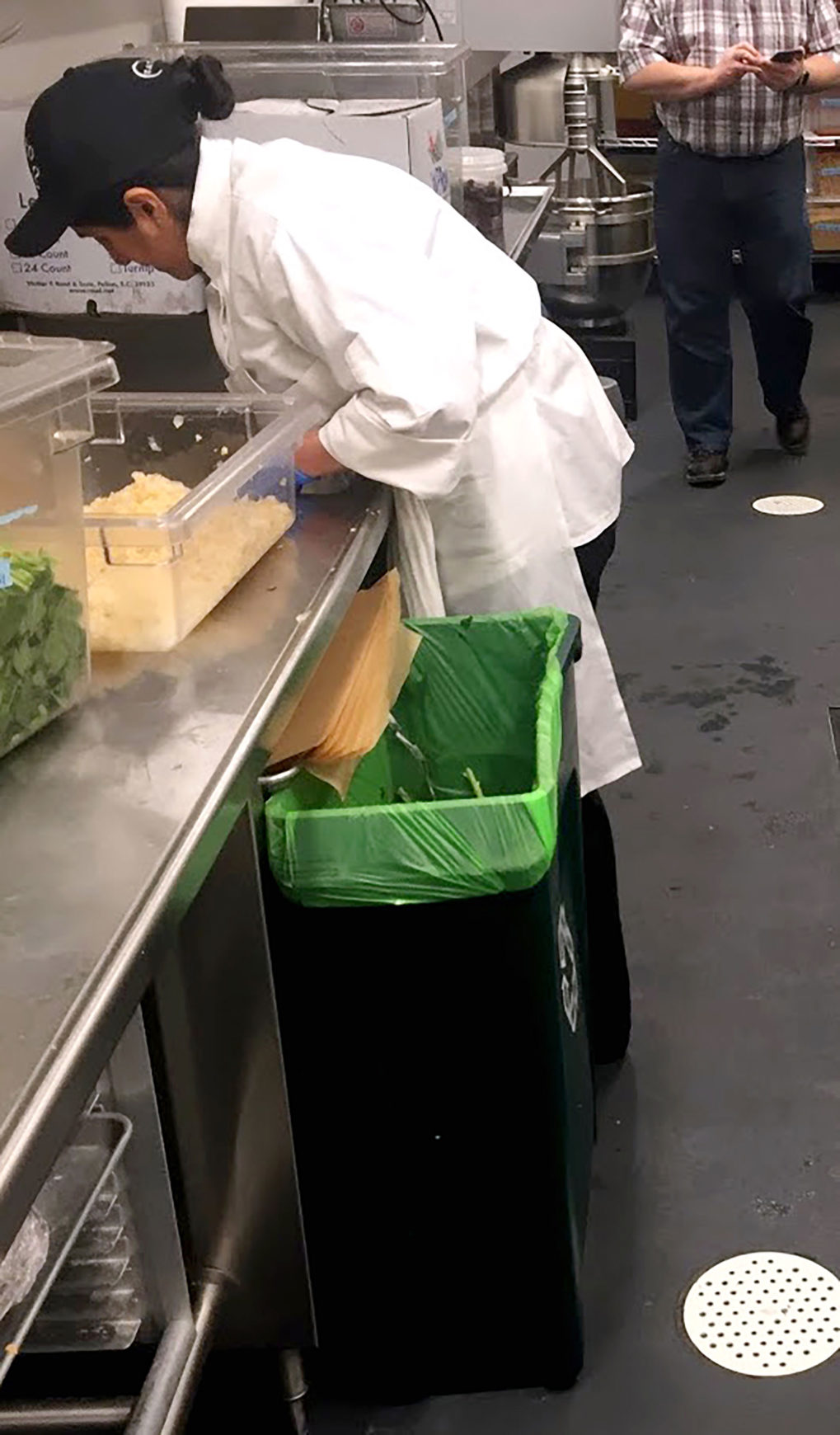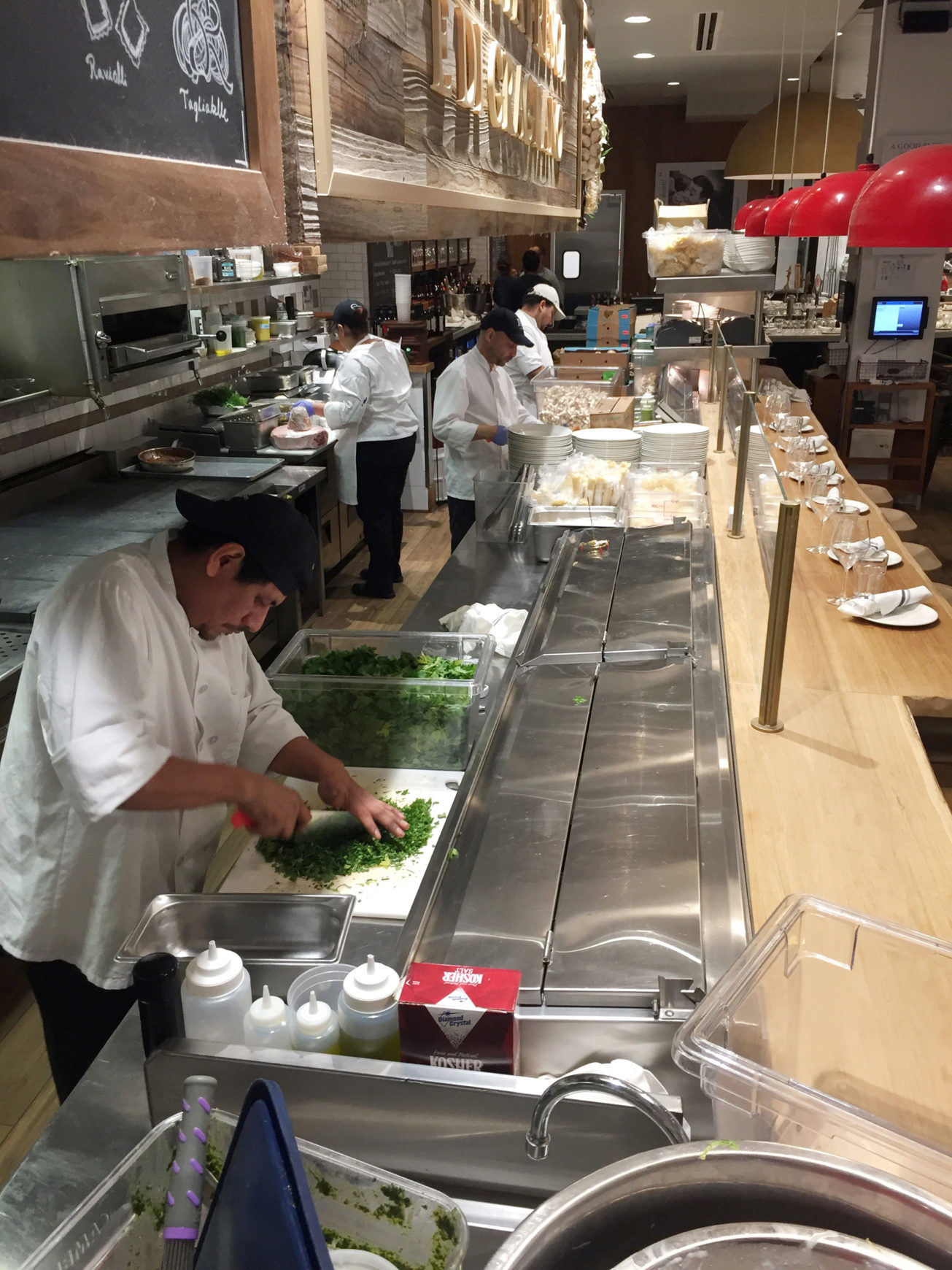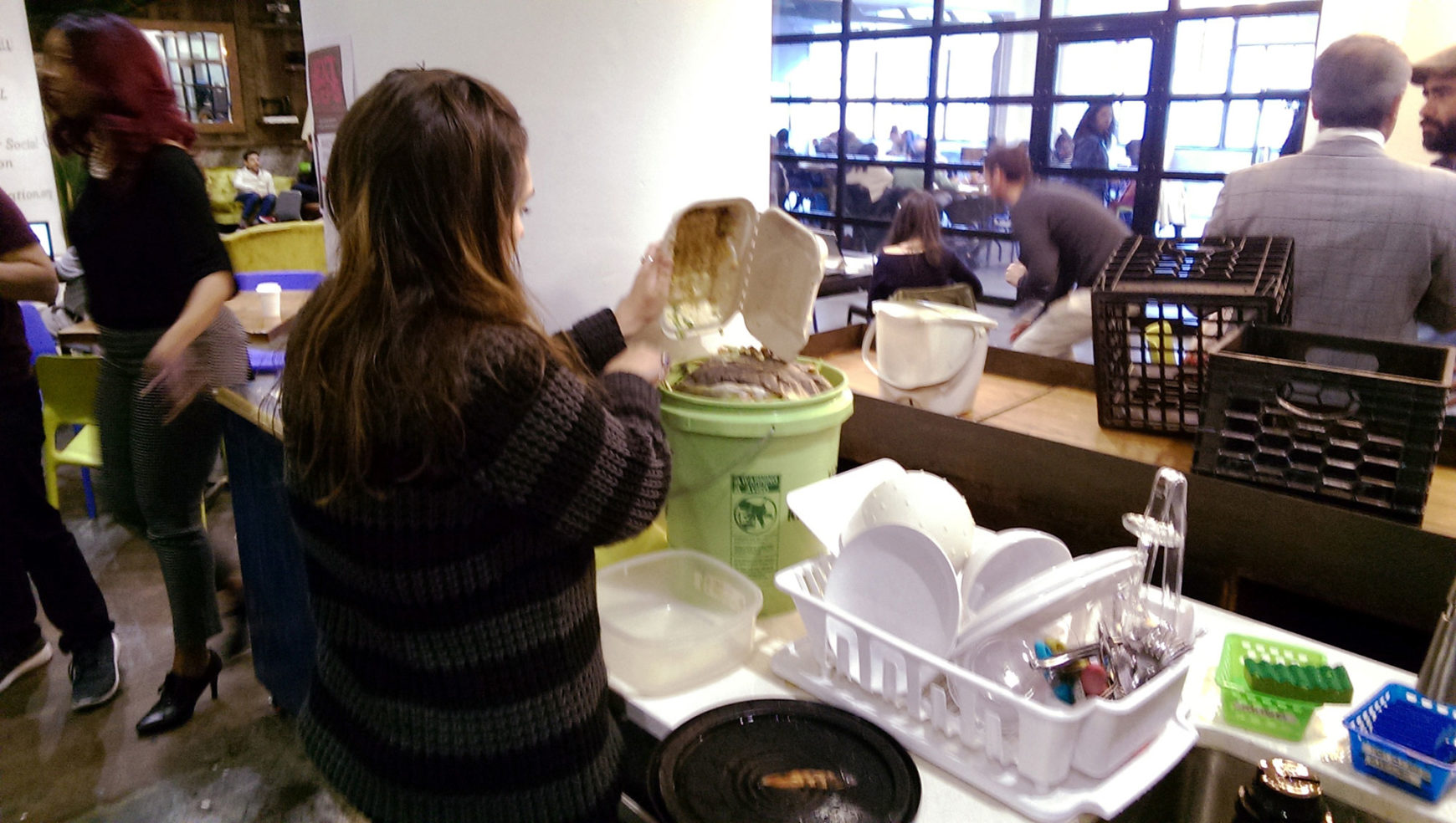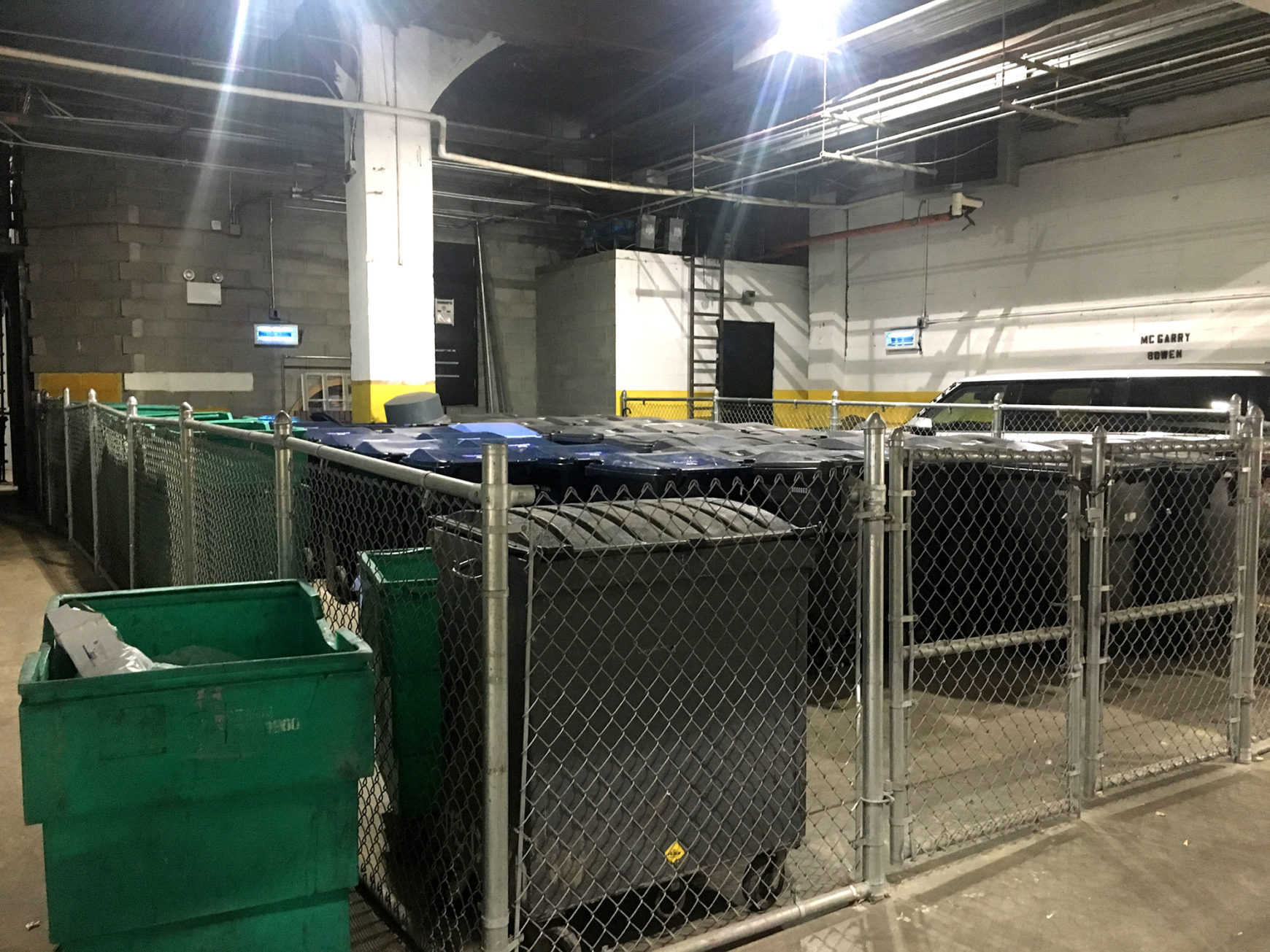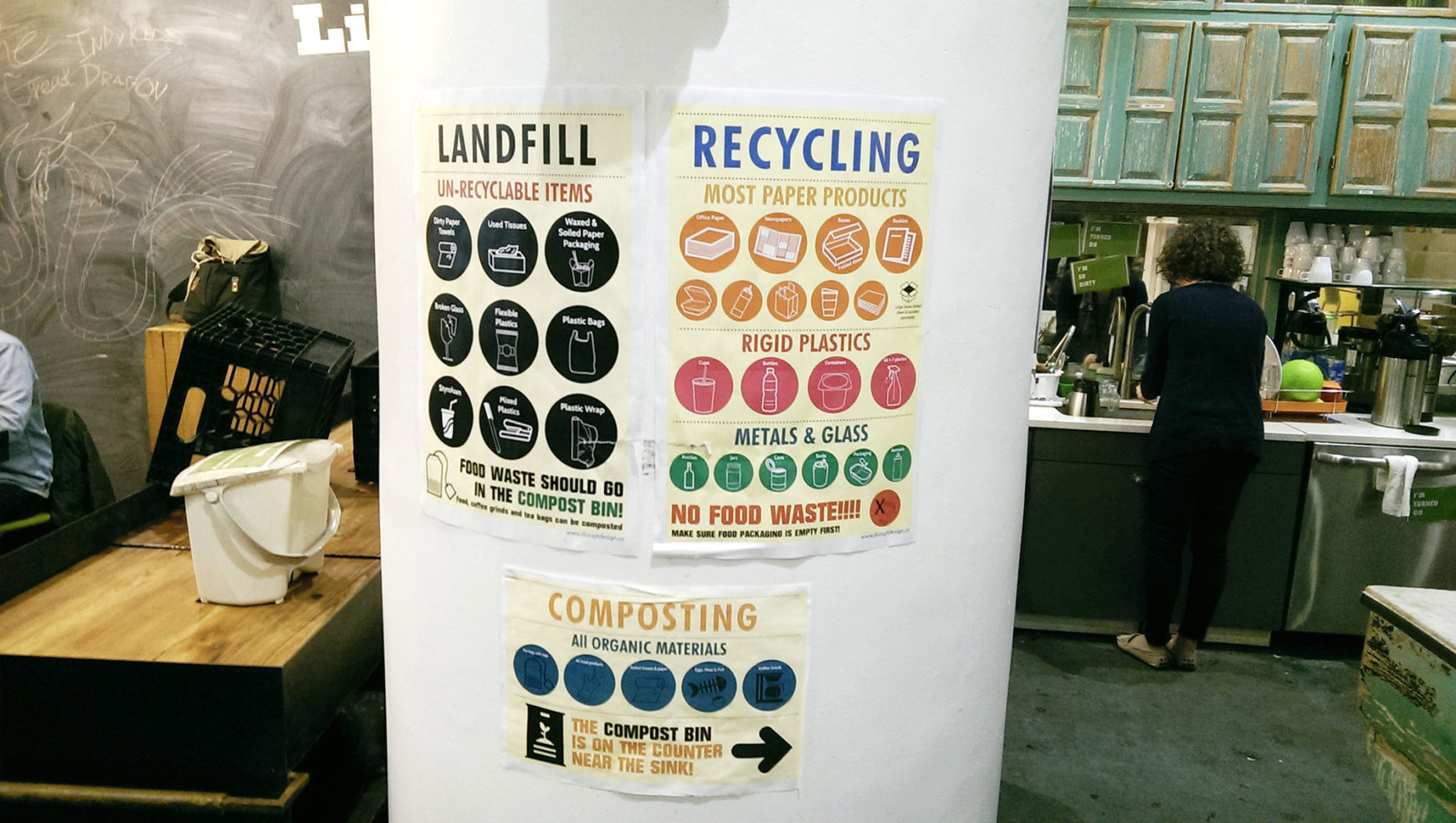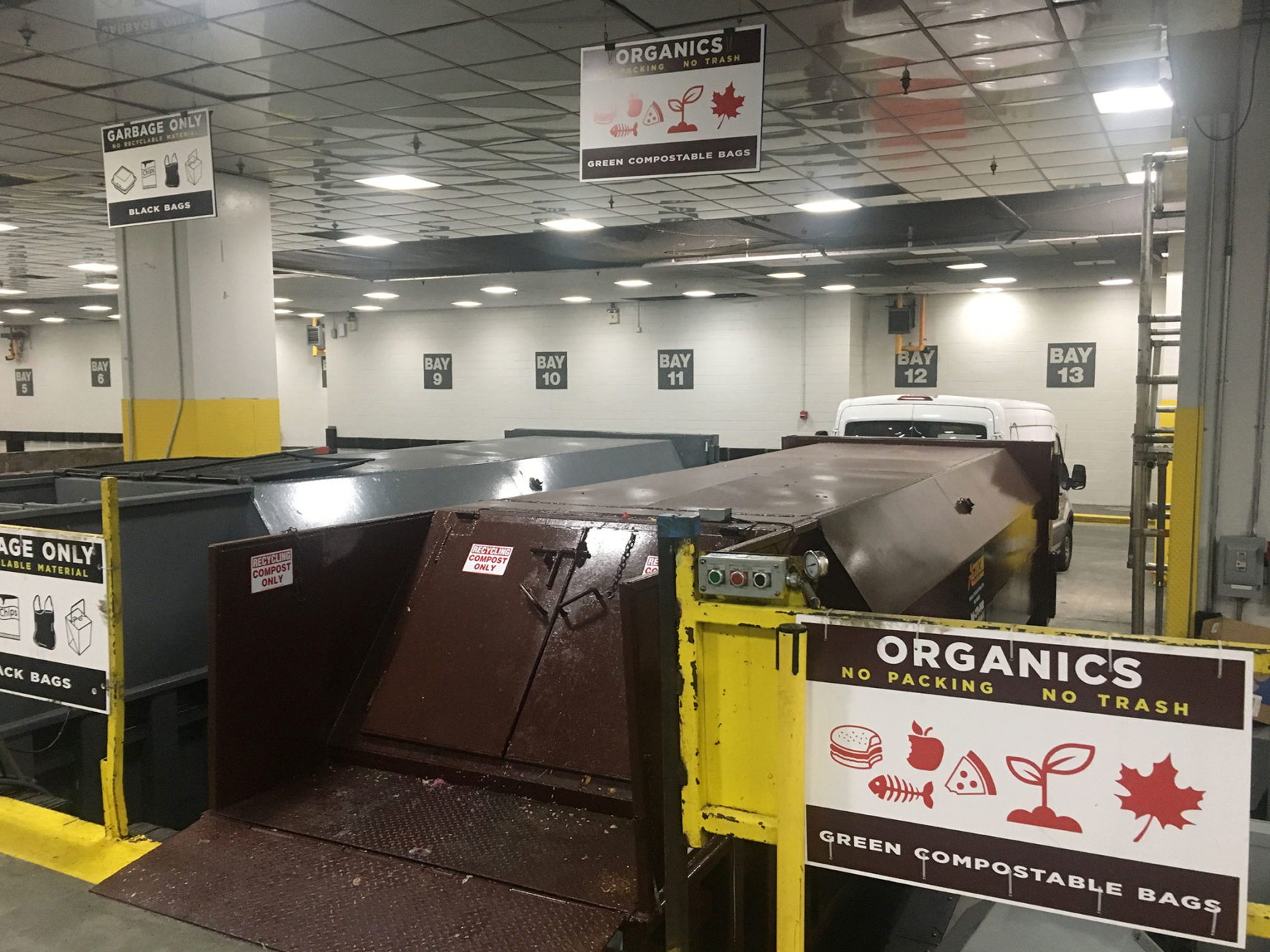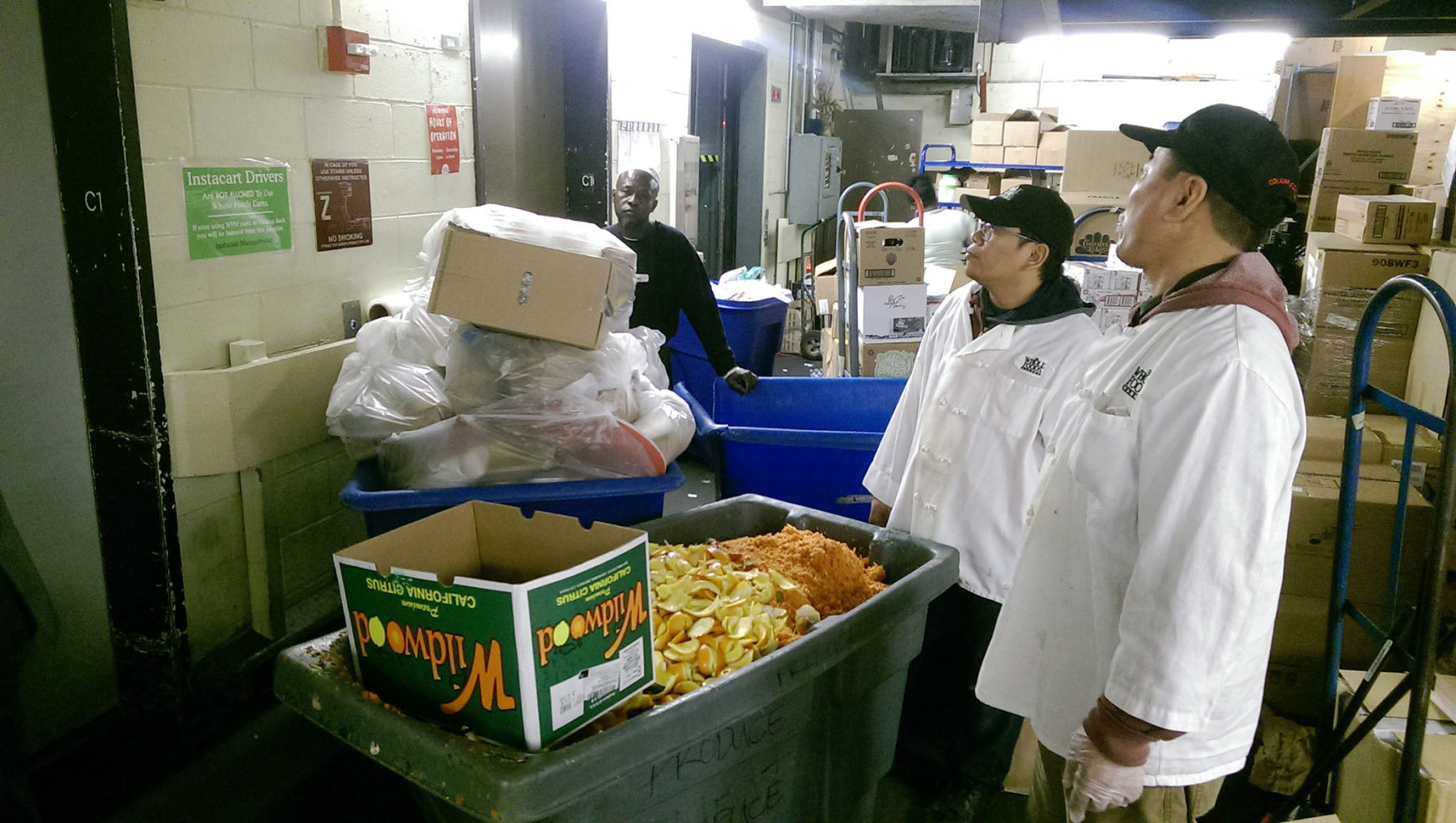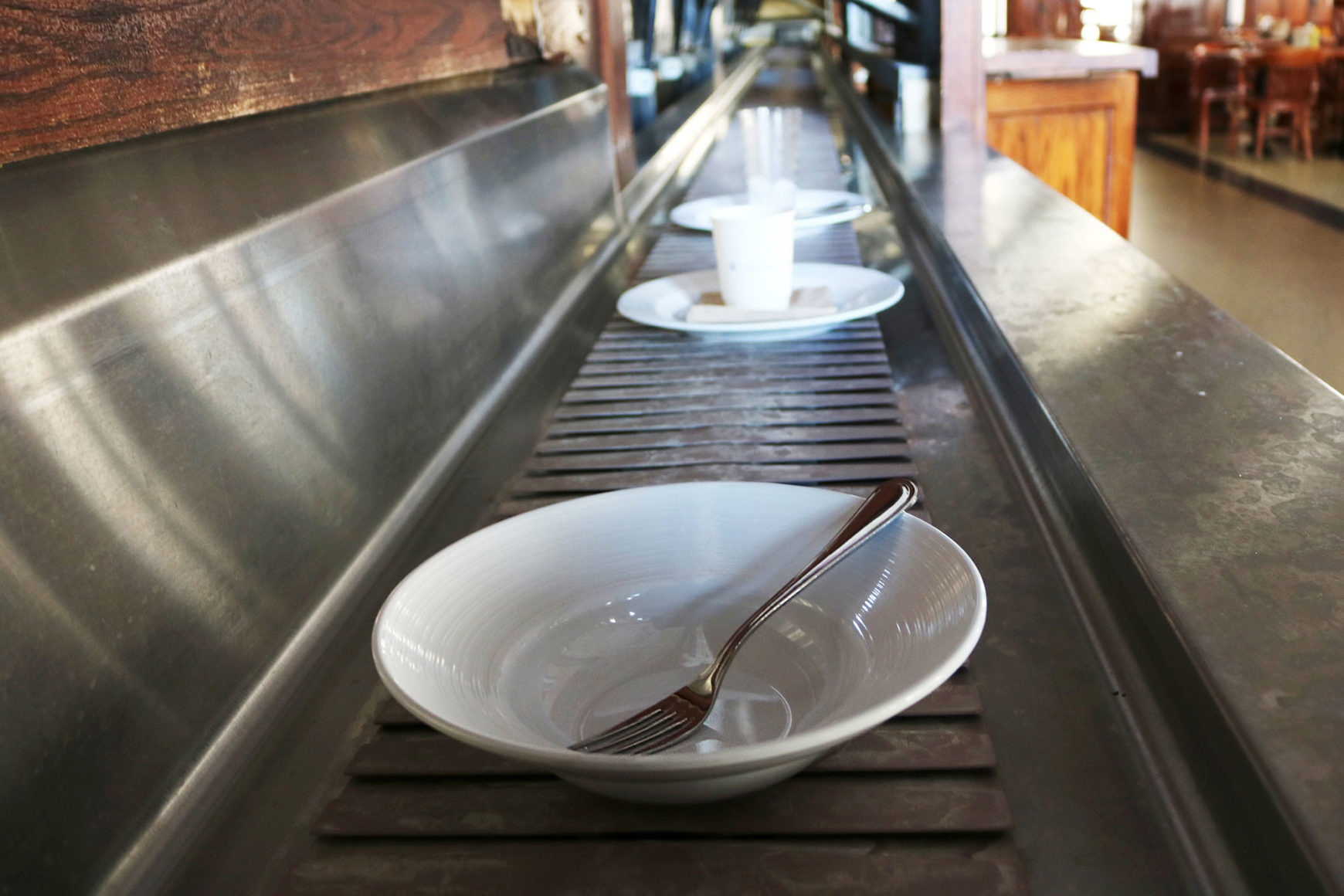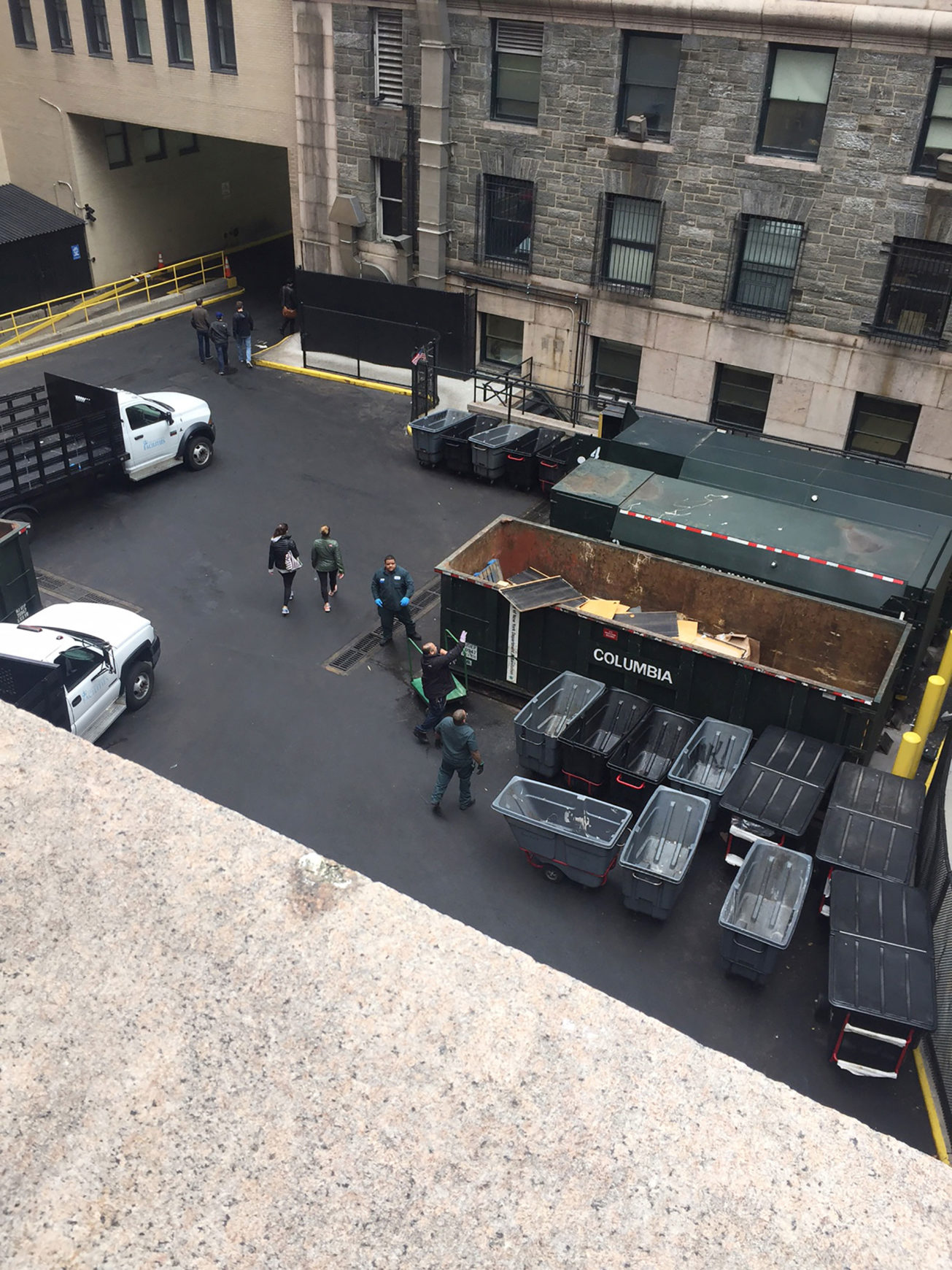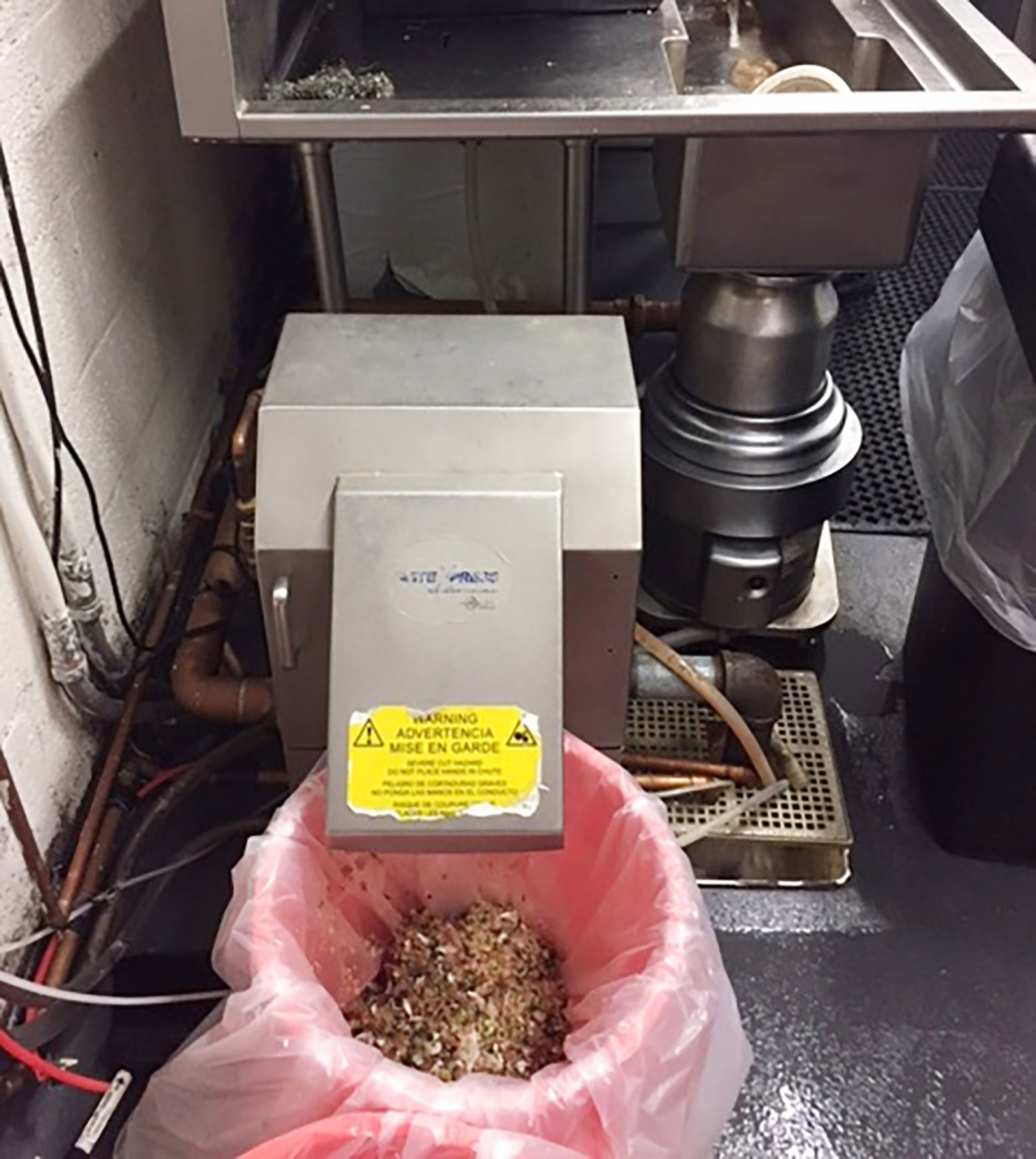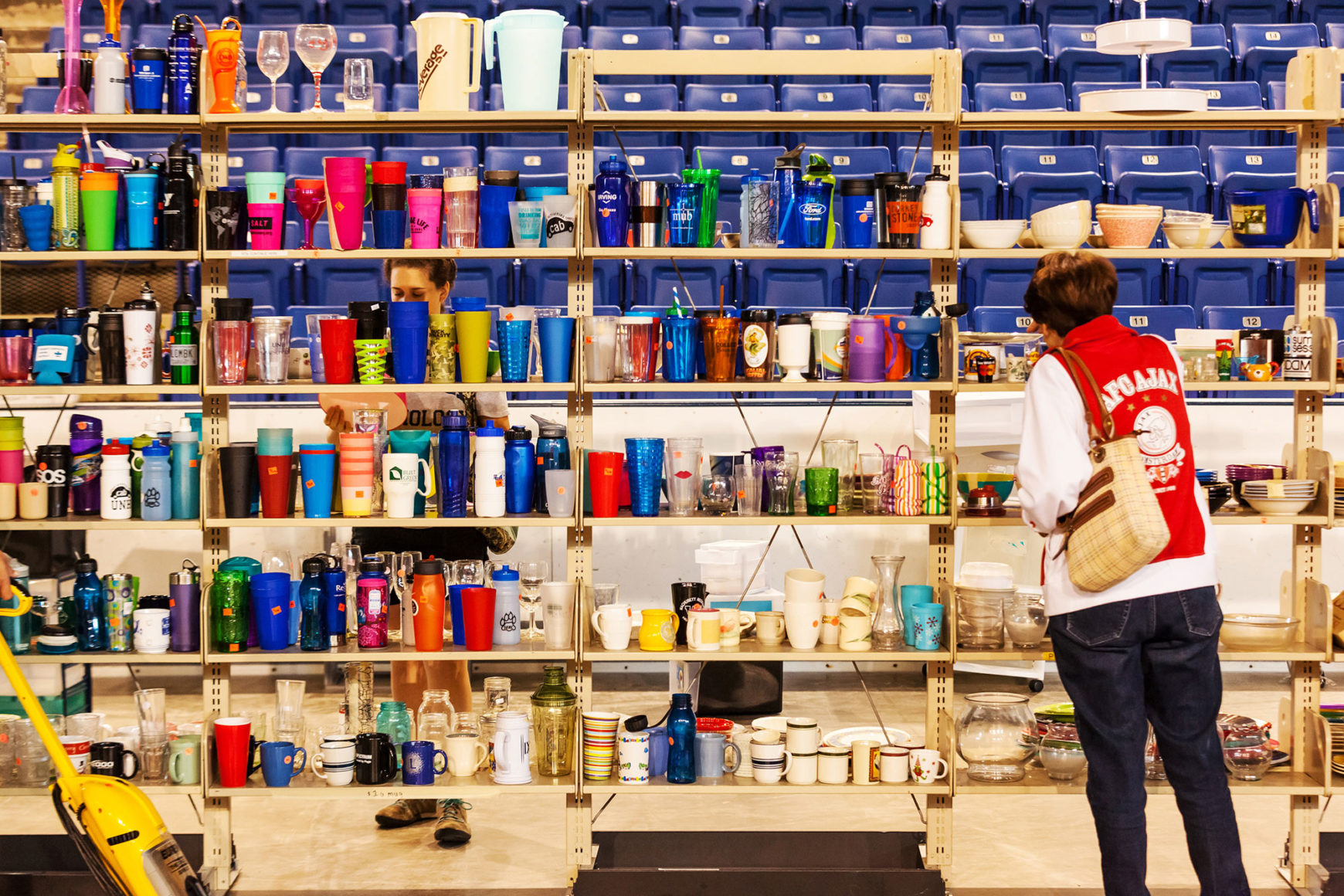Clichy-Batignolles, Paris
Type
Residential Typology 1: Central Location
Best Practice Strategies
- 2.08 Provide equal convenience disposal
- 3.03 Provide a system of pneumatic tubes connecting buildings to a central terminal

Clichy-Batignolles eco-district
- 153 bis rue Cardinet with pneumatic inlets for residents and daycare visible through facade; 153 bis rue Cardinet pneumatic inlets for residents and daycare
Summary
Gravity chutes are rare in Paris, as are waste rooms on residential floors. Instead, residents bring discards to bins in a waste room or courtyard at street level, even in brand-new developments. Clichy-Batignolles is a new eco-district in the 17th arrondissement with 3,400 apartments—50 percent of which are social housing— surrounding a 25-acre park over a restructured rail yard. Macrobloc, built in 2015, is a ten-story mixed-use building of 107 units divided into three cores designed by Maast Architectes, Suzelbrout and Toa Architectes, respectively. The ground-floor waste rooms are accessed directly from the lobbies. To economize on space, residents in the middle core share a waste room with one of the other two. Inside, there are bins for the four streams: single-stream recycling, refuse, glass and cardboard/bulk waste. Waste bins for mixed recycling and refuse are actually inlets connected to a pneumatic network running one floor below, serving all the buildings in the eco-district. (The pneumatic network is the first in Paris proper and one of several recent installations in the region.) Glass and cardboard are collected in wheeled bins and removed manually from the waste room. ← Clichy-Batignolles official website, link; Correspondence with architect Suzel Brut, Agence d’architecture Suzel Brut, 9/12/2017.
Franklin Azzi Architectes literally put the waste inlets at 153 bis rue Cardinet for the 66 residential units and a daycare center on display by locating them in an exterior forecourt between a glass facade and the lobby. Clichy-Batignolles’ pneumatic system is designed with room to add a third organics inlet in the future.
Challenges
Inlet locations within waste rooms must be coordinated with the installation of the pneumatic network below.
When residents drop folded cardboard into inlets, it opens up like an umbrella and gets stuck. These blockages are actually easy to remove, but the pneumatic collection cycle comes to a stop until a tech visits the location, reducing the efficiency of the system. ← Interview with Marie-Eve Perru, director of infrastructure for Paris sanitation and water agency and project manager for the Clichy-Batignolles pneumatic network, 11/23/2016.
Applicability to NYC
New York City could pilot central waste rooms adjacent to building lobbies to provide convenient access to all streams for residents as they leave the building.
Whether or not a pneumatic system is connected to the chutes, separating waste storage, particularly for organics and refuse streams, could reduce space requirements and nuisances on the ground floor.
StuyTown, NYC
Type
- Residential Typology 3: Corridor Chute with Central Recycling
- Truck Collection Typology 4: 20–40 cu yd (RoRo) Containers
Best Practice Strategies
- 2.04 Plan for collection
- 2.05 Consider staff procedures
- 2.10 Provide clear visual cues and signage
- 2.11 Provide opportunities for feedback
- 2.12 Develop awareness and education programs
- 2.13 Design for occupancy
- 2.15 Provide shared assets and services
- 2.21 Volume reduction equipment
- 3.02 Provide a central collection facility with multiple loading docks shared between buildings
- Waste collected in box trucks and consolidated at central facility for collection by DSNY roll on truck
- Station for breaking down cardboard and organics bin retrofit with magnet closure
Summary
Stuyvesant Town–Peter Cooper Village, collectively known as StuyTown, is a development built in the 1940s by Metropolitan Life Insurance company for returning World War II veterans. Covering 80 acres on Manhattan’s east side with 110 buildings (defined as separate entrances and cores), it features 11,250 rental apartments housing approximately 30,000 people.
To date, StuyTown is the largest housing development participating in DSNY’s curbside organics pilot. Each building has compost bins on the ground floor, which are emptied three times a week; collecting over five tons of compost per week. Although this is a substantial amount, calculations based on average waste generation for NYC indicate that this is capturing about 20 percent of the organic material in the waste stream.
After receiving complaints about odors from the brown bins, the StuyTown staff noticed that some residents were having problems closing the catches on the bins. Rather than end the program, the issue was discussed in a weekly staff meeting. StuyTown management uses these meetings to encourage staff from all departments to identify problems and propose solutions. A porter suggested a magnetic catch as a way to ensure bins are kept closed, and a prototype was developed. After successful testing by residents, all the StuyTown compost bins were retrofitted, replacing the latches with magnetic closers. Another topic is the increasing amount of cardboard that fill up the recycling areas, especially when tenants do not break the boxes down as they should. A porter is setting up a test station in the recycling area to help tenants break down cardboard boxes.
In each building, there is a trash chute beside the elevator on every floor and a recycling center on the ground floor or basement. StuyTown is looking to see if this setup, in which the trash chute is more convenient than the organics bins, leads to lower organics diversion. They are working with waste and composting consultants to study whether placing a small 13-gallon organics bin alongside the chute door leads to higher organics diversion. They are also studying whether additional communication with tenants and the provision of kitchen caddies with compostable bags increases the quantity and quality of material collected.
Waste is never piled on the curb on the Stuyvesant Town half of the property. Rather, porters wheel out tilt trucks full of bags of trash to a box truck, which drives it to the central waste facility. The two 30-cubic-yard compactor containers for trash and paper, as well as an open-top container of the same size for recycling (metal, plastic and glass), fill up daily and are collected by DSNY on a roll-on/roll-off truck.
StuyTown is constantly evaluating and improving its waste management practices, aiming to reduce waste and divert more of it. It participates in e-waste and textile programs and is planning to conduct a waste audit to see how much more waste could be diverted—and to give feedback to residents.
Challenges
The buildings are set up to prioritize trash over recycling and organic streams. Although the organics study is testing a small 13-gallon organics bin adjacent to the chute, there is not enough space for all diverted streams to be collected there.
Neither is there space enough to store bulk waste for reuse; it is currently taken to a storage room and broken up. They are looking at ways to increase donation possibilities, beyond the annual StuyTown flea market.
Among StuyTown’s diverse population are many students. Their high turnover rate, along with the high number of languages spoken, means that communication is a constant challenge.
The central facility is not large enough to manage the waste from Peter Cooper Village. For that reason, its 21 buildings are staged on the curb for collection by DSNY trucks.
The Solaire, NYC
Type
Residential Typology 4: Trash room with Chute and Bins
Best Practice Strategies
- 2.01 Determine waste streams and quantities
- 2.02 Plan a route
- 2.03 Design storage space
- 2.04 Plan for collection
- 2.05 Consider staff procedures
- 2.08 Provide equal convenience disposal
- 2.10 Provide clear visual cues and signage
- 2.12 Develop awareness and education programs
- 2.13 Design for occupancy
- 2.15 Provide shared assets and services
- 2.21 Volume Reduction Equipment
- Entry of The Solaire, with building integrated solar panels in canopy and facade above; Waste room with trash chute door; bins for compost, glass, metal, plastic and paper; and collection of batteries, sharp objects and hangers.
- Cardboard and MPG storage in cellar; Storage of cart used to transport trash to shared compactor container
Summary
The Solaire is a 27-story, 293-unit luxury rental building in Battery Park City, designed by Cesar Pelli and Associate. Completed in 2003, it was the first LEED-certified residential high-rise in the United States. Its amenities include a gym, playrooms, a rooftop garden, a car-sharing program, and an apartment cleaning service.
The Solaire is also one of the city’s first buildings to collect organics in equal convenience locations. Each floor has a waste room with a trash chute and separate bins for metal, plastic, glass and paper. The rooms are serviced several times a day, with recycling and organics removed as required. The concierge offers dry-cleaning services and collects hangers—from rods in the waste rooms—for the dry cleaner to reuse. Besides reducing waste, isolating the hangers prevents them from puncturing trash bags and blocking chutes. Batteries are collected in every recycling room as well. Central collections of electronics (via ecycleNYC) and textiles (from the refashionNYC and Wearable Collections programs) are also provided within the building.
Building management incentivizes recycling with regular building-wide competitions and DSNY/GrowNYC demonstration sessions. Tenants use the organics caddy they are given to collect organic kitchen waste, which they empty into the appropriate bin in their floor’s waste room. Through the online communication system BuildingLink, the Solaire shares information with tenants on recycling and organics collection.
Building manager Michael Gubbins tracks material flows, and in 2016, he recorded 68,000 cardboard boxes in all, a substantial rise over previous years. Through regular sampling of recycling and trash bags, building staff check how well residents are recycling and, instead of levying fines for violations, takes photos to share as teaching tools. Most renters say they chose the Solaire because of its commitment to sustainability, and pay rents up to 10% higher.
Small vehicles transport the bagged trash from the compactor room to a shared 35 cu yd compactor container around the corner
(see Battery Park case study).
Challenge
The bagged recyclables are piled on the sidewalk for curbside collection. Because the bags tend to blow around, building staff erect temporary enclosures to rein them in.
Strivers Gardens
Type
Residential Typology 4: Trash room with Chute and Bins
Best Practice Strategies
- 2.02 Plan a route
- 2.03 Design storage space
- 2.04 Plan for collection
- 2.05 Consider staff procedures
- 2.10 Provide clear visual cues and signage
- 2.12 Develop awareness and education programs
- 2.13 Design for occupancy
- 2.15 Provide shared equipment and services
- Organics caddy valet service; Staff pushing trash from cellar up parking garage ramp to street

‘Sausage’ trash bags with staff initials

Small waste rooms with trash chute and recycling bins
Summary
Strivers Gardens, completed in 2005 by Davis Brody Bond LLP, is a full-service 170-unit condominium in Harlem. Comprising one 12-story building with another 7 stories above a garage, shared amenities include a laundry room, gym, lounge, party room and landscaped courtyard.
Building manager Martin Robertson uses Strivers Gardens’ online communication system, Building Link, to encourage everyone in the building to play a part in proper waste disposal. Residents are asked to bring cardboard bigger than a shoebox to the basement (cardboard boxes would quickly fill up the tiny waste rooms). Because management receives all packages coming in, it can also identify improperly discarded packaging. Residents are notified and eventually charged a service fee if such habits continue. Bags set out for DSNY pick up must weigh less than 50 lb. Staff members are required to label each bag they handle with their name. If a bag is too heavy, Robertson asks DSNY to leave it so he can address the issue directly with the staff member. Clear printed signs and labeled shelves keep the compactor room tidy and facilitate frequent cleanings. The compactor room is kept pristine, in keeping with Robertson’s philosophy that a trash room doesn’t have to smell
like trash.
Textile collection bins are conveniently located in the laundry room of each building alongside recycling bins for detergent containers. Two organics bins are provided in the basement-level garage, near the bike racks. To absorb humidity and reduce odor, newspaper (diverted from recycling) is available for residents to add to the bin. Separating organics has allowed a reduction in frequency of chute cleanings, saving the building money. To encourage organics participation, management offered the first ten residents to sign up a free stainless-steel kitchen caddy with a carbon filter. Residents can even opt for valet service; if they do, they can leave their full organics caddy with the concierge and collect it clean and empty later. (Staff notice that residents will often ask about participating when they see neighbors bringing caddies to the front desk.)
Residents send trash down the chute—in a small waste room on each floor—and leave recycling in bins next to the chute door. Despite servicing the waste rooms at least twice a day to remove recycling, Robertson would not choose to add organics bins in those rooms. Because they are unventilated, he anticipates that issues of odor
and cleanliness would arise.
Challenges
Robertson reports that fighting complacency is a constant challenge. He is always looking to improve upon his systems, further educate staff and residents, and simplify the process for ease of use, particularly for the individual in a hurry.
Recyclables and trash are stored at cellar level. The original building design included a dedicated lift to bring material from the storage area directly to the curb. The service access was eliminated in favor of ground-floor retail, and staff must push heavy carts up the steep parking garage ramp to the street. The Board of Managers recently purchased a motorized pushcart, which has made it easier to move material to the curb.
Grand Millennium, NYC
Type
Residential Typology 5: Single Chute with Sorter
Best Practice Strategies
- 2.02 Plan a route
- 2.04 Plan for collection
- 2.05 Consider staff procedures
- 2.08 Provide equal convenience disposal
- 2.10 Provide clear visual cues and signage
- 2.13 Design for occupancy
- 2.21 Volume reduction equipment
- Exterior of building; view from loading area through service elevator to recycling storage area beyond.
- Waste room with chute door, sorter control panel and service elevator access; The bi-sorter directs trash to the compactor and recyclables to bins on a turntable.
Summary
The Grand Millennium, designed by Gary Handel & Associates in 1996, is a 32- story mixed-use luxury building with 300 residential units on Manhattan’s Upper West Side.
The Grand Millennium has a bisorter and turntable system (see Chute Options). Residents use the control panel alongside the chute door to choose MGP, trash or paper which travel through the same chute. A bisorter in the cellar, at the chute’s base, sends the trash into a vertical compactor and the recyclable streams into a six-bin turntable system. (Currently three bins are used for MGP and three for paper.) Cardboard, textiles, e-waste and hangers are left in the chute access room for building staff to bring to the appropriate bins in the central storage area on the ground-floor. E-cycle and textile bins, located in service areas, are used exclusively by staff.
The building’s service spaces are well designed for the flow of waste materials. A service elevator opens directly onto the chute access room, allowing for easy removal of additional waste streams. Staff move bagged waste in tilt trucks through the cellar and into a separate service elevator (shared with retail tenants and an extended-stay hotel) that opens directly onto a shared street-level loading area. Contractors also use the service area for C&D waste as residents frequently renovate.
After the ZWDG team visited, building manager Shef Koci proposed organics collection to the board. With board approval, the manufacturer is reprogramming the chute to add the organics stream for two of the turntable bins. If implemented, this could be the first chute-based organics collection in the city.
Challenges
Compared to a conventional chute, the sorter system requires frequent maintenance. A replacement turntable unit was purchased a few years ago. It now tracks which floor the waste comes from which is useful to find important items that residents have mistakenly discarded.
When the Grand Millennium first opened, clothes hangers became entangled at the chute’s base so often, the first system had to be replaced. The problem was solved with a frame for stacking hangers, which was placed in chute access rooms.
Avalon Fort Greene, NYC
Type
Residential typology 6: Trash room with multiple chutes
Best Practice Strategies
- 2.02 Plan a route
- 2.03 Design storage space
- 2.04 Plan for collection
- 2.05 Consider staff procedures
- 2.08 Provide equal convenience disposal
- 2.10 Provide clear visual cues and signage
- 2.13 Design for occupancy
- 2.15 Provide shared assets and services
- 2.21 Volume reduction equipment
- Trash and recycling chutes connect to compactors and 2 cu yd containers which are wheeled to the loading area and emptied into a rear end loader truck.
Summary
Avalon Fort Greene, designed by Perkins Eastman Architects and completed in 2010, is one of many new high-rises in downtown Brooklyn. This 41-story luxury rental building is unusual, though, in that the developer and property management company Avalonbay Communities forgoes DSNY collection, opting instead to pay a private hauler to remove waste from the 636-unit building.
The building has a highly efficient waste route: Two vertical chutes—one for trash, one for single-stream recycling—convey material directly into 2 cu yd containers in a ground-floor waste room. (Under current rules, DSNY collection requires paper be separated from the MGP stream, either by adding a third chute or by collecting the third stream from bins in each waste room.) Vertical compactors attached to each chute compact both streams as they enter the containers, which are stored in the room before being wheeled to an adjacent loading room on a side street.
Residents drop trash and recycling in the chutes and leave catalogs and magazines on the waste room floor for building staff to collect. Residents bring cardboard to hampers and textiles to a refashionNYC bin on the ground floor, adjacent to the loading area. Residents bring e-waste to a bin in the loading room, or if items are large, they arrange for staff to come to the apartment. Avalon Fort Greene is not participating in the DSNY organics pilot, but Avalonbay is considering piloting organics collection in another building.
For most of its residential buildings, Avalonbay uses private haulers because they collect 2 cu yd containers. The efficiency of connecting chutes directly to containers that are wheeled out for collection instead of storing and staging bagged waste means that one less porter is needed per building. The savings is comparable to the costs for the hauler service and containers save staff from handling hundreds of bags, some of which contain broken glass. Avalon Fort Greene needs sixteen 2 cu yd containers for storing waste between biweekly collections.
Challenges
Waste rooms on each floor double as service-elevator vestibules. With this arrangement, if bulk materials like cardboard fill the waste room staff cannot exit the service elevator. The management team resolved the issue by requiring residents to bring their cardboard to the service area.
While staging waste for collection in wheeled containers is not physically demanding, two people are needed to maneuver them. The whole process, which takes about three hours and 3-4 staff (two moving containers inside and one or two helping the truck driver empty into the truck), occurs twice a week.
One of Avalon Fort Greene’s chutes was installed so that it connected to the container at an angle, and material tended to lodge there. A new insert expanding the bottom of the chute eliminated the problem.
Toronto 3Rs Ambassador Program
Type
Community involvement
Best Practice Strategies
- 2.12 Develop education and awareness programs
- 3.09 Incorporate community into collection operations
- Lobby display for resident education; Eco-ambassador food waste education in Santa Monica run by Global Green
Summary
New York and Toronto have a lot in common, including the complexity of reducing waste generated in multifamily buildings. Almost half of Torontonians live in apartments, and this group recycles and composts in significantly lower numbers than those in single-family homes. Communication is particularly challenging because a third of residents are immigrants and numerous languages are spoken. In 2009, Toronto launched a program inviting interested residents of multifamily buildings to become 3Rs (Reuse, reduce, recycle) ambassadors. ← City of Toronto website, link.
The city reached out to the public directly, sending letters to every apartment as well as resident recruitment cards to 3,000 property owners. Interested residents and property managers attend mandatory training sessions, receive access to waste management services staff, invitations to events, ongoing training and volunteer credit. There are currently 370 trained ambassadors in the city. Buildings with ambassadors report an average savings of 15% on their waste bills (Toronto initiated a save as you throw program in 2008), and waste management staff report anecdotally of reduced contamination in ambassador buildings. A Cascadia study cited lessons learned: the importance of initial training sessions, coordination with property managers (residents are urged to get buy-in and support from management from the start), time spent (ten hours a month is suggested) and ongoing training and communication. Eventually, the city hopes to have at least one ambassador in every multifamily building. ← Aliza McHugue, “Ensuring Sustainability”; Cascadia Consulting Group, “Multifamily Recycling,” 14–15.
Seattle and Boulder have similar programs. In New Orleans and several California cities, the nonprofit Global Green runs an “eco-ambassadors” sustainability programs, which although not solely focused on waste share many features. Global Green has found that in addition to training, official city-led programs and programs that train participants in pairs or groups achieve the greatest success. ← Aliza McHugue, “Ensuring Sustainability.”
In 2016, drawing on the strength of the 3Rs program, Toronto launched the Mayor’s Towering Challenge. The yearlong program provided an opportunity for buildings to work directly with sanitation staff to take advantage of existing initiatives and respond to their own unique conditions to develop their own. Buildings track their progress and compete for recognition and prizes. Nearly 150 buildings representing 22,000 apartments registered for the program. Case studies of the winning buildings are published on Toronto’s sanitation service website. ← City of Toronto website.
Challenges
Despite Toronto’s efforts to recruit young people, most of the ambassadors skew older and are often retired. ← Cascadia Consulting Group, “Multifamily Recycling,” 14-15.
Volunteers tend to burn out when they take on too much or fail to achieve results they hoped for. Toronto’s program manager has found it is helpful to expand “success measures” to include the number of people engaged and reduced contamination rather than focusing solely on diversion rate. ← See comments from William To, Toronto’s coordinator for volunteer management, in Aliza McHugue, “Ensuring Sustainability.”
Applicability to New York City
New York has its own Environmental Ambassadors program for New York City Housing Authority residents. The Mayor’s Office of Sustainability has organized the Mayor’s Zero Waste Challenge for businesses and institutions. DSNY also offers support and training sessions for residential building managers. ← NYCHA Environmental Ambassadors, link. The City of New York, the Mayor’s Zero Waste Challenge (results), link.
A citywide program for private residential buildings could help property managers and residents join forces to take advantage of opportunities to reduce waste and improve recycling in all multifamily buildings. Case studies resulting from a residential waste challenge could bring an added human dimension to the DSNY communications.
Park Slope Food Coop, NYC
Type
Commercial Typology 1: Stairs or Ramp to Sidewalk
Best Practice Strategies
- 2.06 Plan for takeback of delivery materials
- 2.10 Provide clear visual cues and signage
- 2.14 Design for occupancy
- 2.16 Reduce material consumption
- 2.17 Reduce food waste generation
- 2.18 Facilitate donation and reuse
- 2.22 Volume reduction equipment
- The coop’s two adjoining buildings, waste is stored in container within sidewalk enclosure; Unpackaged produce is displayed in shallow trays
- Cardboard boxes for shoppers use, cardboard baler, bulk dry goods, collection of nonsalable produce for donation or compost
Summary
The Park Slope Food Coop is a consumer-owned grocery store selling a million dollars worth of groceries a week—more than double the per sq ft sales of an average Whole Foods. Yet it occupies a surprisingly small space. Merchandise is sold from a 6,000 sq ft shopping floor; on the second floor is a combined 14,000 sq ft of office and community space; and there’s a receiving area in the basement. , Members must work in order to shop. Most of the labor for day-to-day operations, from stocking shelves and cashiering to washing floors and emptying trash, is done by the more than 17,000 members, who are managed by 75 paid staff.
Over the years, the co-op has instituted a number of initiatives to reduce waste. Much of the food, from produce to dry goods, is purchased in bulk quantity rather than individual packages. Customers buying bulk goods from the 100 self-service bins are encouraged to use their own reusable bags, although plastic bags are also provided. Instead of disposable paper or plastic shopping bags, cardboard boxes are made available for reuse near the checkout. To minimize spoilage, produce is displayed in shallow bins and constantly restocked. Nonsalable food that is still good to eat is donated to seven different food pantries; spoiled produce and other organic waste goes into a compost bin and is retrieved by local composters. Pet food in damaged packages is brought to an animal rescue organization. Wood pallets as well as plastic and wooden crates are returned to farmers and suppliers.
Cardboard boxes and plastic film are baled for collection. All recyclable materials are staged in a narrow alleyway behind the store. As there’s no dedicated loading area within the store, refuse is kept in a 2 cu yd container behind a screened enclosure on the sidewalk. A special committee collects water filters, toothpaste tubes, cereal bags, energy bar wrappers—and other packaging NYC doesn’t recycle—on a bimonthly basis, through the TerraCycle program. In the office, printers are stocked with scrap paper.
Challenges
Contamination occurs when members emptying garbage cans are not well versed in proper recycling procedure.
At times, members stocking produce and sorting nonsalable items into bins for donation and compost make classification errors. Clear signage and staff oversight help reduce such incidences.
640 Fifth Avenue, NYC
Type
Commercial Typology 2: Elevator to Sidewalk
Best Practice Strategies
- 2.01 Determine waste streams and quantities
- 2.02 Plan a route
- 2.05 Consider staff procedures
- 2.07 Considerations for multi-tenant buildings
- 2.09 Provide equal convenience disposal
- 2.10 Provide clear visual cues and signage
- 2.12 Develop awareness & education programs
- 2.14 Design for occupancy
- 2.18 Facilitate donation and reuse
- 640 Fifth Avenue exterior; Collection of recycling from office spaces by Building Maintenance Service (BMS) employee
- Waste and recycling bins and recycling signs in corporate office kitchen; transfer of recycling from bin on dolly to tilt truck for movement to street
- E-waste recycling storage; bulk waste collection containers in storage area

Vornado Realty Trust corporate recycling signage for glass, metal and plastic.
Summary
Waste from buildings with limited indoor storage is usually staged for street pickup every night. Without containerization, the waste can attract pests and offend neighbors. To avoid such problems, Vornado Realty Trust designed an efficient system for moving the waste generated by the office tenants at 640 Fifth Avenue, a 22-story, 327,000 sq ft tower.
In some offices, waste is no longer tossed into a small trash bin under each desk. Instead, tenant employees carry their waste into common areas to separate wet trash; paper; and MPG into their respective containers. Clear signage, provided by building management, and observant coworkers at these central waste stations help promote proper separation protocol. Vornado has developed consistent signage for tenants used throughout their NYC portfolio. Central storage is provided in the building’s cellar for bulk waste, C&D waste and e-waste.
Each night, building staff collects trash and recycling from each floor’s containers using bins-on-dollies. These are brought down the service elevator to the cellar where the bags of trash and recycling are transferred to tilt trucks. The tilt trucks are wheeled to the street, where bags are set out for collection by the hauler’s recycling and garbage trucks.
Challenges
Staff have a limited window of time in which to collect and move discarded materials from office spaces to the sidewalk for pickup. Tenants are required to store trash and recyclables in their office spaces until staff collects it at night. If there’s a disruption in the hauler’s collection schedule, discarded materials can pile up in the building’s central storage area or on the sidewalk, where fines may be issued.
Etsy Headquarters, NYC
Type
- Commercial Typology 3: Elevator to Shared Storage
- Construction & Demolition Waste Case Study
Best Practice Strategies (Buildings)
- 2.01 Determine waste streams and quantities
- 2.02 Plan a route
- 2.03 Design storage space
- 2.04 Plan for collection
- 2.05 Consider staff procedures
- 2.09 Provide equal convenience disposal
- 2.10 Provide clear visual cues and signage
- 2.11 Provide opportunities for feedback
- 2.12 Develop awareness and education programs
- 2.14 Design for occupancy
- 2.16 Reduce material consumption
- 2.18 Facilitate donation and reuse
- 2.20 Design to incorporate transparent pricing by stream
Best Practice Strategies (Construction & Demolition)
- 2.25 Maximize asset utilization through programming
- 2.26 Design to optimize material usage
- 2.29 Reuse building and materials on-site
- 2.30 Use reclaimed components and materials
- 2.31 Specify recyclable materials with high recycled content
- 2.32 Require a construction waste management plan
- 2.34 Separate construction waste on-site

Etsy’s workspaces
- Etsy’s workspaces and central waste station

Floor plan with waste stations highlighted in red
- Hamper with scale and tablet with divertsy software; Reusable to-go cups

Central pantry
- Employee engagement events: clothing swap and organic waste from annual dumpster dive
Summary
Etsy’s Brooklyn headquarters occupies 200,000 sq ft of a nine-story building constructed in 1924. The renovation, by Gensler, was designed to be zero waste within both its construction and its ongoing operations.
Etsy formalized its zero waste vision in 2017 by publicly announcing their commitment to run zero waste operations globally by 2020. Since then, the office has also been certified as a Zero Waste Facility at the Platinum level. The project also achieved Living Building Challenge Petal Certification. The project was envisioned as an opportunity to instigate change, set a new standard for sustainable construction and design, and create a space reflective of its values, especially those focused on community, craft and sustainability. The building strives to be not just a self-sustaining workplace but also an asset to the community, enriching its Dumbo neighborhood.
During construction, the project diverted over 90% of waste from landfills, with excess materials sent to nearby building projects through a partnership with Big Reuse, a local nonprofit. An inventory of the existing Etsy offices and the new project site identified early opportunities for extensive salvage and reuse, including more than 750 furniture pieces, food service equipment and art commissions inspired by—and incorporating—legacy materials (such as employees’ old hand-painted desks). From the new project site, more than 1,150 linear feet of reclaimed wood from water towers and ten industrial doors honor the building’s legacy as a printing and publishing house. Reclaimed local wood scaffolding accents the pantry areas and coat closets throughout the project.
In the company’s previous location, the absence of a dishwasher meant the twice-weekly lunch program was served on single-use, compostable dishware. In the design of this building, space was assigned on each floor for dishwashers and the storage of bussing bins, along with an accessible freight elevator to move the reusable dishes throughout the building’s nine floors.
To help diminish the volumes of trash and recycling as well as the time building staff spend moving waste, there are no individual wastebins under desks. Employees bring their waste to one of the three or four per-floor custom-built recycling stations, sited beside central pantries. The stations are designed to change the behavior of staff members. The opening of each receptacle indicates the specific waste stream: There’s a small square opening for trash (labelled ‘landfill’), a very large opening for organic waste and a long slot for cardboard and paper products. Clear signage, with illustrations accompanying text, spells out what can and cannot be disposed of in each stream. The onboarding tour of the facilities for new employees includes education around the company’s sustainability commitments, as well as a visit to the waste stations to ensure proper sorting habits. The sustainability team operates a Slack channel employees can use to find out if a particular material is recyclable or compostable.
The design of the renovation considers the movement of waste from the point of disposal through to setout. Maintenance staff transports the waste in tilt trucks from recycling stations to the freight elevator, which opens directly onto the first-floor loading area. Storing all waste there allows for ample, well-labeled storage and convenient collection.
Built-in bulk storage was provided to allow for smart consumption. Integrating adequate storage for kitchenware, food and janitorial products allows for bulk purchasing, both in unit size (e.g., 5 gal. hand soap versus 12 oz bottles) and purchase frequency, reducing waste from packaging materials. Food and drink also come unpackaged: Drinks are on tap and employee snacks are stored in glass jars. Lunch, offered twice a week in the dining area, is served on reusable dishware.
To reduce the amount of building waste, Etsy implemented Divertsy, a system to track outgoing material streams such as landfill, recycling, compost, e-waste and donations. When the staff collect waste from the stations, it is weighed in the tilt truck, and staff record the numbers on a tablet. The data is used to track progress and explore ways to reduce waste across streams. Divertsy also allows the company to cross-check data with invoices from waste haulers, to confirm their charges are fair. In an effort to engage employees and motivate behavioral change, the company has live data dashboards throughout the office, which display feedback on waste diversion. Employee engagement events such as clothing swaps are held; there’s also an annual dumpster dive, in which employees sort through the day’s waste.
Challenges
A major source of outgoing waste streams, the company discovered, was the packaging from local food purchases. Now employees exiting the building are offered reusable mugs, with secure tops that turn them into to-go coffee mugs (photo). The employees return the mugs and covers, which are washed in their dishwasher. Employees are regularly reminded—via e-mail and on the internal communications platform—of local coffee shops that offer discounts to those who bring a mug.
theMART, Chicago
Type
Commercial Typology 4: Service elevator to shared compactor containers
Best Practice Strategies
- 2.02 Plan a route
- 2.03 Design storage space
- 2.04 Plan for collection
- 2.05 Consider staff procedures
- 2.07 Considerations for multi-tenant buildings
- 2.09 Provide equal convenience disposal
- 2.10 Provide clear visual cues and signage
- 2.11 Provide opportunities for feedback
- 2.12 Develop awareness & education programs
- 2.14 Design for occupancy
- 2.15 Provide shared assets and services
- 2.20 Design to incorporate transparent pricing by stream
- 2.22 Volume Reduction Equipment
- theMART exterior view; Floor plan of shared waste separation and storage area
- Office recycling collection; scale at loading dock for weighting tenant recycling stream
- Bin washing station; compactor outfitted with bin tipper
Summary
theMART (formerly the Merchandise Mart), a 4.2 million sq ft building spanning two city blocks, is the largest privately held commercial building in the US, a wholesale design center, and one of Chicago’s premier venues for international business events. On average, 25,000 people visittheMART each weekday (nearly 10 million a year).
theMART is owned and operated by Vornado Realty Trust. To maximize diversion rates, Vornado has designed shared building spaces and waste storage areas to promote proper separation of recyclables and organics. Building staff provide training for tenants. In office spaces, central waste stations have replaced general-purpose bins at desks, creating a level playing field for recycling collection. The recycling stations utilize clear visual cues and signage to promote proper separation. In operation since 2008,theMART’s organics program has enabled 27 food service and office tenants to divert nearly 100 tons of organic waste per year. In addition to food waste, Vornado’s building maintenance team also composts paper towels from all the bathrooms in the building.
Building staff use tilt trucks to move office tenants’ waste and recycling materials through service corridors to a loading dock. Retail tenants transport their materials similarly, and more than 60 of them participate in a program to measure their waste volumes and diversion rates. Before being staged for pickup, the tenants’ waste and recycling materials are weighed, and the results are entered manually in a database. The data is then analyzed and used to provide tenants with feedback on the success of diversion and reduction efforts. Although not currently in practice, the system could be used to bill tenants based on the amount of material collected rather than typical flat fee based on tenant square footage and business type.
Challenges
The existing scale system Vornado uses to weigh tenant waste requires manual data entry. To simplify the process for staff, the team is working on upgrading the system so that data is entered into the system automatically.
Eataly Boston
Type
Commercial Typology 4: Service Elevator to Shared Compactor Containers
Best Practice Strategies
- 2.01 Determine waste streams and quantities
- 2.02 Plan a route
- 2.03 Design storage space
- 2.04 Plan for collection
- 2.05 Consider staff procedures
- 2.06 Plan for takeback of delivery materials
- 2.09 Provide equal convenience disposal
- 2.10 Provide clear visual cues and signage
- 2.11 Provide opportunities for feedback
- 2.12 Develop awareness and education programs
- 2.14 Design for occupancy
- 2.17 Reduce food waste generation
- 2.18 Facilitate donation and reuse
- 2.22 Volume Reduction Equipment
- Back of house prep station with organics bin; Front of house prep station

Housekeeping standard operating procedure for managing organic waste.

Sample floor plan used by housekeeping staff

Signage for staff

Back of house recycling storage area with bins in marked locations
Summary
Every location of the Italian marketplace Eataly, which offers groceries, restaurants and cooking demos, was designed to ease the separation of organics from trash and recycling, thereby allowing waste to move efficiently through the building. And recently, the chain embarked on a plan to optimize recycling at all its sites, starting in Boston.
A three-story retail and hospitality operation, Eataly Boston features grab-and-go options, four full-service restaurants and a large-scale grocery operation. It is located in the city’s Prudential Center, a site with shared compactors for commercial tenants.
All Eataly locations produce many of their own retail food items, from bread to mozzarella. The Boston recycling program relies on color-coded bags in separating and managing each stream. Eataly separates organics, MGP, cardboard and trash. The recycling program is dependent on a simple and comprehensive set of standard operating procedures for general staff, covering waste separation, housekeeping responsibilities, interdepartmental food product transfers and food donations.
The housekeeping team and department staff use floor plans to ensure that at the start of the day, the bins and station are in their designated places. Clear signage in work spaces throughout the back of the house and at the loading dock ensure proper separation procedure is followed at each recycling stage. The signs also indicate the color-coded bins and liner bags for each stream.
A storage area for hampers used for recyclables and trash is clearly marked, with signs and floor tape to limit contamination. Hampers are clearly labeled by stream as well. Staff members transport waste to the loading dock via the freight elevator, without interfering with the shopper’s experience. Cooking oil, which is collected twice a week, is stored in special containers.
To reduce food waste, the company instituted a transfer process in which products that can’t be used in time by one department are moved to another for use. The process also ensures that leftover foods are donated to local food rescue organizations Lovin’ Spoonfuls and the Women’s Lunch Place. Food waste that isn’t repurposed is moved directly from the store floor to the loading dock and hauled to a local anaerobic digestion facility to make energy. Eataly also reduces waste and recyclables by working with distributors to take back shipping materials such as pallets and milk crates.
Eataly tracks the daily volume of each recycling stream on-site with a very simple tally sheet. Before transporting compost totes or recycling and trash hampers to the loading dock, the staff record the type of filled container being transported for collection. This data is manually entered and analyzed to track the carbon footprint benefits of diversion and any changes to daily waste streams.
Challenges
- Training is a major challenge for any food business with hundreds of employees. Eataly now integrates recycling into employee orientations and is currently developing handy tools, such as short videos for staff training.
- Customer-facing recycling is complex, particularly in such a highly trafficked facility. Eataly is currently developing standardized recycling stations and new signs to improve guest separation of recycling and organics. To make it easier for customers and to improve the company’s environmental footprint, Eataly is also working to increase the use of compostable disposable dishware and eliminate as much disposable plastic as possible.
Starrett-Lehigh, NYC
Type
Commercial Typology 4: Service Elevator to Shared Compactor Containers
Best Practice Strategies
- 2.01 Determine waste streams and quantities
- 2.02Plan a route
- 2.03Design storage space
- 2.04 Plan for collection
- 2.05 Consider staff procedures
- 2.07Considerations for multi-tenant buildings
- 2.09 Provide equal convenience disposal
- 2.10 Provide clear visual cues and signage
- 2.12 Develop awareness and education programs
- 2.14 Design for occupancy
- 2.22 Volume reduction equipment
- 2.24 Organic waste pretreatment
- Starrett Lehigh Building at night; Vokashi counter-top compost container
- Shared multi-tenant recycling storage; Recycling signs at Center for Social Innovation
Summary
For buildings that house diverse businesses, it can be a challenge to promote building-wide, sustainable waste management. Starrett Lehigh—a 2.3 million sq ft commercial building, is doing this through strong tenant collaboration and innovation.
An eco-team has been established at the block-wide building to reduce waste generation and encourage the separation of organic waste by all tenants. In partnership with Vokashi, the compost service, the group has distributed bins to promote the voluntary separation of organic waste. Vokashi uses the Japanese method of fermentation called bokashi, providing airtight buckets and “bran” containing microbes to start the composting process. Vokashi then collects the full buckets, leaving clean ones behind, and finishes the process off-site to create a nutrient-dense fertilizer. Ten large tenants currently use the composting system, along with several food vendors in the building. On average, 20 buckets are picked up per week.
The eco-team has also implemented a precycle program, which requires tenants to offer reusable items like office furniture and supplies to fellow tenants—via a building-wide communication system—before they are finally discarded. It’s one way to encourage a sustainable and supportive community.
Tenants place their waste, recycling and full Vokashi organics bins on a service elevator. Building staff then uses the elevator to transport the waste to a storage location at the loading dock, where it is collected nightly. Waste is fed into a 30 cu yd compactor, which is collected five days a week. The loading dock at Starrett Lehigh receives around 4,000 deliveries each week. To keep the large space clean and organized, management posts extensive signage and keeps the waste containers in gated areas.
Time Warner Center, NYC
Type
Commercial Typology 4: Service Elevator to Shared Compactor Containers
Best Practice Strategies
- 2.01 Determine waste streams and quantities
- 2.02 Plan a route
- 2.03 Design storage space
- 2.04 Plan for collection
- 2.05 Consider staff procedures
- 2.07 Considerations for multi-tenant buildings
- 2.09 Provide equal convenience disposal
- 2.12 Develop awareness and education programs
- 2.15 Provide shared assets and services
- 2.22 Volume reduction equipment

Section perspective of Time Warner Center
- Compactor containers in loading dock; Movement of organic waste via freight elevator
Summary
The Time Warner Center (TWC), designed by Skidmore Owings & Merrill, marks the southwest corner of Central Park with two 44-story towers rising from a 10-story podium. On the lower levels, a retail mall, restaurants, concert hall and large Whole Foods Market together attract over 16 million visitors annually. The towers are shared a 250-room luxury hotel, 190 condominium apartments and offices. To handle the high volumes and diverse streams of waste flowing through the 2.8 million sq ft operation, the loading dock includes storage space and four compactor containers, one each for organic waste; MPG; paper and cardboard and trash.
The compactors feature highly visible, clear signs to ensure building staff separate materials correctly. There is also video monitoring for security purposes, which can also be used to identify the source of contamination in recycling compactors. Such monitoring is critical since 10%–15% contamination can result in an entire organics or recycling compactor going to landfill or incineration.
To best coordinate the removal of waste material from a loading dock receiving 250 deliveries each day, building management has arranged for a single carter to collect all four daily waste streams. Shared compactors are available 24/7 in order to accommodate the different business needs of the building occupants and to minimize the area that must be allocated for waste storage. The building rules lay out requirements for use of the compactors in accordance with the city’s recycling laws. For the retail component specifically, lease language requires tenants adhere to these rules to ensure that waste is moved efficiently through service corridors and elevators, and tenant staff properly separate materials.
Challenges
As in most buildings, there is no built-in mechanism for tracking occupant use of compactors. Instead, Related, as managing agent for the building, conducts an annual 7-day, 24 hour audit to create the usage allocation by which the building ownership groups are billed. For retail tenants, monthly waste management fees are estimated based on leased space, type of business and other factors. This system creates little incentive for tenants to reduce or divert waste.
Training occupants to avoid contamination is a challenge in a building with so many businesses and frequent tenant staff turnover.
The organics program is used by Whole Foods Market, the largest food waste generator on site, as well as the Mandarin Oriental Hotel. The building operator aims to bring all 10 TWC restaurants into the program ahead of the city’s expanded ban of commercial organics, a process that will require extensive staff training.
Columbia University, NYC
Type
Institutional
Best Practices
- 2.04 Plan for collection
- 2.05 Consider staff procedures
- 2.09 Provide equal convenience disposal
- 2.12 Develop awareness and educational programs
- 2.14 Design for occupancy
- 2.16 Reduce materials consumption
- 2.17 Reduce food waste generation
- 2.18 Facilitate donation and reuse
- 2.22 Volume reduction equipment
- 2.24 Organic waste pretreatment
- 3.02 Provide central collection facility with multiple compactor containers shared between buildings

Compostable and reusable dishware in John Jay Dining Hall
- Dish carousel; Chemtracker collection bins for laboratory bottles
- Central waste collection in courtyard; Pulper breaks down food waste for organic waste collection
Summary
In Columbia University’s John Jay dining hall students and faculty are served on plates (without trays) and provided with reusable and compostable dishware. Trayless dining limits portion sizes, which means less uneaten food is thrown away. When diners have finished eating, they place their dirty dishes and uneaten food on a dish carousel. The carousel moves the plates to the dish room where trained staff members separate organic waste from other trash. At the John Jay Dining Hall, plate waste is put into a pulper to decrease volume and weight.
(See organic pretreatment options.) Reusable tableware is washed, and compostable dishware are mixed in with food scraps. The kitchen staff also collects pre-consumer food scraps and used oil from food preparation. Use of dishwashing equipment results in convenience for staff, increased diversion rates, and reduced contamination of waste streams.
Rather than staging waste in front of every building, refuse, cardboard and bulk waste from individual buildings on Columbia’s Morningside campus are carted in tilt trucks or driven in small trucks to a dedicated courtyard, and loaded into 30 cu yd containers (four compactor containers for refuse and cardboard and two open containers for recycling and bulk material). Organics from dining venues are collected directly from buildings in wheeled bins.
Columbia has implemented several programs to improve diversion rates amongst residents in its living spaces and classrooms. Students are encouraged to recycle unwanted clothing and e-waste. Additionally, the students host “Give and Go Green” at the end of each academic year, where the Columbia EcoReps sell items left behind in dorm rooms, to prevent them from entering the landfill. In classrooms, programs are in place for separate collection of printer cartridges, lab glass, and solvents. To help the university further reduce the amount of material sent to landfill, Columbia hosts a bi-annual Clean & Go Green event, where faculty and administrators bring unwanted items – clothing, nonperishable food, old paint, e-waste, books and furniture to strategically located containers located on campus, that will later be sorted for donation or reuse.
Post-Landfill Action Network
Type
Institutional
Best Practices
- 2.12 Develop awareness and education programs
- 2.16 Reduce materials consumption
- 2.18 Facilitate donation and reuse
- University of New Hampshire move-in sale
Summary
All colleges and universities generate large volumes of waste that can be diverted, as the Columbia University example above shows, but not all possess the resources to develop solutions or the campus culture to support them. The Post-Landfill Action Network (PLAN) is a nonprofit organization that works with college and university students and staff to introduce zero waste projects on-site, such as managing year-end move-out programs, opening free stores and banning single-use plastics and ting campaigns for reusable to-go containers in cafeterias. PLAN serves upwards of 80 member schools—New York City’s Fashion Institute of Technology among them—offering everything from online workshops to an annual Students for Zero Waste Conference and guides on topics such as eliminating disposable containers on campus and the Free and Thrift Store Manual.
Challenges
Finding space to store items over the summer can be difficult, particularly in urban campuses.
Share this page Next Section: Collection & Urban Design Context →
